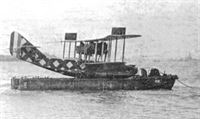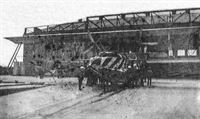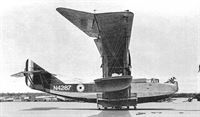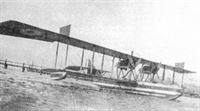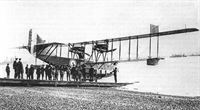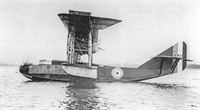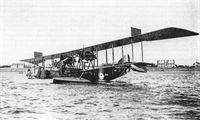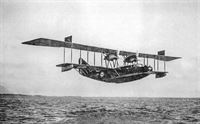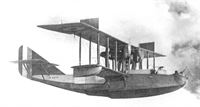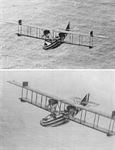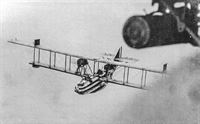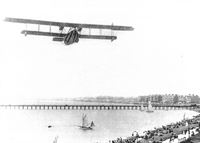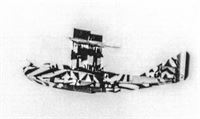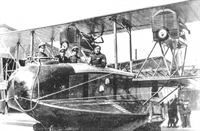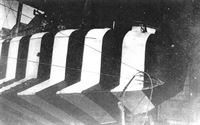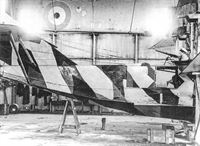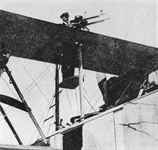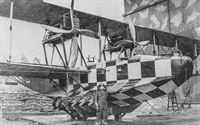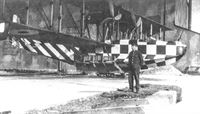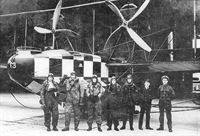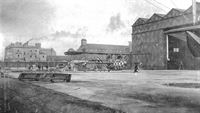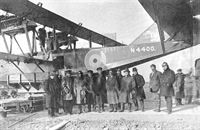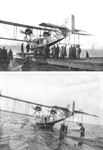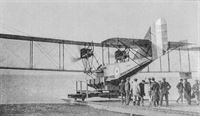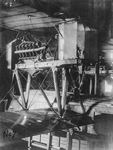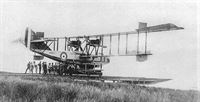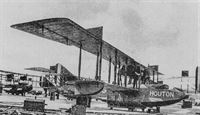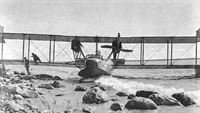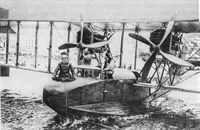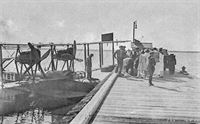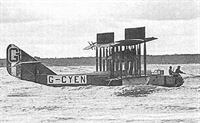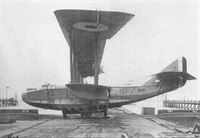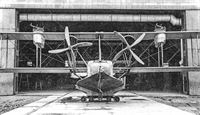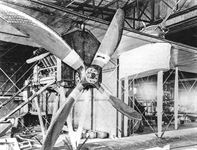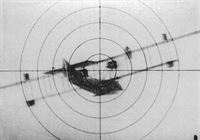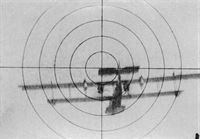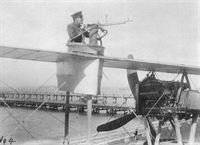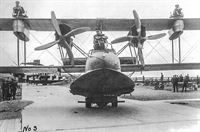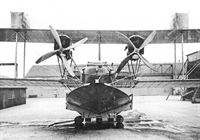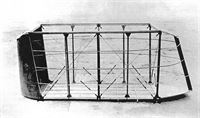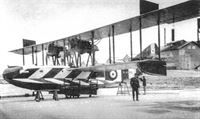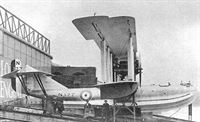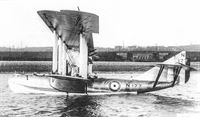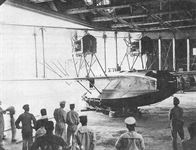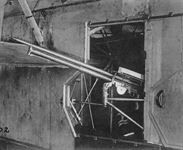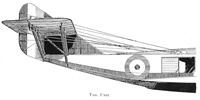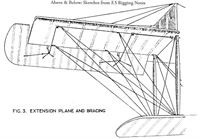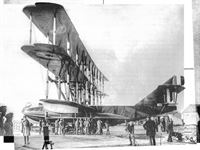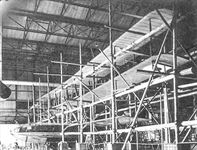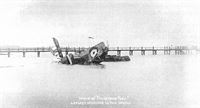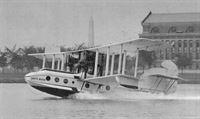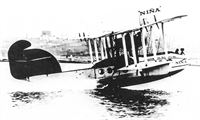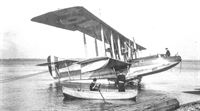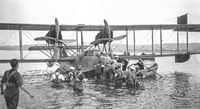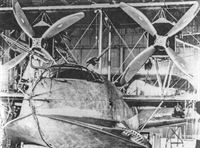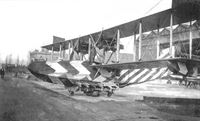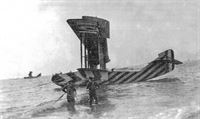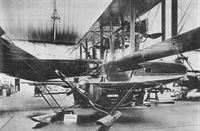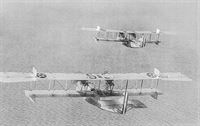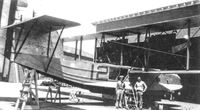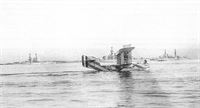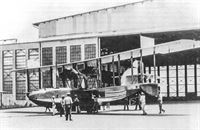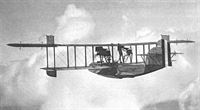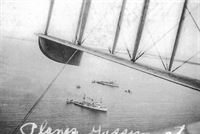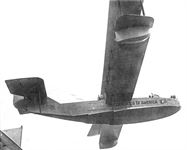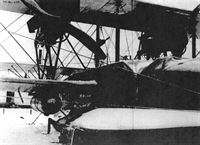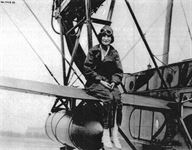Книги
Centennial Perspective
C.Owers
The Fighting America Flying Boats of WWI Vol.2
400
C.Owers - The Fighting America Flying Boats of WWI Vol.2 /Centennial Perspective/ (23)
The war over the North Sea did not get the same coverage as that on the Western Front in the pulp magazines between the wars. Here is a sketch from the story "Raiders of the North Sea" from Air Stories, Vol.4, No.4, April 1937, depicting combat between a dazzle painted Felixstowe boat and Brandenburg monoplanes. The W.29 floatplanes bear the intermediate straight cross national insignia as seen on many and are lining up to attack from astern. The Felixstowe boats would dive for the surface of the sea in order to prevent the enemy from attacking from below where they had poor defence.
6. The America Flying Boats in Detail
Felixstowe F.1
The Felixstowe F.1 was the name given to John Porte’s experimental flying boat that had an experimental Porte designed hull and H-4 aerostructure. The hull was built on aircraft lines with cross braced girder of simple longerons and spacers to which was attached the bottom of the hull. Power was provided by two 150-hp Hispano-Suiza engines.
Unfortunately on test the following result occurred. “On practically smooth water and with no wind, both with the elevator full up and down, the flying boat failed to unstick the tail.”
Specifications
Length hull 36 ft 2 in. Wing Span: Upper 72 ft. Lower 46 ft. Chord 7 ft; Gap 7 ft 6 in. Engines: Two 150-hp Hispano-Suiza.
Felixstowe F.1
The Felixstowe F.1 was the name given to John Porte’s experimental flying boat that had an experimental Porte designed hull and H-4 aerostructure. The hull was built on aircraft lines with cross braced girder of simple longerons and spacers to which was attached the bottom of the hull. Power was provided by two 150-hp Hispano-Suiza engines.
Unfortunately on test the following result occurred. “On practically smooth water and with no wind, both with the elevator full up and down, the flying boat failed to unstick the tail.”
Specifications
Length hull 36 ft 2 in. Wing Span: Upper 72 ft. Lower 46 ft. Chord 7 ft; Gap 7 ft 6 in. Engines: Two 150-hp Hispano-Suiza.
3580 had a new hull built to Porte's method of construction. Initially it has two Anzani radial engines but is shown with two 150-hp Hispano-Suiza engines.This machine became the Porte I, later renamed Felixstowe F.1. It was at the Felixstowe Seaplane School by 29 December 1917, not being written off until early 1919. Note the pitot tube extending from the bow.
With an original caption stating this is also the F.1, this Felixstowe boat has a revised rudder and forward gun ring.
6. The America Flying Boats in Detail
Felixstowe F.2
The evolution of the F.1 and F.2 is described in Chapter 2. 8650 was reported as undergoing overhaul between 14 August and 4 September 1916, and it is likely this is the period it was fitted with the Porte hull. The combination of a new Porte hull with the H-12 wings and a new tail unit led to a better boat that was designated F.2 although it retained the serial 8650. With more powerful engines it was developed as the F.2A.
The F.2A Described
The hull was composed of four longerons with horizontal and vertical spacers braced by diagonals and steel cables. The planning bottom was constructed of two-ply cedar inside and mahogany outside. Varnished or doped fabric was sandwiched between the two layers. The bow, decking and cockpit framework was mahogany while the sides back to the trailing edge of the lower wings was birch plywood. The top of the hull behind the wings was fabric covered to save weight. A 12 inch deep mahogany washboard ran along the lower longerons. The front part of the hull as far back as the rear spar was a rigid built-up structure. From here to the rear the structure was a typical fuselage structure with doped fabric covering above the 12 inch solid mahogany washboard. This was to cause problems, and following the loss of H-16 N4510 on 8 April 1918, in heavy seas, due to the failure of the fabric sides on the tail of the boat, the USN recommended that this defect be corrected on all its H-16 in service. The fabric was to be replaced on some boats with ply sheeting. The fins were built onto the outside of the hull and were planked on the top with three-ply. The hull was double planked. Most WWI built aircraft show variations however the Felixstowe boats show more than others. This was due in part to the different manufacturers of hulls and the aerostructure being allowed considerable latitude and the modifications worked out in active service and applied at stations.
The hull was V-shaped and curved from bow to stern while the tail portion was raised such that it rose clear of the water when at rest. The side fins were built onto the outside of the hull. The planking was double diagonal comprising an inner layer of 1/2 inch cedar and an outer layer of 3/16 inch mahogany, the two with a layer of varnished fabric sandwiched between them. Sliding panels in the hull behind the wings allowed for a Gallows mounting for a Lewis Gun on each side. These could be swung outboard and covered the tail of the boat thus overcoming one of the H-12 defects. A pilot of the F.2A could alight in much rougher seas with less fear that the hull would be damaged, and he could take-off in rougher waters as it did not hammer the water to anything like the extent that the practically flat bottom of an H-12 did. This was despite the F.2A being designed by Porte to utilise the sheltered waters of harbours such as Harwich, the necessities of war calling for more from the boat than its designer intended.
The wings were a typical Curtiss wooden structure and plan form although the F.2A boats had ailerons that projected beyond the wing trailing edge. Late boats had open cockpits and balanced ailerons.
The decision to change from a 23 inch to 20 inch gun ring involved structural alterations and delayed production, the type entering service late in 1917. The number of Large America boats required for the 1918 program was estimated to be 180 in May 1917, and this was revised to 426 with the revised program of July 1917. The average life of the big boats was six months and therefore twice the number of boats was required to meet the estimated establishment figure. The entry of the US into the war and the USN’s agreement to take over and equip five naval air stations provided some relief to the situation as even with the Porte method of construction, it would have been impossible to produce the number of boats required. In March 1918, 161 F.2A and F.3 boats were on order, however only ten F.2A and one F.3 were in service.
The F.2A suffered with problems with its fuel system. The length of piping it contained ran from the main tanks in the hull where wind-driven pumps forced the fuel to the gravity tanks in the top wing centre section. From here the fuel was fed to the carburettors of the Eagle engines.
From about September 1918 all the new F.2A had open cockpits, the canopy being done away with. They were slightly faster as a consequence and the pilots had a better view backwards. The fabric was deleted from the rear of the hull and replaced with Consuta sewn ply. Horn balanced ailerons were introduced making them less tiring to fly. The F.2A had dual control unlike the H-12. The co-pilot’s control wheel folded enabling him to leave his position and access the front gun cockpit.
F.2A Serial Allocation
Serials Number Contract Manufacturer First Delivery Notes
N1260-N1274 15 AS3610 (BR17*) Curtiss, Canada. H-16. Presumed renumbered N4060-N4074.
N2280-N2304 30 AS 14154 (BR80) S.E. Saunders Ltd. Renumbered N4280-N4309.
N2530-N2554 25 AS21558 AMC Ltd. Renumbered N4530-N4554.
N4080-N4099 20 AS14154 S.E. Saunders Ltd. Delivered from late July 1918.
N4280-N4309 30 AS 14154 & AS34426 (BR80) S.E. Saunders Ltd. Delivered from mid-November 1917.
N4430-N4479 50 AS4498/18 (BR349) S.E. Saunders Ltd. 18.10.18 Some delivered as F.5s.
N4480-N4504 25 AS4502/18 (BR350) May, Harding & May 21.09.18 Erected by AMC Ltd. At least 21 delivered.
N4510-N4519 10 AS2697 May, Harding & May 12.01.18 Specification N.3B. Sunbeam engines contemplated for this batch.
N4520-N4529 10 AS24912 (BR74 & BR90) May, Harding & May Cancelled.
N4530-N2554 25 AS21558 May, Harding & May Erected by AMC Ltd?
N4555-N4559 5 AS24912 Cancelled.
N4560-N4579 20 38a/551/C564 & AS24912/18 (BR589) May, Harding & May Last seven cancelled.
The cost of an F.2A including hull and trolley, but without engine and armament was £6,738. Eagle VIII engines cost £1,622.10.00 each.
Felixstowe F.2C
At the 12 June 1917, Meeting of the Air Department Progress Committee, Cdr Longmore reported that the trials of the F.2C were being carried out at Felixstowe. The machine was to go to the Isle of Grain for testing. The F.2C was described as being similar to the H-12 “but has a different hull which is not quite so efficient as a hydroplane and has been found to be considerably better for landing as it has not the same inclination to leave the water again on being landed as the H.12 hulls have.” The F.2C had a hull of lighter construction and greater volumetric size than the F.2A and F.3, its proportions seemingly to anticipate the F.5. The hull had steps of revised design and the forebody’s contours were different from those of the F.2A. The pilot’s occupied an open cockpit. This was due to the fact that they had very little rear view in the canopied H-12 and F.2A rather than the usual answer that pilot’s preferred an open cockpit. The front gunner’s cockpit was farther back from the bow and there were no waist gun positions. Powered initially by two 275-hp Rolls-Royce Eagle II engines, these were later replaced by 322-hp Eagle VI engines. Official performance trials were held on 23 June 1917, and although performance was slightly better than the F.2A, there was no chance of it being placed into production and upsetting the F.2A program that was then underway, only the prototypes N64 and N65 were built.
N64 and N65 were sent to Felixstowe where they joined the War Flight. Porte led a patrol of five flying boats from Felixstowe in N65, his latest experimental boat, on 24 July 1917. His pilot was Queenie Cooper, the test pilot. This was the first time that Felixstowe had been able to field this many boats at once. They spent a long time getting into their correct position for take-off. In future this was to become common and they were got away easily.
Discovering a submarine on the surface, the patrol attacked. Three of the boats dropped bombs, including N65. The other two boats stood by but the submarine appeared to be finished. This submarine was incorrectly reported as UC-1.
While on a Beef Convoy patrol in late September 1917 Pix Hallam and Watson in N65 sighted a submarine and they immediately attacked. The F.2C was equipped “with a gadget for dropping bombs by compressed air, which, according to its proud inventor, was to supersede the good old way of dropping them by pulling a Bowen wire.” Unfortunately a good attack was ruined when the bombs hung up. The device hissed as compressed air escaped but the bombs refused to leave the racks. A nearby destroyer then attacked with depth charges.
N65 was written off after it was holed and sank at the Isle of Grain on 13 March 1918.
N64 was converted into an F.3 about October 1917. It was used for patrols and for experiments.
Felixstowe F.3
The F.3 was designed to meet the need to carry a larger bomb load as the 230-lb bomb was considered no longer satisfactory for attacking submarines. A Progress Committee Report of 12 June 1917, noted that all new “Americas” now on order would be of this type.
The F.3 actually preceded the F.2C. The F.3 had the same large overhang of the upper wing and king-post structure above the interplane struts. Its hull was three feet longer than the F.2A and the wing were of greater span and chord. These differences are not very noticeable in photographs and if the serial is not visible the only way to tell the difference is that the F.3 had a slight recess in the leading edge of the upper wing immediately behind the airscrews.
The F.3 had a typical Porte hull and was planked the same way as the F.2A. The fins were planked with three-ply birch. On later examples double diagonal planking was used. The floors of the F.3 were rebated into the keelson on either side and caused the planking to spring and the boats to leak badly. Intermediate timbers were introduced to try and overcome the problem. Sir A Robinson recalled that on
at least one station, where they often had to be bounced off a long swell, it was found that the planking was apt to open up from the keelson. A new boat on arrival would very probably be dismantled and the petrol tanks removed, to permit a series of oak knees to be put in to strengthen and hold together the bottom planking.
The F.3 could carry four 230-lb bombs while the F.2A could only carry two. This may be the reason that more F.3 boats were ordered than F.2A boats. Lt (later Major) J.D. Rennie was Porte’s Chief Technical Officer at Felixstowe and who assisted him in the development of the successful Felixstowe flying boats stated post-war that the F.3 should never have been put into production.
The prototype, the converted N64, was powered by two 320-hp Sunbeam Cossack engines. Production machines had Rolls-Royce Eagle VIII engines.
The F.2A boats went to Felixstowe, Yarmouth, Dundee, Calshot, and Killingholme, until that latter station was taken over by the USN and they began to receive Curtiss H-16 boats. The F.3 on the other hand went to Cattewater, and the Scillies, and to Houton Bay in the Orkneys. The reason for this was simple. The F.3 used the same Rolls Royce Eagle VIII engines that the F.2A used, was heavier and slower and less manoeuvrable and was unable to engage Zeppelins or German seaplanes. The F.2A went to those stations where reconnaissance and fighting was the most important, while the F.3 with their greater fuel capacity and bomb load went to stations where aerial opposition was less and hunting U-boats was more important.
The first operational flight of a F.3 was in July 1917. The type came in for modifications at the stations as had happened to the F.2A. The tail fabric would be replaced with ply sheeting. Sometimes the double bottom planking was put on the wrong way around so that the water flow was across the outer skin of planking and not along it. The bottom would be removed and replanked, a not infrequent activity according to Sir Austin Robinson.
A report on a Phoenix built boat, N4400, noted that:
1. The mahogany outer planks of the hull bottom aft of the step were buckling outwards, due to swelling. The planks were about 4 1/2 inches wide and were only secured along the joints, no intermediate copper clenched nails being employed.
2. Brass screws were freely used to fix the planking to the heavier framing timbers, and many were sunk too far into the outer planking. They should have been only slightly countersunk.
3. The footsteps were not correctly finished off to prevent water getting into the hull. “These should be boxed up on the inside of the hull to make the hull watertight.”
4. The interplane flying and landing cables were not correctly finished.
5. An elastic adjuster “will be fitted to the cloche for balancing the elevators, to replace the present crude arrangement.”
6. There was a great deal of sway between the hull and the main spars.
The report noted that the defects would be corrected at the station and suggested remedies for some problems.
In October 1918 the Technical Department of the RAF wrote to the Admiralty noting that problems with the hulls of flying boats was due to “lack of sufficient transverse strengthening members and incorrect method of fixing the plank on the bottom hulls.” While modifications had been introduced some three months back great difficulty had been experienced with hulls in store and they had been issued to the various “super-structure Contractors” who were not hull builders and had neither the expertise nor facilities to undertake the modifications required. Lack of accommodation and lack of the necessary facilities to carry out the modification work on stored hulls was blamed for the slow rate of production of modified hulls from store and the issuing of unmodified hulls.
The following report of 23 June 1918, from Houton Seaplane Station captures the problems present in the manufacture and operating of these large flying boats. Houton reported that none of its flying boats were fit for action as follows:
- N4245 Capsized on slipway in strong side wind.
- N4232 Sank on arrival and is being recaulked and fitted for service.
- N4406 Developed leaks in hull after 48 hours on the water. Sent to Houton from Stenness for repairs on 21 June.
- N4235 Sank on arrival and is being recaulked and fitted for service.
- N4403. Driven ashore in gale 13 June, bring repaired.
- N4230. Undergoing its first fitting out on arrival.
These were all F.3 boats. The Station also had Porte Baby 9810 that had been driven ashore in the 13 June gale. It had yet to be floated, a special slipway and cradle were being constructed for that purpose.
This unsatisfactory state was due to:
1. The station not being fully completed for service.
2. The machines being leaky and not ready for service when they arrive.
3. The bad weather in June.
4. A severe epidemic of influenza at Houton.
The majority of men on the station were recruits of one or two months service and had no experience of repairing or handling Large America, seaplanes. Only one shed had been available and that provided accommodation for only one seaplane, and all fitting out and repair of other machines had to be done in the open. Two cases of the aircraft breaking adrift of their moorings were due to the moorings being at fault, however the gale was a sever one and the F.3 boats were larger than the Porte Boat for which the moorings had been designed.
Only one seaplane arrived equipped with W/T. All others had to be wired up by station staff and this took about three weeks.
A Report of 23 May 1917, had noted that the Large America seaplanes had proved most satisfactory for submarine patrol work and large numbers would be used in Home Waters in 1918. The greater part of the establishment of 180, if not the whole output, would be needed for Home. It was considered that it was inevitable that these machines would be required for the Mediterranean, particularly in connection with the Otranto barrage. As this establishment was thought to be the output available from the UK and America, it was proposed that the boats for the Mediterranean be built in Malta under Dockyard control.28 The Air Department Progress Committee had already considered this at its Meeting on 15 May. At this Meeting it was suggested that it might be possible to have the hulls built in Malta and as the Maltese carpenters were expert boat builders, there should be no difficulty in turning out first class hulls. The wings would be built in the UK and shipped out for erection at Malta. All F.2A boats were used in home waters however the F.3 was used extensively in the Mediterranean. The F.3 was to be built in Malta. The local craftsmen were skilled boat-builders and local women did the fabric work.
In November 1917 Malta reported that work on wings for F.3 boats was practically at a standstill. The next day another telegram noted that the two Rolls Royce engines “just received for the first boat” were 345-hp. They also requested a full set of F.3 drawings for the 360-hp Rolls Royce engine. By January 1918 Malta reported that some of the Silver Spruce sent for main spars was defective and required 300 feet run 4 inch planks in 32 feet lengths to be sent by quickest means “to complete 12 boats.” A total of 18 F.3 boats were built in Malta.
The F.3 saw service in the Mediterranean and in September 1918, three F.3 boats flew from Malta to Tripoli where they bombed a wireless station on the Gulf of Sirte suspected of communicating with U-Boats. This operation took place over three or four days. In October the type accompanied the naval attack on Durazzo in Albania.
F.3 Serial Allocation
Serials Number Contract Manufacturer First Delivery Notes
N64 1 BRI 17 Felixstowe NAS Completed as F.2C, converted to F.3.
N1950-N1959 10 AMC Ltd Cancelled.
N2160-N2179 20 AS 11426 (BR22) Handley Page Ltd. Renumbered N2160-N2179.
N2305-N2307 3 BR80 May, Harding & May. Cancelled.
N2310-N2321 12 BR86 Malta Dockyard Renumbered N4310-N4321.
N2400-N2449 50 Bristol & Colonial Aeroplane Ltd Ordered 16.07.17, with 320-hp Rolls Royce engines. Cancelled, serials reallocated.
N4000-N4037 38 Short Bros Ltd. 11.07.18 All delivered. N4019 became G-EAQT.
N4100-N4149 11 38a/1090/C & AS4499/18 Dick, Kerr & Co Ltd. Contract for 11 F.3 & 39 F.5.
N4160-N4179 20 AS 11426; AS30303 & AS30620 (BR22) The Phoenix Dynamo Manufacturing Co Ltd All delivered. N4177 became G-EBDQ.
N4180-N4229 11 AS44496/18 (BR348) The Phoenix Dynamo Manufacturing Co Ltd Contract for 11 F.3 and 39 F.5. F.3 to N4190. N4191 E3 or F.5?
N4230-N4279 50 AS 13823 (BR72) Dick, Kerr & Co Ltd. Dick, Kerr’s first F.3s. N4268- N4273 & N4276-N4277 no record of delivery.
N4310-N4321 12 AS 14835 (BR86) Malta Dockyard. 20.03.18 All delivered from March 1918.
N4360-N4397 38 AS14835 (BR. Adm 1269) Malta Dockyard. 05.09.18 N4388-N4397 cancelled.
N4400-N4429 30 AS30620 (BR199) & AS4496/18 The Phoenix Dynamo Manufacturing Co Ltd. 07.02.18. Grain test.
Note that aircraft were not built in order of serial. Some batches with late serials were completed by a manufacturer before a batch with lower serials that were contracted to the same company.
Experimentation
An interesting experiment saw an F.2A and an F.3 (N4230) equipped with a hydrophone. The machine would alight and drop the hydrophone that was attached to a long rod on the side of the fuselage, into the water. The rod or stream-line strut according to the manual, was held to the hull by a bracket. The forward observer had headphones through which he would listen for the sounds of a submarine under water. Tests were carried out with the submarine C25 and N4230 in May 1918.
In August F.3 N4400 was undertaking trials of the Cooper servo-motor and the Cooper auto-flare night landing device “with new type stick.” A Cooper servo-motor was fitted to the aileron control system of N4400. This was tried with different windmills and that of the two bladed 22 inch diameter and 3 feet 6 inch pitch “was more satisfactory.” It was considered that the time taken to put the ailerons hard over should not exceed 1 1/2 seconds.
The “Stick Night Landing Device” was to give a positive signal to the pilot of the close approach of the surface of the water in time for the pilot to flatten out. A streamlined tapered shaft was mounted on a transverse shaft in the nose of the machine. The shaft could move in and out about a foot. When the spar was out of action it lay horizontally along the fin. In calm weather the device showed promise. A landing was made with the pilot keeping his eyes off the water. The signal to the pilot was considered not as distinct as it should have been. In bumpy weather the stick developed a violent lateral sway and this interfered with the accuracy of the warning and it looked as if the stick would eventually break off the shaft.
Experiments are being tried with a stiffer shaft and a rounded stick instead of streamlined. A streamlined stick of larger dimensions and not so whippy can also be tried. A good deal of experiment and practice will be necessary, but it is hoped that a satisfactory method will be arrived at.
Saunders was given a contract for two experimental F.2A hulls to take standard F.2A wings. The Technical Department report for the fortnight ending 12 June 1918, reported that one hull was finished and would now be fitted with standard F.2A wings and fittings. The following report noted that the progress on the second hull was satisfactory.
The F.3 was declared obsolete in September 1921, the F.2A and F.5 becoming the standard RAF flying boats.
RAF Notes on the “F.2A, V.3 (sic) and F.5 Boat-Seaplanes, Eagle VIII Twin Engines” record that the throttle controls were on the starboard side of the first pilots cockpit on the F.2A and F.3, and the port on the F.5. It was noted that these “controls are not very sensitive owing to the fact that Bowden wire No. 11 is used, and they have a long run.”
The Engineer’s cockpit was situated between the main and rear spars in rear port side of the hull. The engineer had:
(i) Distant reading thermometers for each engine.
(ii) Radiator shutters that could be controlled by the engineer to regulate the temperature of the water.
(iii) A pump for pumping extra water to the radiators. An overflow pipe from the radiators came back to the tank that held about 1 1/2 gallons.
(iv) A Rolls-Royce dope pump with starting magnetos and “change over” switch.
The main fuel tanks were carried in the hull. The petrol system comprised a gravity tank in the upper wing that was kept full by means of a plunger type windmill pump. Petrol could be drawn from any tank by means of the pump and delivered to the gravity tank. Overflow was piped back to the main tanks. A hand plunger pump was fitted in the engineer’s cockpit and used when the machine was at rest or in an emergency when the windmill pump was inoperable.
On 30 November 1918, a trial was conducted with F.5 N86 with an overload of 12,800 lbs, being 1,000 lbs in excess of the
normal load.
With the wind about 8 mph and a smooth sea, a run of 57 seconds was made but the boat showed no signs of hydroplaning and continual heavy streams of spray were going through the airscrews. At the end of the run the starboard engine was vibrating so badly that it could not be run at full speed. Examining the blades of the airscrew it was found that the brass sheathing on the tips had bulged and filled with water causing the airscrew to become unbalanced. It was commented that a machine should be able to take off with at least 30% of normal load. This attitude has been noted in correspondence during the war when it was recorded that the machines would always be loaded with more gear after they entered service due to the demands of that service.
Felixstowe F.5
The prototype F.5, serial N90, appeared in early 1918. It was intended as an improvement over the F.3. A typical Porte construction it embodied a number of refinements. The cockpits were open improving the pilot’s backward view. The top decking of the hull was deeper while the gun positions were the same as the F.3. Aft of the wings the hull sides were fabric covered with a mahogany washboard on the lower half despite the problems with this arrangement on the F.2A. The F.5 hull was regarded as the best of all the Porte hulls. Bomb load was four 230-lb bombs on the underwing racks. The wing was similar to that of the F.2A and F.3 but of longer span and utilised a new aerofoil section and the horn balanced constant chord ailerons were used in place of the inversely tapered ailerons of the earlier boats, tail was essentially the same but the rudder had a balance surface. On official trials with two 350-hp Rolls-Royce Eagle VIII engines driving four-bladed airscrews the prototype, N50, had a better performance than the F.3, even in conditions of overload.
The problem of attaining and keeping aerial supremacy in the North Sea led to many suggestions as to the operation of the Large America flying boats as detailed in the accompanying text. The F.3 was included in these considerations. In July 1917, it was put forward by Cdr Longmore that a twin-engined fighting machine along the lines of the F.2A and F.3 was needed as an escort fighter for the formations of Large Americas operating in the North Sea. This new machine needed to be ready for trials when the new large calibre quick firing guns were ready for testing. The COW Automatic Gun appeared to be most promising. Porte stated that the F.5 that had just been laid down at Felixstowe could be adapted to carry two of these guns. The machine could be ready in about two months and would have a better performance than the F.3. The discussion then went on to consider whether such guns could also be used against submarines and the general opinion was that it was not possible to mount the gun such that it could perform both functions. Documentation that a COW gun was ever carried by an F.5 has not been discovered.
Unfortunately the Ministry of Munitions decided on economic grounds not to introduce the new type. The Ministry did not want to supply new jigs and templates now that the production of the F.3 was well underway, and so a compromise was reached. The production F.5 used a hull similar to the prototype but with as many F.3 components as possible and was planked overall. While a very strong hull it was appreciably heavier than that of N90. The F.5 wing was virtually identical with the F.3 wing reverting to the same RAF 14 aerofoil. The F.5 did have horn balanced ailerons of constant chord. Performance of the production model with Rolls Royce Eagle VII engines was inferior to that of the prototype. The Eagle VII was used as Eagle VIII engines were in short supply but this was not the only reason that the production machines were inferior to the prototype.
Like N90 the F.5 had a balanced rudder and later horn-balanced elevators. The F.5 had a typical Porte type hull with the lower centre section integral with the hull. The upper centre section was supported by two struts, one pair placed on the centre-line of the boat. The cabane struts supporting the engines were also attached to the upper and lower centre section planes. Considerable difficulty was experienced in removing the engines once the planes were in position as it was impossible to get a direct lift on them. Air Commodore Samson noting that “replacing an engine is not an easy job without getting the boat ashore, as of course in an ‘F.2.A.’ you have to remove the planes.” The Rigging Notes for the F.5 noted that “whenever the planes are dismantled advantage should be taken of the opportunity to overhaul the engines.”
The F.5 had flown before there were any tank test results. Maj J.D. Rennie recorded that the positions of the steps on the F.5 by Porte were the result of a great deal of practical experience in takeoff and landing boats in varying weather and sea conditions. Just before the Armistice work was put in hand to fit steps to the F.5 in accordance with tank test results but the work stopped due to demobilisation of staff.
Rennie then went on to state that the F.5 was never put into production, which was a great blunder on the part of the Production Dept, Ministry of Munitions. Instead, the F.3 wing structure, the weight considerably increased to facilitate production, and adapters fitted to take either streamline wires or stranded cables, also permanent slinging gear incorporated, was fitted to a mongrel hull, a cross between the F.5 and the F.3, and the resultant boat was called the F.5. This was done solely because the F.3 was already in production (it never should have been), and the Ministry of Munitions were against a further change as jigs, templates, etc., were already made for the F.3.
In August 1918 it was noted that a further batch of F.5 drawings were received from Dick Kerr that have been traced and included with the official set for issuing to contractors. The set of drawings for this machine were now near completion. It was recorded in January 1919 that the pulley bracket had been modified on as the controls were impossible to work with the present arrangement. Also that owing to the “present military situation” Liberty engines would not be installed in the F.5. Too late to be used operationally in the war, the F.5, along with the F.2A, became the RAF’s standard flying boat post-war until replaced by the Supermarine Southampton in August 1925.
F.5 Serial Allocation
Serials Number Contract Manufacturer Notes
N90 1 Felixstowe NAS. Prototype.
N128 F-5L ordered from USA post-war.
N177 1 Short Bros Ltd Metal hull with E5 aerostructure.*
N178 1 SE Saunders Ltd. Hollow hull with F.5 aerostructure*.
N4038-N4049 12 AS32421 Short Bros Ltd.
N4112-N4149 39 38a/1090/C & AS4499/18 (BR347) Dick Kerr & Co Original contract for 18 F.3 then 32 F.5, but F.3 to N4111 only. N4125-N4149 (10), cancelled?
N4192-N4229 39 AS4496/18 (BR348) The Phoenix Dynamo Manufacturing Co Ltd. Original Contract for 11 F.3 and 39 F.5. N4201-N4229 cancelled, but 10 superstructures completed & delivered.
N4580-N4629 50 38a/550/C563 &AS224911/18 (BR590) SE Saunders Ltd. N4580-N4589 no evidence. N4590-N4629 cancelled post-Armistice.
N4630-N4679 50 38a/552/C565 & AS24910/18. Gosport Aviation Co Ltd. N4640-N4679 Cancelled. N4634 became G-EAIK.
N4680-N4729 50 38a/599/C627 & A26345/18 (BR620) May, Harding & May. Cancelled December 1918.
N4730-N4779 50 38a/604/C633 & AS26344/18 (BR621) Dick Kerr & Co. To have Liberty engines. Cancelled December 1918.
N4780-N4829 50 38a/598/C628 & AS26343/18 (BR622) Phoenix Dynamo Co. Cancelled December 1918.
N4830-N4879 50 38a/600/C629 & AS26368/18 (BR623) Short Bros Ltd. N4880-N4879. Cancelled post Armistice.
* Robertson defines N177 and N178 as a basic F-5
Experiments
There were many experiments carried out on the America boats and some are referred to under the various type histories. One proposal was for the fitting of folding wings to the Large America boats. Handley Page had experience in folding wings on large aircraft such as the O/100, and had been approached to make folding wings for the flying boats to allow more hangar space. In September 1917, it was noted that difficulties had been found owing to one of the interplane struts fouling the tail when folded. Handley Page “could only get the folding dimensions down to 43 feet. If he could be allowed to space the engines out to 18 feet instead of the present 10 feet, he could reduce the folded dimensions to 35 feet. Although the spacing of 43 feet was considered adequate as it would allow for the machines to be hangared in a Bessoneau hangar, this project never came to a satisfactory conclusion. The company had received further orders for their bombers and were devoting their energies towards this instead of getting on with the seaplane work that they already had in hand.
Another interesting experiment concerned a set of Le Vaillant Speaking Tubes that were fitted to F.3 N4409. Several flights of from 314 to 414 hours were carried out. While it was found that a conversation could be easily carried out even with the engines running full out, there were disadvantages. The weight of the observer’s tubes caused a strain on his neck as a considerable length of tube had to be allowed for his movements around the cockpit. The gun ring could not be operated as the tubes caught up on various objects. “The apparatus would be of no use during an action.” The pilot was not inconvenienced to any extent with the tubes permanently attached to his helmet as the tubes were capable of being supported and he did not have to move about. They were not adopted for service us.
Around May 1919, a production F.5 made an endurance flight of 14 hours 8 minutes from Felixstowe. The crew was Capt Scott, as pilot, Capt Dickey, as navigator and two mechanics. No attempt was made to alight until the Eagle VIII engines stopped from lack of fuel. The total weight of the machine with crew was 13,710 lbs of which 150 lbs was water shipped in the choppy sea before takeoff. The average speed was 55 knots and wireless communication with Felixstowe was maintained throughout the flight.
Post-war the F.5 took part in many experiments. In early 1921 N4040 was fitted with a modified rudder with top balance, and tested against N4838 with the standard rudder to ascertain whether the standard F.5 rudder “was overbalanced and liable to take charge.” N4040 was flown by Flt Lt E.S. Goodwin with Wing Cmdr H.R. Busteed and Flt Lt D.E Lucking as observers. Unfortunately trials were not completed owing to engine trouble. Later flights were no more successful due to bumpy conditions. The lack of instrumentation to detect and record results was probably the reason that no recommendations were made.
In another experiment N4839 was fitted with two 450-hp Napier Lion engines. In Report MN271 of 16 August 1922, the test pilot, Flt Lt C.B. Dalison, AFC, recorded that the
seaplane is very nose heavy on climb but trims at nearly full throttle flying level low down at about 78 knots and 2000 r.p.m., under which conditions it flies “hands off’. The above with the maker’s tail setting.
To the rest of remarks regarding Stability and, Controllability and Manoeuvrability, the Report notes all “As Eagle 8.F.5.” No bombs could be carried externally due to position of docking chocks. It was considered that the poor performance was partly due to the excessive radiator size and the Vickers Vernon airscrews used for the test. “The engines are overloaded by the Vickers Vernon propellers.” It was considered that the “improvement in performance over that of the standard Eagle 8.F.5. is so far inconsiderable that no useful purpose would appear to be served by the present conversion scheme.”
There were two special F-boats. N178, that featured a deep Saunders hollow-bottom hull. This machine has standard F.5 wings rigged with a slight stagger. N177 followed with an all metal hull by Short Brothers and known by that firm as their S.2. The hull was an early metal monocoque and proved its strength when the machine was stalled into rough water from about 30 feet and remained undamaged and watertight.
Post-War
The British were anxious to catch as much of the post-war civil and military market as they could. Their main rival was France as the Germany aviation industry was hamstrung by the Allies. Two F.5 boats, N4041 and N4044, set out from Felixstowe on 11 July 1919. N4044 made a round Scandinavia flight of 2,450 sea miles in a flying time of 40 hours 40 minutes as a “demonstration of the commercial uses of flying-boats.” The flight was noteworthy that in the 27 days no kind of trouble was experienced and the low-compression Rolls-Royce Eagle VIII engines ‘worked magnificently throughout.” The flight took in Norway, Denmark and Sweden.
The ELTA Exhibition at Amsterdam in 1919 was to be a showpiece for aviation, especially civil aviation. Aircraft companies from all over Europe presented their products at the exhibition and passenger flights introduced the new method of transportation to the public.
Gosport built F.5 N4634 flown by Lt-Col Ralph Hope Vere was the first F-boat to attend the exhibition. Banned from flying by the British Air Ministry N4634 was only available to invited guests and was not available to the general public. To highlight the British presence Sir Fredrick Sykes, the Controller General of Civil Aviation, arrived with five RAF F.5 flying boats at the naval air station of Schellingwoude on 12 August. These flying boats returned to Britain the next day. F.2A boats N4439 and N4441 were flown to Holland for the ELTA exhibition with N4441 also giving demonstration flights. These two F.2A boats were presented as Vickers exhibits as S.E. Saunders had been taken over by Vickers.
Canada
Canada received eleven F.3 flying boats as part of the Imperial Gift of 1919. They were given civil registrations G-CYBT (N4016); G-CYDH (ex-N4009); G-CYDI (ex-N4010); G-CYDJ (ex-N4011); G-CYDQ(ex-N4014); G-CYEN (ex-N4015); G-CYEO (ex-N4181); and also N4012, N4013, N4178 and N4179 that did not receive civil registrations but were held as spares. A single Curtiss H-16 N4905 (G-CYEP) was included in the Gift but two ended up in Canada. The second was N4902 that was not registered and apparently used for spares. The US Government also gave the Canadians a number of Curtiss HS-2L flying boats that had operated from Nova Scotia during the war.
The flying boats were used for summer patrols over areas where forest fires could break out. By 1922 all the Canadian aircraft were worn out and had not been reconditioned. The last F.3 was withdrawn in 1923, their replacement was the Vickers Vedette that was designed for Canadian conditions and built in Canada by Canadian Vickers at Montreal.
Chile
The Chilean Navy acquired an assortment of British aircraft after the war as payment for the Chilean ships that were under construction in Britain at the declaration of war and were taken over by the British. Sopwith Baby and Short 184 seaplanes were received followed in 1920 by a single F.2A (ex-N4567). This boat had open cockpits and balanced ailerons. Commissioned on 17 October 1921, when it was christened with the name “Guardiamarina Zanartu” after the first naval pilot. It was replaced by the Dornier Wai in 1926 and made its last flight on 15 February 1928.
Japan
The Master of Sempill s British Naval Air Mission to Japan saw British aircraft purchased for use by the Japanese Navy. Before their arrival in April 1921, a small number of Avros and F.5 boats were ordered by Japan. The ten F.5 boats came from Short Brothers. The first to be erected was launched and flown on 30 August 1921, by John Parker. The F.5 “proved a valuable asset to the work of the Mission” and a number of long distance flights were made by trainees. It was the practice to finish each course with a cruise around the shores of Japan. The distance was usually over 1,500 miles and these took more than 9 hours to complete in stages, the longest stage usually being about 500 miles.
The F.5 was to be built in Japan, Short Brothers sending 20 personnel under engineer Dodds to Japan, the contingent arriving in April 1921. They worked at the Yokosuka Arsenals Ordnance Department. The Arsenal erected the imported F.5 boats with the first taking to the water in April 1921. British sources state that in 1922 three Short-built F.5 boats with Napier Lion engines were obtained from Britain.
An US intelligence report noted in March 1923 that two F-5 flying boats had just been completed at Yokosuka for the Naval Air Service at Sasebo. The aircraft were serialled 51 and 57. The first F.5 constructed entirely of local materials was built at the Hiro Naval Arsenal with assistance of Short Brothers personnel. Later some 50 E5 boats were built by the Aichi Tokei Denki Co of Nagoya. In 1925 the Hiro Arsenal powered an F.5 with licence-built 400-hp Lorraine engines, followed by another with 450-hp Lorraines. Designated F.1 and F.2, they were not selected for production as it was realised that the F.5 was outdated. Ten were built by the Hiro Naval Arsenal (Hiro Kaigun Kosho), ten by the Yokosuka Arsenal and forty by Aichi. Several impressive long-distance flights were made by the Japanese F.5 boats, some over nine hours. Some survived still in service in 1929. A report from the Naval Attache, Tokyo, on 18 January 1929, stated that 16 F-5 boats were in first line service with 6 in reserve. Although the type had a good history of service there were also many accidents mainly due to improper maintenance, engine problems and bad weather. Japan was to go on and build some of the best flying boats in the world culminating in the mighty Kawanishi H8K “Emily” of WWII fame.
Australia
Australia sought to obtain Short F.5 flying boats and the serial sequence A11 was allocated to the proposed boats but financial concerns led to the purchase being abandoned. Two wooden hulled Supermarine Southamptons were eventually obtained and they took up the A11 serial prefix.
Netherlands
As related in the text N4551 fell into the Netherlands hands. A number of Large America flying boats ended up in the Netherlands commencing with H-12 8693. This boat was delivered to Felixstowe on 3 June 1917, and was forced down due to engine failure on the 24th the following October. The Dutch torpedo boat G15 found the boat anchored in the Deurloo. The crew of Flt Lt H.C. Gooch, LM C.W. Sivyer and 2AM B.M. Millichamp were taken on board the torpedo boat whereupon the flying boat sank. Sources vary as to the fate of this machine with British sources saying the crew sank the boat, which appears to be most likely, while there is a suggestion in Dutch sources that there may have been a partial salvage of the machine.
Curtiss H-12 Convert 8689 was shot down by Germans and force to alight off the northern tip of the island of Vlieland on 4 June 1918. The machine managed to be run aground but before the crew could set the machine on fire they were prevented by the coast guard stationed on the island. The crew were all interned and the boat was impressed in the MLD as L.1. This day also saw Capt Dickeys F.2A N4533 shot up and set on fire on the water after alighting in Netherlands waters.
On 2 October 1918, F.2A N4551 of No.232 Squadron, RAF, was one of a flight of seven that flew along the Dutch coast within the Dutch territorial waters and were fired on by coastal batteries. Forced to alight, the boat was beached at Noordwijk. The crew were prevented from setting the boat on fire. This F.2A was taken into MLD service as L 2. According to a contemporary report three Canadian and two British men comprised the crew (Lt J.C. Stockman, 2/Lt T.N. Enright, 2/Lt W. Pendleton, 1AM H.L. Curtiss, and 3AM W.A. Mitchell). All were interned. Lt Stockman was injured in the incident, the rest were unhurt.
Portugal
In May 1920 two F.3 boats were reconditioned by Fairey Aviation Co Ltd at Hamble before being flown to Lisbon for the Servico de Avica (Naval Aeronautical Service). They were in service until 1922. One was used for the first flight from Lisbon to Funchal on Maderia Island in 1921. This 7 hour 40 minute flight was captained by Cdr Sacadura Cabral, with Capt Gago Coutinho as navigator. Cabral had flown the first of the boats from the UK to Lisbon. Coutinho was over 60 years of age and a well qualified navigator. This flight served to give them experience in navigation for the proposed first South Atlantic crossing the following year in a Fairy IIID.
Spain
When the Riff War began in Spanish Morocco the Army and Naval air service were poorly equipped and there was a rush to acquire new equipment. The Army purchased Bristol Fighters, De Havilland 9 and 9A bombers from the ADC. Although the war was mainly an Army affair, the Navy purchased 11 Felixstowe flying boats, variously referred to as F.3 and F.5 models from the ADC. Photographs show a cockpit canopy which would confirm that they were the F.3 model. They were erected, inspected, crated and shipped to Spain. As facilities were not available for their operation, the wings and tail sections were stored ashore while the hulls were placed on the davits of two old warships in Barcelona harbour, exposed to the sun and dew, a treatment for which they had not been designed. The first boat was wrecked while attached to its trolley in a gale the night before it was due to fly for the first time. For the story how they were brought into service see Norman Macmillans Freelance Pilot, Heinemann, London, 1937.
Post-War Civil
The Gosport Aviation Co on the Solent was building the F.5 and, according to H. Penrose, Porte had announced that he would be willing to join the company after the end of the war. Flight for 15 December 1919, devoted an article - “Some Gosport Flying Boats for 1920” to the company’s proposals. The article noted that the late John Porte had joined the company in August 1919 as Chief Designer, and had produced several designs based on his successful types in the late War modified to suit commercial requirements. The types are illustrated by drawings and their Felixstowe lineage can be clearly seen. The G.9 was a triplane flying boat based on the Fury and featuring the 600-hp Rolls Royce Condor engines that were to have originally powered the Fury. They were arranged with the two outboard engines as tractors and the central one as a pusher.
With his death on 22 October 1919, at only 35 years of age, Porte’s ideas for civilian versions of the F-boats died with him. Not one Gosport design was ever built. The North Atlantic was conquered by a flying boat in 1919 before he died. This was the USN NC-4, a design that was radically different from those designed by Porte, but one which he would have been aware of given the constant communication between Felixstowe, Curtiss and the USN. This is not to say that the Porte boats had no influence on civil aviation.
Major W.T Blake departed Croydon in a modified D.H.9 G-EBDE in an attempt to fly around the world on 25 May 1922. The original D.H.9 was lost in a crash and he continued his abortive world flight in a variety of aircraft. F.3 G-EBDQ was reportedly shipped to Canada for this part of his trip but was not used and later sold in Canada in 1922.
Short Brothers Ltd had hoped to sell their F.3 and F.5 boats on the civilian market but had to compete with the low prices from the Aircraft Disposal Co (ADC). In their advertisements Shorts offered their F.3 as an adaption of this machine for passenger work that turned it into a luxurious yacht. A cabin space 9 ft x 4 ft 6 in was fitted out as a lounge for four to six persons. If less comfort and luxury was required then a greater number of passengers could be carried. Two machines ended up on the British civil register as G-EAQT (ex-N4019) and G-EBDQ (ex-N4177), the latter, Blake’s machine, referred to above.
G-EAQT was converted to an air-yacht by Shorts and flew in this form on 28 May 1920. Lebbeus Hordern imported G-EAQT to Australia together with spare parts. In Australian documents it is referred to as a Short F.5 flying boat. The hull was launched but the machine was never erected. In 1923 the Superintendent of Aircraft received a report on the machine. The wings were still in their packing case. The hull was thought to require a considerable amount of repair before the machine would be considered airworthy as all the joints had opened up and the timber had warped badly. Hordern later donated the two Eagle VIII engines to the RAAF in 1927. According to legend the hull became a shelter for fishermen. The British registration had been cancelled in January 1921.
Some sources quote two F.3 boats used for an aerial service in Tasmania but no such service existed.
The Aircraft Disposal Co was still able to offer the following airworthy aircraft for sale in 1924:
Felixstowe F.3, Martinsyde F.4, D.H.9 and 9A, Bristol F.2B, Sopwith Snipe, Avro 504K and Parnall Panther.
Felixstowe F.2
The evolution of the F.1 and F.2 is described in Chapter 2. 8650 was reported as undergoing overhaul between 14 August and 4 September 1916, and it is likely this is the period it was fitted with the Porte hull. The combination of a new Porte hull with the H-12 wings and a new tail unit led to a better boat that was designated F.2 although it retained the serial 8650. With more powerful engines it was developed as the F.2A.
The F.2A Described
The hull was composed of four longerons with horizontal and vertical spacers braced by diagonals and steel cables. The planning bottom was constructed of two-ply cedar inside and mahogany outside. Varnished or doped fabric was sandwiched between the two layers. The bow, decking and cockpit framework was mahogany while the sides back to the trailing edge of the lower wings was birch plywood. The top of the hull behind the wings was fabric covered to save weight. A 12 inch deep mahogany washboard ran along the lower longerons. The front part of the hull as far back as the rear spar was a rigid built-up structure. From here to the rear the structure was a typical fuselage structure with doped fabric covering above the 12 inch solid mahogany washboard. This was to cause problems, and following the loss of H-16 N4510 on 8 April 1918, in heavy seas, due to the failure of the fabric sides on the tail of the boat, the USN recommended that this defect be corrected on all its H-16 in service. The fabric was to be replaced on some boats with ply sheeting. The fins were built onto the outside of the hull and were planked on the top with three-ply. The hull was double planked. Most WWI built aircraft show variations however the Felixstowe boats show more than others. This was due in part to the different manufacturers of hulls and the aerostructure being allowed considerable latitude and the modifications worked out in active service and applied at stations.
The hull was V-shaped and curved from bow to stern while the tail portion was raised such that it rose clear of the water when at rest. The side fins were built onto the outside of the hull. The planking was double diagonal comprising an inner layer of 1/2 inch cedar and an outer layer of 3/16 inch mahogany, the two with a layer of varnished fabric sandwiched between them. Sliding panels in the hull behind the wings allowed for a Gallows mounting for a Lewis Gun on each side. These could be swung outboard and covered the tail of the boat thus overcoming one of the H-12 defects. A pilot of the F.2A could alight in much rougher seas with less fear that the hull would be damaged, and he could take-off in rougher waters as it did not hammer the water to anything like the extent that the practically flat bottom of an H-12 did. This was despite the F.2A being designed by Porte to utilise the sheltered waters of harbours such as Harwich, the necessities of war calling for more from the boat than its designer intended.
The wings were a typical Curtiss wooden structure and plan form although the F.2A boats had ailerons that projected beyond the wing trailing edge. Late boats had open cockpits and balanced ailerons.
The decision to change from a 23 inch to 20 inch gun ring involved structural alterations and delayed production, the type entering service late in 1917. The number of Large America boats required for the 1918 program was estimated to be 180 in May 1917, and this was revised to 426 with the revised program of July 1917. The average life of the big boats was six months and therefore twice the number of boats was required to meet the estimated establishment figure. The entry of the US into the war and the USN’s agreement to take over and equip five naval air stations provided some relief to the situation as even with the Porte method of construction, it would have been impossible to produce the number of boats required. In March 1918, 161 F.2A and F.3 boats were on order, however only ten F.2A and one F.3 were in service.
The F.2A suffered with problems with its fuel system. The length of piping it contained ran from the main tanks in the hull where wind-driven pumps forced the fuel to the gravity tanks in the top wing centre section. From here the fuel was fed to the carburettors of the Eagle engines.
From about September 1918 all the new F.2A had open cockpits, the canopy being done away with. They were slightly faster as a consequence and the pilots had a better view backwards. The fabric was deleted from the rear of the hull and replaced with Consuta sewn ply. Horn balanced ailerons were introduced making them less tiring to fly. The F.2A had dual control unlike the H-12. The co-pilot’s control wheel folded enabling him to leave his position and access the front gun cockpit.
F.2A Serial Allocation
Serials Number Contract Manufacturer First Delivery Notes
N1260-N1274 15 AS3610 (BR17*) Curtiss, Canada. H-16. Presumed renumbered N4060-N4074.
N2280-N2304 30 AS 14154 (BR80) S.E. Saunders Ltd. Renumbered N4280-N4309.
N2530-N2554 25 AS21558 AMC Ltd. Renumbered N4530-N4554.
N4080-N4099 20 AS14154 S.E. Saunders Ltd. Delivered from late July 1918.
N4280-N4309 30 AS 14154 & AS34426 (BR80) S.E. Saunders Ltd. Delivered from mid-November 1917.
N4430-N4479 50 AS4498/18 (BR349) S.E. Saunders Ltd. 18.10.18 Some delivered as F.5s.
N4480-N4504 25 AS4502/18 (BR350) May, Harding & May 21.09.18 Erected by AMC Ltd. At least 21 delivered.
N4510-N4519 10 AS2697 May, Harding & May 12.01.18 Specification N.3B. Sunbeam engines contemplated for this batch.
N4520-N4529 10 AS24912 (BR74 & BR90) May, Harding & May Cancelled.
N4530-N2554 25 AS21558 May, Harding & May Erected by AMC Ltd?
N4555-N4559 5 AS24912 Cancelled.
N4560-N4579 20 38a/551/C564 & AS24912/18 (BR589) May, Harding & May Last seven cancelled.
The cost of an F.2A including hull and trolley, but without engine and armament was £6,738. Eagle VIII engines cost £1,622.10.00 each.
Felixstowe F.2C
At the 12 June 1917, Meeting of the Air Department Progress Committee, Cdr Longmore reported that the trials of the F.2C were being carried out at Felixstowe. The machine was to go to the Isle of Grain for testing. The F.2C was described as being similar to the H-12 “but has a different hull which is not quite so efficient as a hydroplane and has been found to be considerably better for landing as it has not the same inclination to leave the water again on being landed as the H.12 hulls have.” The F.2C had a hull of lighter construction and greater volumetric size than the F.2A and F.3, its proportions seemingly to anticipate the F.5. The hull had steps of revised design and the forebody’s contours were different from those of the F.2A. The pilot’s occupied an open cockpit. This was due to the fact that they had very little rear view in the canopied H-12 and F.2A rather than the usual answer that pilot’s preferred an open cockpit. The front gunner’s cockpit was farther back from the bow and there were no waist gun positions. Powered initially by two 275-hp Rolls-Royce Eagle II engines, these were later replaced by 322-hp Eagle VI engines. Official performance trials were held on 23 June 1917, and although performance was slightly better than the F.2A, there was no chance of it being placed into production and upsetting the F.2A program that was then underway, only the prototypes N64 and N65 were built.
N64 and N65 were sent to Felixstowe where they joined the War Flight. Porte led a patrol of five flying boats from Felixstowe in N65, his latest experimental boat, on 24 July 1917. His pilot was Queenie Cooper, the test pilot. This was the first time that Felixstowe had been able to field this many boats at once. They spent a long time getting into their correct position for take-off. In future this was to become common and they were got away easily.
Discovering a submarine on the surface, the patrol attacked. Three of the boats dropped bombs, including N65. The other two boats stood by but the submarine appeared to be finished. This submarine was incorrectly reported as UC-1.
While on a Beef Convoy patrol in late September 1917 Pix Hallam and Watson in N65 sighted a submarine and they immediately attacked. The F.2C was equipped “with a gadget for dropping bombs by compressed air, which, according to its proud inventor, was to supersede the good old way of dropping them by pulling a Bowen wire.” Unfortunately a good attack was ruined when the bombs hung up. The device hissed as compressed air escaped but the bombs refused to leave the racks. A nearby destroyer then attacked with depth charges.
N65 was written off after it was holed and sank at the Isle of Grain on 13 March 1918.
N64 was converted into an F.3 about October 1917. It was used for patrols and for experiments.
Felixstowe F.3
The F.3 was designed to meet the need to carry a larger bomb load as the 230-lb bomb was considered no longer satisfactory for attacking submarines. A Progress Committee Report of 12 June 1917, noted that all new “Americas” now on order would be of this type.
The F.3 actually preceded the F.2C. The F.3 had the same large overhang of the upper wing and king-post structure above the interplane struts. Its hull was three feet longer than the F.2A and the wing were of greater span and chord. These differences are not very noticeable in photographs and if the serial is not visible the only way to tell the difference is that the F.3 had a slight recess in the leading edge of the upper wing immediately behind the airscrews.
The F.3 had a typical Porte hull and was planked the same way as the F.2A. The fins were planked with three-ply birch. On later examples double diagonal planking was used. The floors of the F.3 were rebated into the keelson on either side and caused the planking to spring and the boats to leak badly. Intermediate timbers were introduced to try and overcome the problem. Sir A Robinson recalled that on
at least one station, where they often had to be bounced off a long swell, it was found that the planking was apt to open up from the keelson. A new boat on arrival would very probably be dismantled and the petrol tanks removed, to permit a series of oak knees to be put in to strengthen and hold together the bottom planking.
The F.3 could carry four 230-lb bombs while the F.2A could only carry two. This may be the reason that more F.3 boats were ordered than F.2A boats. Lt (later Major) J.D. Rennie was Porte’s Chief Technical Officer at Felixstowe and who assisted him in the development of the successful Felixstowe flying boats stated post-war that the F.3 should never have been put into production.
The prototype, the converted N64, was powered by two 320-hp Sunbeam Cossack engines. Production machines had Rolls-Royce Eagle VIII engines.
The F.2A boats went to Felixstowe, Yarmouth, Dundee, Calshot, and Killingholme, until that latter station was taken over by the USN and they began to receive Curtiss H-16 boats. The F.3 on the other hand went to Cattewater, and the Scillies, and to Houton Bay in the Orkneys. The reason for this was simple. The F.3 used the same Rolls Royce Eagle VIII engines that the F.2A used, was heavier and slower and less manoeuvrable and was unable to engage Zeppelins or German seaplanes. The F.2A went to those stations where reconnaissance and fighting was the most important, while the F.3 with their greater fuel capacity and bomb load went to stations where aerial opposition was less and hunting U-boats was more important.
The first operational flight of a F.3 was in July 1917. The type came in for modifications at the stations as had happened to the F.2A. The tail fabric would be replaced with ply sheeting. Sometimes the double bottom planking was put on the wrong way around so that the water flow was across the outer skin of planking and not along it. The bottom would be removed and replanked, a not infrequent activity according to Sir Austin Robinson.
A report on a Phoenix built boat, N4400, noted that:
1. The mahogany outer planks of the hull bottom aft of the step were buckling outwards, due to swelling. The planks were about 4 1/2 inches wide and were only secured along the joints, no intermediate copper clenched nails being employed.
2. Brass screws were freely used to fix the planking to the heavier framing timbers, and many were sunk too far into the outer planking. They should have been only slightly countersunk.
3. The footsteps were not correctly finished off to prevent water getting into the hull. “These should be boxed up on the inside of the hull to make the hull watertight.”
4. The interplane flying and landing cables were not correctly finished.
5. An elastic adjuster “will be fitted to the cloche for balancing the elevators, to replace the present crude arrangement.”
6. There was a great deal of sway between the hull and the main spars.
The report noted that the defects would be corrected at the station and suggested remedies for some problems.
In October 1918 the Technical Department of the RAF wrote to the Admiralty noting that problems with the hulls of flying boats was due to “lack of sufficient transverse strengthening members and incorrect method of fixing the plank on the bottom hulls.” While modifications had been introduced some three months back great difficulty had been experienced with hulls in store and they had been issued to the various “super-structure Contractors” who were not hull builders and had neither the expertise nor facilities to undertake the modifications required. Lack of accommodation and lack of the necessary facilities to carry out the modification work on stored hulls was blamed for the slow rate of production of modified hulls from store and the issuing of unmodified hulls.
The following report of 23 June 1918, from Houton Seaplane Station captures the problems present in the manufacture and operating of these large flying boats. Houton reported that none of its flying boats were fit for action as follows:
- N4245 Capsized on slipway in strong side wind.
- N4232 Sank on arrival and is being recaulked and fitted for service.
- N4406 Developed leaks in hull after 48 hours on the water. Sent to Houton from Stenness for repairs on 21 June.
- N4235 Sank on arrival and is being recaulked and fitted for service.
- N4403. Driven ashore in gale 13 June, bring repaired.
- N4230. Undergoing its first fitting out on arrival.
These were all F.3 boats. The Station also had Porte Baby 9810 that had been driven ashore in the 13 June gale. It had yet to be floated, a special slipway and cradle were being constructed for that purpose.
This unsatisfactory state was due to:
1. The station not being fully completed for service.
2. The machines being leaky and not ready for service when they arrive.
3. The bad weather in June.
4. A severe epidemic of influenza at Houton.
The majority of men on the station were recruits of one or two months service and had no experience of repairing or handling Large America, seaplanes. Only one shed had been available and that provided accommodation for only one seaplane, and all fitting out and repair of other machines had to be done in the open. Two cases of the aircraft breaking adrift of their moorings were due to the moorings being at fault, however the gale was a sever one and the F.3 boats were larger than the Porte Boat for which the moorings had been designed.
Only one seaplane arrived equipped with W/T. All others had to be wired up by station staff and this took about three weeks.
A Report of 23 May 1917, had noted that the Large America seaplanes had proved most satisfactory for submarine patrol work and large numbers would be used in Home Waters in 1918. The greater part of the establishment of 180, if not the whole output, would be needed for Home. It was considered that it was inevitable that these machines would be required for the Mediterranean, particularly in connection with the Otranto barrage. As this establishment was thought to be the output available from the UK and America, it was proposed that the boats for the Mediterranean be built in Malta under Dockyard control.28 The Air Department Progress Committee had already considered this at its Meeting on 15 May. At this Meeting it was suggested that it might be possible to have the hulls built in Malta and as the Maltese carpenters were expert boat builders, there should be no difficulty in turning out first class hulls. The wings would be built in the UK and shipped out for erection at Malta. All F.2A boats were used in home waters however the F.3 was used extensively in the Mediterranean. The F.3 was to be built in Malta. The local craftsmen were skilled boat-builders and local women did the fabric work.
In November 1917 Malta reported that work on wings for F.3 boats was practically at a standstill. The next day another telegram noted that the two Rolls Royce engines “just received for the first boat” were 345-hp. They also requested a full set of F.3 drawings for the 360-hp Rolls Royce engine. By January 1918 Malta reported that some of the Silver Spruce sent for main spars was defective and required 300 feet run 4 inch planks in 32 feet lengths to be sent by quickest means “to complete 12 boats.” A total of 18 F.3 boats were built in Malta.
The F.3 saw service in the Mediterranean and in September 1918, three F.3 boats flew from Malta to Tripoli where they bombed a wireless station on the Gulf of Sirte suspected of communicating with U-Boats. This operation took place over three or four days. In October the type accompanied the naval attack on Durazzo in Albania.
F.3 Serial Allocation
Serials Number Contract Manufacturer First Delivery Notes
N64 1 BRI 17 Felixstowe NAS Completed as F.2C, converted to F.3.
N1950-N1959 10 AMC Ltd Cancelled.
N2160-N2179 20 AS 11426 (BR22) Handley Page Ltd. Renumbered N2160-N2179.
N2305-N2307 3 BR80 May, Harding & May. Cancelled.
N2310-N2321 12 BR86 Malta Dockyard Renumbered N4310-N4321.
N2400-N2449 50 Bristol & Colonial Aeroplane Ltd Ordered 16.07.17, with 320-hp Rolls Royce engines. Cancelled, serials reallocated.
N4000-N4037 38 Short Bros Ltd. 11.07.18 All delivered. N4019 became G-EAQT.
N4100-N4149 11 38a/1090/C & AS4499/18 Dick, Kerr & Co Ltd. Contract for 11 F.3 & 39 F.5.
N4160-N4179 20 AS 11426; AS30303 & AS30620 (BR22) The Phoenix Dynamo Manufacturing Co Ltd All delivered. N4177 became G-EBDQ.
N4180-N4229 11 AS44496/18 (BR348) The Phoenix Dynamo Manufacturing Co Ltd Contract for 11 F.3 and 39 F.5. F.3 to N4190. N4191 E3 or F.5?
N4230-N4279 50 AS 13823 (BR72) Dick, Kerr & Co Ltd. Dick, Kerr’s first F.3s. N4268- N4273 & N4276-N4277 no record of delivery.
N4310-N4321 12 AS 14835 (BR86) Malta Dockyard. 20.03.18 All delivered from March 1918.
N4360-N4397 38 AS14835 (BR. Adm 1269) Malta Dockyard. 05.09.18 N4388-N4397 cancelled.
N4400-N4429 30 AS30620 (BR199) & AS4496/18 The Phoenix Dynamo Manufacturing Co Ltd. 07.02.18. Grain test.
Note that aircraft were not built in order of serial. Some batches with late serials were completed by a manufacturer before a batch with lower serials that were contracted to the same company.
Experimentation
An interesting experiment saw an F.2A and an F.3 (N4230) equipped with a hydrophone. The machine would alight and drop the hydrophone that was attached to a long rod on the side of the fuselage, into the water. The rod or stream-line strut according to the manual, was held to the hull by a bracket. The forward observer had headphones through which he would listen for the sounds of a submarine under water. Tests were carried out with the submarine C25 and N4230 in May 1918.
In August F.3 N4400 was undertaking trials of the Cooper servo-motor and the Cooper auto-flare night landing device “with new type stick.” A Cooper servo-motor was fitted to the aileron control system of N4400. This was tried with different windmills and that of the two bladed 22 inch diameter and 3 feet 6 inch pitch “was more satisfactory.” It was considered that the time taken to put the ailerons hard over should not exceed 1 1/2 seconds.
The “Stick Night Landing Device” was to give a positive signal to the pilot of the close approach of the surface of the water in time for the pilot to flatten out. A streamlined tapered shaft was mounted on a transverse shaft in the nose of the machine. The shaft could move in and out about a foot. When the spar was out of action it lay horizontally along the fin. In calm weather the device showed promise. A landing was made with the pilot keeping his eyes off the water. The signal to the pilot was considered not as distinct as it should have been. In bumpy weather the stick developed a violent lateral sway and this interfered with the accuracy of the warning and it looked as if the stick would eventually break off the shaft.
Experiments are being tried with a stiffer shaft and a rounded stick instead of streamlined. A streamlined stick of larger dimensions and not so whippy can also be tried. A good deal of experiment and practice will be necessary, but it is hoped that a satisfactory method will be arrived at.
Saunders was given a contract for two experimental F.2A hulls to take standard F.2A wings. The Technical Department report for the fortnight ending 12 June 1918, reported that one hull was finished and would now be fitted with standard F.2A wings and fittings. The following report noted that the progress on the second hull was satisfactory.
The F.3 was declared obsolete in September 1921, the F.2A and F.5 becoming the standard RAF flying boats.
RAF Notes on the “F.2A, V.3 (sic) and F.5 Boat-Seaplanes, Eagle VIII Twin Engines” record that the throttle controls were on the starboard side of the first pilots cockpit on the F.2A and F.3, and the port on the F.5. It was noted that these “controls are not very sensitive owing to the fact that Bowden wire No. 11 is used, and they have a long run.”
The Engineer’s cockpit was situated between the main and rear spars in rear port side of the hull. The engineer had:
(i) Distant reading thermometers for each engine.
(ii) Radiator shutters that could be controlled by the engineer to regulate the temperature of the water.
(iii) A pump for pumping extra water to the radiators. An overflow pipe from the radiators came back to the tank that held about 1 1/2 gallons.
(iv) A Rolls-Royce dope pump with starting magnetos and “change over” switch.
The main fuel tanks were carried in the hull. The petrol system comprised a gravity tank in the upper wing that was kept full by means of a plunger type windmill pump. Petrol could be drawn from any tank by means of the pump and delivered to the gravity tank. Overflow was piped back to the main tanks. A hand plunger pump was fitted in the engineer’s cockpit and used when the machine was at rest or in an emergency when the windmill pump was inoperable.
On 30 November 1918, a trial was conducted with F.5 N86 with an overload of 12,800 lbs, being 1,000 lbs in excess of the
normal load.
With the wind about 8 mph and a smooth sea, a run of 57 seconds was made but the boat showed no signs of hydroplaning and continual heavy streams of spray were going through the airscrews. At the end of the run the starboard engine was vibrating so badly that it could not be run at full speed. Examining the blades of the airscrew it was found that the brass sheathing on the tips had bulged and filled with water causing the airscrew to become unbalanced. It was commented that a machine should be able to take off with at least 30% of normal load. This attitude has been noted in correspondence during the war when it was recorded that the machines would always be loaded with more gear after they entered service due to the demands of that service.
Felixstowe F.5
The prototype F.5, serial N90, appeared in early 1918. It was intended as an improvement over the F.3. A typical Porte construction it embodied a number of refinements. The cockpits were open improving the pilot’s backward view. The top decking of the hull was deeper while the gun positions were the same as the F.3. Aft of the wings the hull sides were fabric covered with a mahogany washboard on the lower half despite the problems with this arrangement on the F.2A. The F.5 hull was regarded as the best of all the Porte hulls. Bomb load was four 230-lb bombs on the underwing racks. The wing was similar to that of the F.2A and F.3 but of longer span and utilised a new aerofoil section and the horn balanced constant chord ailerons were used in place of the inversely tapered ailerons of the earlier boats, tail was essentially the same but the rudder had a balance surface. On official trials with two 350-hp Rolls-Royce Eagle VIII engines driving four-bladed airscrews the prototype, N50, had a better performance than the F.3, even in conditions of overload.
The problem of attaining and keeping aerial supremacy in the North Sea led to many suggestions as to the operation of the Large America flying boats as detailed in the accompanying text. The F.3 was included in these considerations. In July 1917, it was put forward by Cdr Longmore that a twin-engined fighting machine along the lines of the F.2A and F.3 was needed as an escort fighter for the formations of Large Americas operating in the North Sea. This new machine needed to be ready for trials when the new large calibre quick firing guns were ready for testing. The COW Automatic Gun appeared to be most promising. Porte stated that the F.5 that had just been laid down at Felixstowe could be adapted to carry two of these guns. The machine could be ready in about two months and would have a better performance than the F.3. The discussion then went on to consider whether such guns could also be used against submarines and the general opinion was that it was not possible to mount the gun such that it could perform both functions. Documentation that a COW gun was ever carried by an F.5 has not been discovered.
Unfortunately the Ministry of Munitions decided on economic grounds not to introduce the new type. The Ministry did not want to supply new jigs and templates now that the production of the F.3 was well underway, and so a compromise was reached. The production F.5 used a hull similar to the prototype but with as many F.3 components as possible and was planked overall. While a very strong hull it was appreciably heavier than that of N90. The F.5 wing was virtually identical with the F.3 wing reverting to the same RAF 14 aerofoil. The F.5 did have horn balanced ailerons of constant chord. Performance of the production model with Rolls Royce Eagle VII engines was inferior to that of the prototype. The Eagle VII was used as Eagle VIII engines were in short supply but this was not the only reason that the production machines were inferior to the prototype.
Like N90 the F.5 had a balanced rudder and later horn-balanced elevators. The F.5 had a typical Porte type hull with the lower centre section integral with the hull. The upper centre section was supported by two struts, one pair placed on the centre-line of the boat. The cabane struts supporting the engines were also attached to the upper and lower centre section planes. Considerable difficulty was experienced in removing the engines once the planes were in position as it was impossible to get a direct lift on them. Air Commodore Samson noting that “replacing an engine is not an easy job without getting the boat ashore, as of course in an ‘F.2.A.’ you have to remove the planes.” The Rigging Notes for the F.5 noted that “whenever the planes are dismantled advantage should be taken of the opportunity to overhaul the engines.”
The F.5 had flown before there were any tank test results. Maj J.D. Rennie recorded that the positions of the steps on the F.5 by Porte were the result of a great deal of practical experience in takeoff and landing boats in varying weather and sea conditions. Just before the Armistice work was put in hand to fit steps to the F.5 in accordance with tank test results but the work stopped due to demobilisation of staff.
Rennie then went on to state that the F.5 was never put into production, which was a great blunder on the part of the Production Dept, Ministry of Munitions. Instead, the F.3 wing structure, the weight considerably increased to facilitate production, and adapters fitted to take either streamline wires or stranded cables, also permanent slinging gear incorporated, was fitted to a mongrel hull, a cross between the F.5 and the F.3, and the resultant boat was called the F.5. This was done solely because the F.3 was already in production (it never should have been), and the Ministry of Munitions were against a further change as jigs, templates, etc., were already made for the F.3.
In August 1918 it was noted that a further batch of F.5 drawings were received from Dick Kerr that have been traced and included with the official set for issuing to contractors. The set of drawings for this machine were now near completion. It was recorded in January 1919 that the pulley bracket had been modified on as the controls were impossible to work with the present arrangement. Also that owing to the “present military situation” Liberty engines would not be installed in the F.5. Too late to be used operationally in the war, the F.5, along with the F.2A, became the RAF’s standard flying boat post-war until replaced by the Supermarine Southampton in August 1925.
F.5 Serial Allocation
Serials Number Contract Manufacturer Notes
N90 1 Felixstowe NAS. Prototype.
N128 F-5L ordered from USA post-war.
N177 1 Short Bros Ltd Metal hull with E5 aerostructure.*
N178 1 SE Saunders Ltd. Hollow hull with F.5 aerostructure*.
N4038-N4049 12 AS32421 Short Bros Ltd.
N4112-N4149 39 38a/1090/C & AS4499/18 (BR347) Dick Kerr & Co Original contract for 18 F.3 then 32 F.5, but F.3 to N4111 only. N4125-N4149 (10), cancelled?
N4192-N4229 39 AS4496/18 (BR348) The Phoenix Dynamo Manufacturing Co Ltd. Original Contract for 11 F.3 and 39 F.5. N4201-N4229 cancelled, but 10 superstructures completed & delivered.
N4580-N4629 50 38a/550/C563 &AS224911/18 (BR590) SE Saunders Ltd. N4580-N4589 no evidence. N4590-N4629 cancelled post-Armistice.
N4630-N4679 50 38a/552/C565 & AS24910/18. Gosport Aviation Co Ltd. N4640-N4679 Cancelled. N4634 became G-EAIK.
N4680-N4729 50 38a/599/C627 & A26345/18 (BR620) May, Harding & May. Cancelled December 1918.
N4730-N4779 50 38a/604/C633 & AS26344/18 (BR621) Dick Kerr & Co. To have Liberty engines. Cancelled December 1918.
N4780-N4829 50 38a/598/C628 & AS26343/18 (BR622) Phoenix Dynamo Co. Cancelled December 1918.
N4830-N4879 50 38a/600/C629 & AS26368/18 (BR623) Short Bros Ltd. N4880-N4879. Cancelled post Armistice.
* Robertson defines N177 and N178 as a basic F-5
Experiments
There were many experiments carried out on the America boats and some are referred to under the various type histories. One proposal was for the fitting of folding wings to the Large America boats. Handley Page had experience in folding wings on large aircraft such as the O/100, and had been approached to make folding wings for the flying boats to allow more hangar space. In September 1917, it was noted that difficulties had been found owing to one of the interplane struts fouling the tail when folded. Handley Page “could only get the folding dimensions down to 43 feet. If he could be allowed to space the engines out to 18 feet instead of the present 10 feet, he could reduce the folded dimensions to 35 feet. Although the spacing of 43 feet was considered adequate as it would allow for the machines to be hangared in a Bessoneau hangar, this project never came to a satisfactory conclusion. The company had received further orders for their bombers and were devoting their energies towards this instead of getting on with the seaplane work that they already had in hand.
Another interesting experiment concerned a set of Le Vaillant Speaking Tubes that were fitted to F.3 N4409. Several flights of from 314 to 414 hours were carried out. While it was found that a conversation could be easily carried out even with the engines running full out, there were disadvantages. The weight of the observer’s tubes caused a strain on his neck as a considerable length of tube had to be allowed for his movements around the cockpit. The gun ring could not be operated as the tubes caught up on various objects. “The apparatus would be of no use during an action.” The pilot was not inconvenienced to any extent with the tubes permanently attached to his helmet as the tubes were capable of being supported and he did not have to move about. They were not adopted for service us.
Around May 1919, a production F.5 made an endurance flight of 14 hours 8 minutes from Felixstowe. The crew was Capt Scott, as pilot, Capt Dickey, as navigator and two mechanics. No attempt was made to alight until the Eagle VIII engines stopped from lack of fuel. The total weight of the machine with crew was 13,710 lbs of which 150 lbs was water shipped in the choppy sea before takeoff. The average speed was 55 knots and wireless communication with Felixstowe was maintained throughout the flight.
Post-war the F.5 took part in many experiments. In early 1921 N4040 was fitted with a modified rudder with top balance, and tested against N4838 with the standard rudder to ascertain whether the standard F.5 rudder “was overbalanced and liable to take charge.” N4040 was flown by Flt Lt E.S. Goodwin with Wing Cmdr H.R. Busteed and Flt Lt D.E Lucking as observers. Unfortunately trials were not completed owing to engine trouble. Later flights were no more successful due to bumpy conditions. The lack of instrumentation to detect and record results was probably the reason that no recommendations were made.
In another experiment N4839 was fitted with two 450-hp Napier Lion engines. In Report MN271 of 16 August 1922, the test pilot, Flt Lt C.B. Dalison, AFC, recorded that the
seaplane is very nose heavy on climb but trims at nearly full throttle flying level low down at about 78 knots and 2000 r.p.m., under which conditions it flies “hands off’. The above with the maker’s tail setting.
To the rest of remarks regarding Stability and, Controllability and Manoeuvrability, the Report notes all “As Eagle 8.F.5.” No bombs could be carried externally due to position of docking chocks. It was considered that the poor performance was partly due to the excessive radiator size and the Vickers Vernon airscrews used for the test. “The engines are overloaded by the Vickers Vernon propellers.” It was considered that the “improvement in performance over that of the standard Eagle 8.F.5. is so far inconsiderable that no useful purpose would appear to be served by the present conversion scheme.”
There were two special F-boats. N178, that featured a deep Saunders hollow-bottom hull. This machine has standard F.5 wings rigged with a slight stagger. N177 followed with an all metal hull by Short Brothers and known by that firm as their S.2. The hull was an early metal monocoque and proved its strength when the machine was stalled into rough water from about 30 feet and remained undamaged and watertight.
Post-War
The British were anxious to catch as much of the post-war civil and military market as they could. Their main rival was France as the Germany aviation industry was hamstrung by the Allies. Two F.5 boats, N4041 and N4044, set out from Felixstowe on 11 July 1919. N4044 made a round Scandinavia flight of 2,450 sea miles in a flying time of 40 hours 40 minutes as a “demonstration of the commercial uses of flying-boats.” The flight was noteworthy that in the 27 days no kind of trouble was experienced and the low-compression Rolls-Royce Eagle VIII engines ‘worked magnificently throughout.” The flight took in Norway, Denmark and Sweden.
The ELTA Exhibition at Amsterdam in 1919 was to be a showpiece for aviation, especially civil aviation. Aircraft companies from all over Europe presented their products at the exhibition and passenger flights introduced the new method of transportation to the public.
Gosport built F.5 N4634 flown by Lt-Col Ralph Hope Vere was the first F-boat to attend the exhibition. Banned from flying by the British Air Ministry N4634 was only available to invited guests and was not available to the general public. To highlight the British presence Sir Fredrick Sykes, the Controller General of Civil Aviation, arrived with five RAF F.5 flying boats at the naval air station of Schellingwoude on 12 August. These flying boats returned to Britain the next day. F.2A boats N4439 and N4441 were flown to Holland for the ELTA exhibition with N4441 also giving demonstration flights. These two F.2A boats were presented as Vickers exhibits as S.E. Saunders had been taken over by Vickers.
Canada
Canada received eleven F.3 flying boats as part of the Imperial Gift of 1919. They were given civil registrations G-CYBT (N4016); G-CYDH (ex-N4009); G-CYDI (ex-N4010); G-CYDJ (ex-N4011); G-CYDQ(ex-N4014); G-CYEN (ex-N4015); G-CYEO (ex-N4181); and also N4012, N4013, N4178 and N4179 that did not receive civil registrations but were held as spares. A single Curtiss H-16 N4905 (G-CYEP) was included in the Gift but two ended up in Canada. The second was N4902 that was not registered and apparently used for spares. The US Government also gave the Canadians a number of Curtiss HS-2L flying boats that had operated from Nova Scotia during the war.
The flying boats were used for summer patrols over areas where forest fires could break out. By 1922 all the Canadian aircraft were worn out and had not been reconditioned. The last F.3 was withdrawn in 1923, their replacement was the Vickers Vedette that was designed for Canadian conditions and built in Canada by Canadian Vickers at Montreal.
Chile
The Chilean Navy acquired an assortment of British aircraft after the war as payment for the Chilean ships that were under construction in Britain at the declaration of war and were taken over by the British. Sopwith Baby and Short 184 seaplanes were received followed in 1920 by a single F.2A (ex-N4567). This boat had open cockpits and balanced ailerons. Commissioned on 17 October 1921, when it was christened with the name “Guardiamarina Zanartu” after the first naval pilot. It was replaced by the Dornier Wai in 1926 and made its last flight on 15 February 1928.
Japan
The Master of Sempill s British Naval Air Mission to Japan saw British aircraft purchased for use by the Japanese Navy. Before their arrival in April 1921, a small number of Avros and F.5 boats were ordered by Japan. The ten F.5 boats came from Short Brothers. The first to be erected was launched and flown on 30 August 1921, by John Parker. The F.5 “proved a valuable asset to the work of the Mission” and a number of long distance flights were made by trainees. It was the practice to finish each course with a cruise around the shores of Japan. The distance was usually over 1,500 miles and these took more than 9 hours to complete in stages, the longest stage usually being about 500 miles.
The F.5 was to be built in Japan, Short Brothers sending 20 personnel under engineer Dodds to Japan, the contingent arriving in April 1921. They worked at the Yokosuka Arsenals Ordnance Department. The Arsenal erected the imported F.5 boats with the first taking to the water in April 1921. British sources state that in 1922 three Short-built F.5 boats with Napier Lion engines were obtained from Britain.
An US intelligence report noted in March 1923 that two F-5 flying boats had just been completed at Yokosuka for the Naval Air Service at Sasebo. The aircraft were serialled 51 and 57. The first F.5 constructed entirely of local materials was built at the Hiro Naval Arsenal with assistance of Short Brothers personnel. Later some 50 E5 boats were built by the Aichi Tokei Denki Co of Nagoya. In 1925 the Hiro Arsenal powered an F.5 with licence-built 400-hp Lorraine engines, followed by another with 450-hp Lorraines. Designated F.1 and F.2, they were not selected for production as it was realised that the F.5 was outdated. Ten were built by the Hiro Naval Arsenal (Hiro Kaigun Kosho), ten by the Yokosuka Arsenal and forty by Aichi. Several impressive long-distance flights were made by the Japanese F.5 boats, some over nine hours. Some survived still in service in 1929. A report from the Naval Attache, Tokyo, on 18 January 1929, stated that 16 F-5 boats were in first line service with 6 in reserve. Although the type had a good history of service there were also many accidents mainly due to improper maintenance, engine problems and bad weather. Japan was to go on and build some of the best flying boats in the world culminating in the mighty Kawanishi H8K “Emily” of WWII fame.
Australia
Australia sought to obtain Short F.5 flying boats and the serial sequence A11 was allocated to the proposed boats but financial concerns led to the purchase being abandoned. Two wooden hulled Supermarine Southamptons were eventually obtained and they took up the A11 serial prefix.
Netherlands
As related in the text N4551 fell into the Netherlands hands. A number of Large America flying boats ended up in the Netherlands commencing with H-12 8693. This boat was delivered to Felixstowe on 3 June 1917, and was forced down due to engine failure on the 24th the following October. The Dutch torpedo boat G15 found the boat anchored in the Deurloo. The crew of Flt Lt H.C. Gooch, LM C.W. Sivyer and 2AM B.M. Millichamp were taken on board the torpedo boat whereupon the flying boat sank. Sources vary as to the fate of this machine with British sources saying the crew sank the boat, which appears to be most likely, while there is a suggestion in Dutch sources that there may have been a partial salvage of the machine.
Curtiss H-12 Convert 8689 was shot down by Germans and force to alight off the northern tip of the island of Vlieland on 4 June 1918. The machine managed to be run aground but before the crew could set the machine on fire they were prevented by the coast guard stationed on the island. The crew were all interned and the boat was impressed in the MLD as L.1. This day also saw Capt Dickeys F.2A N4533 shot up and set on fire on the water after alighting in Netherlands waters.
On 2 October 1918, F.2A N4551 of No.232 Squadron, RAF, was one of a flight of seven that flew along the Dutch coast within the Dutch territorial waters and were fired on by coastal batteries. Forced to alight, the boat was beached at Noordwijk. The crew were prevented from setting the boat on fire. This F.2A was taken into MLD service as L 2. According to a contemporary report three Canadian and two British men comprised the crew (Lt J.C. Stockman, 2/Lt T.N. Enright, 2/Lt W. Pendleton, 1AM H.L. Curtiss, and 3AM W.A. Mitchell). All were interned. Lt Stockman was injured in the incident, the rest were unhurt.
Portugal
In May 1920 two F.3 boats were reconditioned by Fairey Aviation Co Ltd at Hamble before being flown to Lisbon for the Servico de Avica (Naval Aeronautical Service). They were in service until 1922. One was used for the first flight from Lisbon to Funchal on Maderia Island in 1921. This 7 hour 40 minute flight was captained by Cdr Sacadura Cabral, with Capt Gago Coutinho as navigator. Cabral had flown the first of the boats from the UK to Lisbon. Coutinho was over 60 years of age and a well qualified navigator. This flight served to give them experience in navigation for the proposed first South Atlantic crossing the following year in a Fairy IIID.
Spain
When the Riff War began in Spanish Morocco the Army and Naval air service were poorly equipped and there was a rush to acquire new equipment. The Army purchased Bristol Fighters, De Havilland 9 and 9A bombers from the ADC. Although the war was mainly an Army affair, the Navy purchased 11 Felixstowe flying boats, variously referred to as F.3 and F.5 models from the ADC. Photographs show a cockpit canopy which would confirm that they were the F.3 model. They were erected, inspected, crated and shipped to Spain. As facilities were not available for their operation, the wings and tail sections were stored ashore while the hulls were placed on the davits of two old warships in Barcelona harbour, exposed to the sun and dew, a treatment for which they had not been designed. The first boat was wrecked while attached to its trolley in a gale the night before it was due to fly for the first time. For the story how they were brought into service see Norman Macmillans Freelance Pilot, Heinemann, London, 1937.
Post-War Civil
The Gosport Aviation Co on the Solent was building the F.5 and, according to H. Penrose, Porte had announced that he would be willing to join the company after the end of the war. Flight for 15 December 1919, devoted an article - “Some Gosport Flying Boats for 1920” to the company’s proposals. The article noted that the late John Porte had joined the company in August 1919 as Chief Designer, and had produced several designs based on his successful types in the late War modified to suit commercial requirements. The types are illustrated by drawings and their Felixstowe lineage can be clearly seen. The G.9 was a triplane flying boat based on the Fury and featuring the 600-hp Rolls Royce Condor engines that were to have originally powered the Fury. They were arranged with the two outboard engines as tractors and the central one as a pusher.
With his death on 22 October 1919, at only 35 years of age, Porte’s ideas for civilian versions of the F-boats died with him. Not one Gosport design was ever built. The North Atlantic was conquered by a flying boat in 1919 before he died. This was the USN NC-4, a design that was radically different from those designed by Porte, but one which he would have been aware of given the constant communication between Felixstowe, Curtiss and the USN. This is not to say that the Porte boats had no influence on civil aviation.
Major W.T Blake departed Croydon in a modified D.H.9 G-EBDE in an attempt to fly around the world on 25 May 1922. The original D.H.9 was lost in a crash and he continued his abortive world flight in a variety of aircraft. F.3 G-EBDQ was reportedly shipped to Canada for this part of his trip but was not used and later sold in Canada in 1922.
Short Brothers Ltd had hoped to sell their F.3 and F.5 boats on the civilian market but had to compete with the low prices from the Aircraft Disposal Co (ADC). In their advertisements Shorts offered their F.3 as an adaption of this machine for passenger work that turned it into a luxurious yacht. A cabin space 9 ft x 4 ft 6 in was fitted out as a lounge for four to six persons. If less comfort and luxury was required then a greater number of passengers could be carried. Two machines ended up on the British civil register as G-EAQT (ex-N4019) and G-EBDQ (ex-N4177), the latter, Blake’s machine, referred to above.
G-EAQT was converted to an air-yacht by Shorts and flew in this form on 28 May 1920. Lebbeus Hordern imported G-EAQT to Australia together with spare parts. In Australian documents it is referred to as a Short F.5 flying boat. The hull was launched but the machine was never erected. In 1923 the Superintendent of Aircraft received a report on the machine. The wings were still in their packing case. The hull was thought to require a considerable amount of repair before the machine would be considered airworthy as all the joints had opened up and the timber had warped badly. Hordern later donated the two Eagle VIII engines to the RAAF in 1927. According to legend the hull became a shelter for fishermen. The British registration had been cancelled in January 1921.
Some sources quote two F.3 boats used for an aerial service in Tasmania but no such service existed.
The Aircraft Disposal Co was still able to offer the following airworthy aircraft for sale in 1924:
Felixstowe F.3, Martinsyde F.4, D.H.9 and 9A, Bristol F.2B, Sopwith Snipe, Avro 504K and Parnall Panther.
Felixstowe F.3 N4230 operating from Shoeburyness, May 1918. After undertaking hydrophone trails at Shoeburyness in May, the Dick, Kerr and Co. built N4230 dropped two 230 lb. bombs on a U-boat on 20 July. It was recorded at Houton Bay in January 1919.
Curtiss H-12B Convert N4339. Apparently converted on delivery in December 1917, this boat had the additional 'fighting top' armament. It was attacked by 10 German seaplanes on 15 February 1918, the boat having to flee the scene. Reported as worn out with a strained hull by July 1918.
Felixstowe F.3 G-CYEN (ex N4015) of the Canadian Air Board, 1922. It crashed at Victoria Beach, Manitoba, on 8 September 1922 and was not repaired.
Felixstowe F.3 G-CYDH of the Canadian Air Board, 1921-1923. Canada received 11 F.3s in 1919 as a postwar gift. N4009 was registered G-CYDH on 11 July 1921 and was used to spot forest fires during the summer fire season. It was deleted 11 January 1923.
S. E. Saunders-built F.2A N4099 was at Felixstowe by 17 October 1918. It remained there until at least January 1919 after which it went to Calshot. It was written off in a fatal crash in the Solent in 1924.
Felixstowe F.5 N4490 operating from Malta in the 1920s, the wartime dazzle scheme has now been replaced.
Short F.5 No.7 of the Japanese Naval Air Service, 1924. Japan received 10 Short-built F.5s in 1921 and later produced the type under license, at least 50 being built by Aichi. In 1929 16 were reported in front-line service with a further six in reserve.
F.2A N4083 on board a lighter H-19 at Fleixstowe. The hull is criss-crossed by the dark colour to form a diamond pattern with the light colour. Colours quoted as white over dark green. Note the serial carried low on the rudder. N4083 was delivered to Felixstowe on 22 August 1918, and was still there in January 1919.
N4099 has only the rear of the hull dazzle painted. Note the wing cockade has not been painted on the replacement balanced aileron, (via J.D. Oughton)
A poor photograph of an F.2A with canopy fitted to the cockpit. The dazzle scheme appears to be that of N4283.
N4287 was a Saunders hull and appears to have been reconditioned with a larger and unusual style of serial. N4291 had its serial painted in a similar style and it is possible that this was done while the two were in USN service at Killingholme. The front of the hull, washboard and fins appear to be grey with the fabric surfaces a dark colour (green or P.C.10?).The style of cockade is also of interest. Note the side window behind the cockpit canopy, a feature lacking on the H-16. This seaplane was in use at Killingholme and was one of those handed over to the USN. It attacked U-Boats on 26 and 28 June, and on 13 July 1918, while being flown by USN crews. It was written off in the W/E 5 September 1918.
All hands on deck! The number of personnel to operate these large seaplanes is illustrated by this photograph of N4291 OLD BLACKEYE. This machine has the lower cockade painted under the lower wing.
N4304 has stripes from the bow to the stern of the hull. Note how the wingtip floats were painted the same as the hulls.
N4430 has its forward hull dazzle painted as are the wing tip floats. Note the low serial application to the rudder.
N4436 on the slipway. This machine was recorded with No.267 Squadron at Calafrana.The white forward hull deck fabric was probably adopted as it let light through to illuminate this section of the hull where the radio operator, etc., were located, and at the same time protected the fabric from the rays of the sun. V.84 aluminium would have been opaque and not provided this benefit. (Nicolas Cooper via SEAWINGS)
N4446 on its handling trolley with that of 4013 in the foreground. Note the position of the serial on the rudder. A Saunders built boat, N4446 was not delivered until after January 1919.
N4465 with service and civilian personnel. There is a stencilled line of small text under the serial indicating a Saunders built hull. N4465 was in the same batch as N4446 but has the serial on the top of the rudder. This machine was at Killingholme in 1918 with balanced ailerons and no cabin. Nothing further is known about its career.
A May, Harding and May boat out of an order for ten F.2A patrol boats (N4510-N4519), N4510 is seen in another scheme applied on many boats. Note the parallel front tailplane struts. The hull fabric appears to be a dark colour (P.C.10 or green?) the same as that applied to the wings. The hull wood appears to be varnished except for the nose that is much darker (black?). The fins, washboards and hull bottom are probably the same dark colour. This seaplane had a short career. After being delivered to Felixstowe for type trials in January 1918, it was with the Felixstowe patrol by March, but an emergency alighting due to engine failure saw the boat sunk while undertow in heavy seas on 8 April.
Another F.2A from the same batch N4515 has the rear hull fabric clear doped while the top decking appears to be the same colour as the fins and forward ply areas of the hull. These photographs show the difficulties in trying to determine colours without documentation on the various colour schemes applied to these boats. It must be remembered that the coloured dope was not to apply camouflage but to protect the fabric from deterioration from the action of the sun's rays. Note the Sopwith Camel on a lighter to the right of the seaplane. The deck was canted up so that when under tow the deck was approximately horizontal to launch the fighter, (via J.D. Oughton)
F.2A N4516 was from the same batch as N4510 and in the same colour scheme. Different light changes the tonal values of the photograph such that in this photograph the fins appear to be the same colour as the rear fuselage while the washboard looks darker. Note the Short seaplane with folded wings in the background. N4516 was delivered to Killingholme in February 1918. It had a chequered career breaking its tail when launching on 3 June; having the elevator shot away on 19 July, and dropping two bombs on a U-Boat off Scarborough on 23 July. At this time it was with the USN. It was written off in a crash off Immingham on 14 August 1918, without injury to the crew.
N4534 lacks the "N" of the serial on the hull. This F.2A appears to have served at Calshot for its service life from May 1918 to at least January 1919.
Dazzle painted N4541 and N4504 (?) trail this line-up of F.2A boats on the Felixstowe slipway. Note that N4541 retains its dark coloured hull top decking.
N4566 from May, Harding and May, in what appears to have been a "standard" scheme for the Large America boats late in the war. The airscrews have canvas covers. The serial, carried above the tailplane on the rudder, can just be made out on the original photograph. This boat was at Calshot from 1919 to around 1924.
A Large America low over the water displays the altitude adopted when in combat with German floatplanes.
N4297 in factory finish. This machine appears to have the forward fuselage, washboard, fins and hull bottom in the same dark colour as the upper surface of the wings and tailplane. The hull top decking panels appear to be clear doped as is the rear hull fabric. Note the light (white?) panel where the hull cockade would be applied. The wing cockades overlap the ailerons. N4297 was later given a dazzle colour scheme. Note the additional Lewis Gun at the cockpit for use by the 2nd pilot.
Photographs taken of N4297 of No.230 Squadron from an accompanying boat. N4297 was another Saunders hull. The cockpit cabin has been removed. The boat has been described as being painted with blue and white stripes on the hull forward and in bands to the rear, however this has not been confirmed. Note the three white bars on the upper surface of the top plane. Delivered to Felixstowe in May 1918, this machine was engaged, along with N4513 and N4540, in a fight with Brandenburg floatplanes on 4 July. Although forced down the seaplane was able to take off and return to Felixstowe. It was still at the station in January 1919. (AHT AL0772-007)
The dazzle painting was carried over onto the hulls of the F-boats.This photograph is said to have been taken at Felixstowe. This example has the cockades under both upper and lower wings. Note the crowded beach; a post-war photograph?
N4283 in the black and white scheme that Leckie and Livock applied to their F.2A in late March 1918, some months before the general introduction of the dazzle schemes. N4283 attacked a U-Boat on 17 March in company with N5295. This boat was still on the strength of Great Yarmouth in January 1919.
N4413 under power. The rear of the hull is well down in the water. On the curved H-12 hulls suction was created and the Porte designed hulls overcame this fault.
Close-up of a late F.2A that appears to have a Saunders' hull. The nose and, fins and washboard are a dark (black?) colour while the ply forward sides of the hull are clear varnished. The rear and top decking fabric is clear doped (with the fabric top decking possibly white). The wings are doped a dark colour on their upper surfaces. The struts appear to be Battleship Grey. Note the prominent footsteps up the side of the hull.
This F.2A had an experimental hydrophone fitted for detecting submarines. The operator demonstrates the device. The boom was carried along the hull and after the boat alighted it was swung out and the operator would listen for the sound of a submerged submarine. Note the way the bottom of the hull has discoloured and picked up marine organisms.
Close up of the rear hull of a dazzle painted Felixstowe boat. On the original three colours can be made out in the dazzle pattern. Note the mounting for the machine gun being demonstrated on the upper hull position. (Nicolas Cooper via SEAWINGS)
Close up of the Gallows mount Lewis gun deployed. The crewman has to adopt this position to gain full coverage from this mount. By cocking up the hull aft of the wings Porte gave the gun layers a better field of fire than the armament of the Curtiss H-12, however there were still areas where an enemy could hide and spray the flying boat with fire. The boats would fly close to the water when attacked to prevent these attacks from behind and below.
The solitary F.2C, N65, on the hardstand area in front of the Felixstowe hangars. Together with 8676 and 8689, N65 was credited with helping sinking U-Boat UC-1 on 24 July 1917, with Wing Cdr John Porte at the controls.
The end of N65. From the damage it appears that the bottom of the hull was torn out, a too often common occurrence with the Large America boats.
N64 in the guise of an F.3. Note the cockpit canopy and anti-skid fins on the engine support struts. The slight recessing of the leading edge of the upper mainplane behind the engines can be seen. As an F.3 at Felixstowe from October 1917, it was deleted in May 1918 after being reported as worn out the previous month.
"Just Away." Launching F.3 serial N4193. The fabric surfaces appear to be V.84 aluminium doped. N4193 was with No.230 Squadron in 1922-1923. Stationed at Calshot in 1924-1925 it was reconditioned by Shorts.
N4230 displays yet another variation to the colour schemes applied to the F.3. N4230 was the first F.3 of a batch of 50 contracted from Dick, Kerr and Co. The washboards are a much darker colour (black) than the pigmented doped fabric surfaces. This colour carried onto the fins, but does not extend for the full length of the fins as they are varnished at the front as is the ply sheeting of the forward hull. The nose of this boat is again this dark colour (black) and it carries across the front of the fins. N4230 undertook hydrophone trials at Shoeburyness on 7 and 15 May 1918, and is illustrated in the experimental section photographs. In addition this boat took part in an attack on a submarine on 20 July 1918, when it dropped two 230-lb bombs on a U-Boat. It was still recorded at Houton Bay in January 1919.
The British experimented with hydrophone sonic listening devices fitted to seaplanes in order to detect submerged submarines. The Manual Hydrophones in Flying Boats and Float Seaplanes (Naval Staff, August 1918), shows the device fitted to Short floatplanes, F.2 and F.3 flying boats. N4230 was fitted with a hydrophone that was carried on the Gallows gun mount by a wooden extension to the gunbracket. The hydrophone and suspension rod is shown in the flying position along the side of the hull. The boat would land on the water and drop the device in the water to listen for submarines. This sequence of photographs shows the device and suspension rod fitted along the rear hull and in operation. The rear hatch and the side window behind the cockpit canopy are noteworthy. On N4230 the fins appear to be clear varnished while the washboard is dark (black) coloured. The wear and different tonal values of the various surfaces should be noted. Below the footstep at the cockpit is stencilled a warning not to step on the fins. Testing was carried out on 15 May 1918. (Nicolas Cooper via SEAWINGS)
Close up with the device fully submerged. The operator is standing in the rear hull hatch. The dark mark in front of the serial is a chafing patch to prevent the stowed hydrophone breaking the fabric rear hull side.
The hydrophone and suspension in the flying position. The hydrophone is on the end of the streamline strut
This photograph shows another experimental fitting with a hydrophone at the end of a flexible cable. Note how the hull cockade has vanished on the rear fabric covering.
N4232 in a bit of trouble on the slipway. In this photograph the difference between the dark rear hull fabric coloured surfaces and the washboard and fin can be clearly seen. This Dick, Kerr & Co Ltd built F.3 was one of a batch of 50 Ordered in May 1917, and was with 301 Flight Catfirth by August 1918. It served at Dundee and Houton Bay. It was deleted in the W/E 19 December 1918.
This photograph is recorded as showing the position on F.3 N4248. The gunner's position is very rudimentary with just the small platform to stand on. Access was by the rope ladder. Nothing further is known about this particular attempt.
There would be no excuse for using the wrong trolley for this F.3, N4258. One of 50 from Dick, Kerr and Co, this "dazzle" painted boat has the open cockpit and was with Felixstowe from September 1918 to at least January 1919. The crew in this photograph are unfortunately unknown.
This F-boat bears the same scheme as N4258 and has the F.3 marked on the bow. The scene is outside the camouflaged No.3 Hangar at Felixstowe. (AHT AL0772-015)
Beached N4260 with damaged starboard wings and rudder. The engines had been removed by the time this photograph was taken. This Dick, Kerr and Co seaplane was delivered in August 1918, wrecked in transit to Cattewater and deleted in the W/E 31 October, apparently never having made an active patrol.
N4364 displays a long radio aerial. This machine appears a dark colour overall with the exception of the hull decking immediately behind the cockpit, however this may be due to the lighting conditions. The style of serial display is noteworthy. N4364 was one of those built at the Malta Dockyards by local artisans and was delivered to Calafrana in November 1918.
N4400 running up its engines at the Phoenix works in, from the apparel the civilian and military onlookers are wearing, what are windy and wet conditions. N4400 was first of a batch of 30 F.3 seaplanes (N4400-N4429).This machine was fitted with the Cooper"autoflare" landing stick and is probably that illustrated in the experimental section photographs. A number of other experiments were conducted with this boat and it was reconditioned by Short Brothers in 1920 and sold to the Portuguese Government in April that year, becoming C-PAON.
N4400 was the first machine off the third and last order for F.3 boats from the Phoenix Dynamo Manufacturing Co. Note the style of serial application. The Phoenix c/n is stencilled under the tailplane. These factory photographs are presumed to be taken at the official launch of the boat with factory and RNAS personnel in attendance. Compare the details of this boat with the photographs of F.3 boats from earlier batches.
N4401, by contrast to N4400, is in a light finish to the hull. N4400 was delivered to Killingholme in March 1918, while N4401 was delivered in April. 4401 was written off in June 1918 after being wrecked. It could be that even numbered hulls were given the dark finish and odd hulls the light finish, but not enough photographs have been examined to prove or disprove this theory.
Views of N4401. The light colour of the top of the fins compared with the washboard and hull bottom is well displayed in the close-up of the rear hull. It appears that the forward hull and top of the fins were clear varnished with the washboard and hull nose and bottom black. The hull top fabric panels were clear doped. This clear doping of the top panels may have been to allow for light to penetrate and this can be noted in the construction photographs.
N4402 with dark rear to the hull. It would be extremely interesting to find the specifications that Phoenix worked to in finishing its Felixstowe flying boats. This machine is on the Brough slipway and is in the factory finish before allocation to a RNAS/RAF unit.
This was an unlucky boat capsizing on its delivery flight to Dundee on 27 April 1918. Salvaged it was to be reconstructed. It was last listed in January 1919.
This was an unlucky boat capsizing on its delivery flight to Dundee on 27 April 1918. Salvaged it was to be reconstructed. It was last listed in January 1919.
Phoenix personnel pose with the boat at Brough before delivery. N4404 was of a batch of 30 boats built by Phoenix in early 1918. Delivered to Houton Bay in April it was written off when it struck a submerged object on takeoff on 23 May and was deleted the following June.
N4404 in the Phoenix colour scheme of all fabric areas given a pigmented dope finish (dark green or P.C.10?). In this photograph the washboards appear to be the same colour as the adjacent fabric. The stencilling under the tailplane reads: "PHOENIX BRADFORD, No.204." The white arrows on the hull would be locating points for the docking trolley. Note the fabric covered struts have wound cord bindings at their centres.
N4404 in the Phoenix colour scheme of all fabric areas given a pigmented dope finish (dark green or P.C.10?). In this photograph the washboards appear to be the same colour as the adjacent fabric. The stencilling under the tailplane reads: "PHOENIX BRADFORD, No.204." The white arrows on the hull would be locating points for the docking trolley. Note the fabric covered struts have wound cord bindings at their centres.
N4404 on the water. Note the window on the port side of the upper hull under the wings. On this photograph the washboards appear to be a different colour from the adjacent fabric covered surfaces.
Detail of the complex supporting struts for the tail structure of N4406 in the Phoenix works. In this photograph it can be seen that the finish applied to the washboards was carried to the underside of the hull. 4406 was delivered to Houton Bay in June 1918, and was still there in the following October.
N4409 is only three down the line from N4406 but is in a different colour scheme. All the hull fabric areas appear to be clear doped with black washboards and hull bottom. This seaplane was also delivered in June 1918.
N4410 has its engines and cockpit covered with canvas. Note that the wing in the background has a balanced aileron. This machine was at Houton Bay in July 1918, and at Dundee in January 1919.
This photograph of N4410 bears close study. This F.3 carried the same colour scheme as N4409. The lower cockade is under the bottom wing. The wingtip float bears the stencil: "P3/T6/TB/030". The small dot on the outside of the float is the Phoenix Co's decal. A larger circular decal is on the side of the hull near the front of the boat, with a still large Phoenix on the bow. The stencil under the footstep reads: MAXIMUM LOAD NOT TO EXCEED 4250 LBS.The cockpit canopy with the window separating it from the main hull is well shown. Note how the top of the fins are clear varnished with the black giving an outline to the fins. N4410 served with No. 306 Flt from Houton Bay and was still there in January 1919.
N4413 also is in a light finish to the hull, but the fins and forward fuselage has the black lines applied. On this machine the serial is not as elaborate as on N4400, but there is a more elaborate application of the c/n under the tailplane. It reads:"PHOENIX BRADFORD, No. 213." Brough slipway, 27 June 1918.
F.3 N4415 on its beaching trolley parked on the hardstand at Tresco station. This photograph is dated as April 1919. This machine was recorded at No. 234 Sqn at Tresco on 11 October 1918, prior to that it had served with No.238 Squadron at Cattewater being recorded for the W/E 22 August. The main hangar was located just behind the camera. Tresco was to have 12 of the F.3 boats but this number was never achieved.
N4415 bears the same type of scheme as the earlier N4404.The serial numbers do not give the true order of delivery.
F.3 N44XX appears in this photograph to have the hull painted the dark upper-surface colour over all surfaces.
F.3 at Houton Bay on 25 May 1918. Probably a machine of No.306 Flight that remained independent after 1 April amalgamation of the RNAS into the RAF, The station name is prominently displayed on the hull that appears to be a light colour.
Details to be noted from this photograph are the type of gun ring, bomb sight, radiator and bomb racks, the position of the wind driven fuel pumps behind the cockpit. The nose and hull bottom appear to be black. The bottom wing engine section next to the hull where the rating is standing, would have had a ply walkway.
Tresco Seaplane Station in November 1918. The station was established on the second largest island in the Isles of Scilly. The station was established in February 1917 and provided patrols for the Western Approaches. Two boats are on the hardstand area with a solitary Short floatplane.
Felixstowe F2A (F.3 ???) on patrol being flown by Acting Flt. Cdr. R.D. Delamere.
This F.3 has its dazzle painted hull in broad bands of colour.
This F.3 has its dazzle painted hull in broad bands of colour.
A dazzle painted F.3 rescuing the pilot of a Sopwith "Kitten", presumably a Sopwith Baby floatplane. (Ens Raymond L Atwood collection/Emil Buehler Library)
Close up of an early F.3 shows details of the gun ring, cockpit canopy, ply walkways on the engine section of the lower wings, and the walkway over the fins.
Two F.3 boats beached near their unlucky companion that has capsized. The anti-fouling bottom finish is to be noted.
This Colourful F.3 has major damage to its fin and hull bottom. The fabric above the washboard at the rear of the hull has been removed.
The object of mass admiration, the Fury at Felixstowe. Note the dazzle painted damaged hull in the foreground and the Large America dazzle painted boats in the background.
FRONT VIEW OF THE PORTE SUPER-BABY TRIPLANE FLYING BOAT. - This Goliath is fitted with five Rolls-Royce "Eagle 8" engines arranged in two tandem sets and one single "pusher." Two of the rear "pusher" propellers are four-bladed, the centre rear propeller and the two tractor screws in front being two-bladed. The span is 123 ft., length of fuselage 60 ft., height, keel to ring post, 27 ft. 6 in., total weight 23,400 lbs.
FRONT VIEW OF THE PORTE SUPER-BABY TRIPLANE FLYING BOAT. - This Goliath is fitted with five Rolls-Royce "Eagle 8" engines arranged in two tandem sets and one single "pusher." Two of the rear "pusher" propellers are four-bladed, the centre rear propeller and the two tractor screws in front being two-bladed. The span is 123 ft., length of fuselage 60 ft., height, keel to ring post, 27 ft. 6 in., total weight 23,400 lbs.
A Felixstowe F.3, rebuilt at Hamble by Fairey in 1920, at Funchal on 22 March, 1921, after the first flight to Madeira from Lisbon. Captain and navigator, respectively, were Sacadura Cabral and Gago Coutinho, who were later to cross the South Atlantic in Fairey IIIDs.
The cut-out at the centre of the wing can just be discerned on this photograph identifying this Portuguese Naval air service Large America as an F.3.
The cut-out at the centre of the wing can just be discerned on this photograph identifying this Portuguese Naval air service Large America as an F.3.
F.3 N4009 was presented to Canada post-war as part of the Imperial Gift and was registered as G-CYDH on 11 July 1921, and was struck off charge on 11 January 1923. Aircraft with the registration prefix G-CY were Government (Air Board) owned aircraft
Canadian F.3 G-CYEN (ex-N4015). Registered on 21 August 1922 it was apparently little used, being reported as having crashed at Victoria Beach, Manitoba, on 8 September that year and was not repaired.
Short air-yacht G-EAQT (ex-N4019). The flying boat first flew in this conversion on 28 May 1920. Shipped to Sydney, Australia, for businessman Lebbeus Hordern, it never flew again.
8661 H-12 Convert with a F.2A hull. The side windows aft of the wing are the indicator of the change in hull. This machine was delivered to Felixstowe in January 1917. It had an eventful life being involved in submarine attacks on 23 April, attacks by enemy seaplanes in December, and was up for deletion by the end of the month. Given a new F.2A hull the conversion was completed by 6 January 1918. 8661 was involved in two fights with enemy seaplanes on 5 February and 12 March and the crew were credited with an EA shot down on each occasion. In October it was reported as worn out but was not deleted until the following January. This photograph accompanied a report on "Fighting Tops."
According to the serial on the beaching trolley this is Curtiss H-12 8682. If it is indeed 8682 then it has been upgraded to an H-12 Convert with an F.2A hull. Note the discarded H-12 hull in the background.
N4340 with the British submarine C25 during hydrophone tests, 15 May 1918. The object of the tests would have been to determine the position of C25. The British and Germans experimented with seaplanes cooperating with submarines but neither came to any successful conclusions during the war. (AHT AL0655-099)
Demonstrating the Fighting Top on dazzle painted N4543. This nacelle did not allow the gunner to slide the gun ring forward and backwards. Note the open side and rope ladder access. N4543 was with No. 230 Squadron, RAF, from July 1918. It was lost on 9 November when forced to alight due to running out of fuel. The seaplane sank but the crew were picked up by Dutch trawlers.
The nacelles on this boat are above and below the wing like those on N4339. The number applied to the nose was usually the last two numbers of the machine's serial. "15" does not fit with any known serials of boats fitted with Fighting Tops. Unlike N4339 this boat does not have a cockpit canopy.
The nacelles on this boat are above and below the wing like those on N4339. The number applied to the nose was usually the last two numbers of the machine's serial. "15" does not fit with any known serials of boats fitted with Fighting Tops. Unlike N4339 this boat does not have a cockpit canopy.
Another view of the same boat at Felixstowe with dazzle painted boats in the background. There is a white outlined dark band that carries completely around the hull behind the cockpit. The identity of this machine cannot be determined from available documentation. (AHT AL0772-012)
H-12B Convert N4339 as the rear windows define. The Gallows mounting appears to have multiple guns attached. The dark lower colour of the hull follows the line of the washboard. N4339 was apparently converted with an F.2A hull on arrival at Felixstowe in December 1917. Attacked by ten enemy seaplanes on 15 February 1918, the boat managed to flee without injury to the crew. On 1 July it was reported as worn out but was still at Felixstowe on 30 January 1919.
Detail of one of the outer nacelles. There is no indication of how the gunner made his entry to the nacelle.
Front view of Curtiss H12B N4339 with two nacelles at the inner bay interplane struts. The nacelles extend above the upper surface of the top wing. All gun rings are armed with twin Lewis guns. Note the dazzle painted F-boat in the background. N4339 was part of an order for 24 flying boats from Curtiss in the USA. Received at Felixstowe in December 1917, and was given an F.2A hull to become an H12 Convert. On 15 February it was attacked by up to ten enemy seaplanes and was forced to flee the engagement, fortunately without any injury to the crew. By July it was reported to be worn out but was still at Felixstowe in January 1919.
The nacelles on the F.5 (N90?) were carried completely above the wing. Compare with those on the N4339. Although not identified in the reports, this F.5 is sitting in the beaching trolley for N90.
N90 displays the fin cut-out for the rudder balance that is a distinguishing feature of the F.5. The fabric panel appears to have been painted (white) as the colour is carried onto the beading at the intersection with the ply sections of the hull.
Detail of the wing overhang on N90 showing the balanced aileron and the way the cockade was carried on the lower surface of the upper wing.
Frame work of the F.5 nacelles used on the F.5.The wing structure did not have to be altered to fit these nacelles.
This photograph have been identified as F.2A boat; however, the serial appears to be N90, the first F.5, although not enough of the serial can be viewed to confirm this. The finish of the boat certainly mirrors that of N90. Note the stowage for the small wind driven generator. The airscrew blades are painted Navy Grey.
N4038 on the water. What appears to be the letter "E" on the hull side is more probably the door to the waist gun positions. This was the first machine from an order for 12 placed with Short Brothers Ltd. It first flew at Rochester with J.L. Parker at the controls on 10 July 1919. It served with the MAEE at Grain until at least June 1923. Final fate unknown.
Short built F.5 N4041 (S629) appears to have a dark coloured hull overall. N4041 served with No. 232 Squadron, Felixstowe, around 1919. In April 1923 it was stated that there were 40 F.2A and 35 F.5 flyng boats in service and as the F.5 was the later type and the establishment was 25 boats it was proposed to declare the F.2A obsolete and go on with the F.5 until a suitable replacement was available. N4041 was at Calshot in 1924 and in service until at least May 1925.
A pristine Short Brothers constructed N4048 in post-war markings. The fabric areas appear to be white rather than V.84 aluminium. The hull appears to be black with white trim. The cockade/roundel is carried under the lower wing. N4048 made its first flight at Rochester on 27 June 1919. It was at Calshot from 1924 to 1926.
N4049 at Calshot. This was the last F.5 of a batch of 12 from Short Brothers. It was based at Calshot in June 1924 and was written off after a forced alighting due to engine failure in the English Channel on 4 November 1924. Note the white outlined serial style on this batch.
N4081 displays the "C" for Calshot station on its fin. The gap between the cockpit enclosure and the hull is well shown by the crewman standing in the opening. The dark colour of the hull, fins and washboard is thought to be a black anti-fouling bituminous paint. Note the position of the serial on the rudder. (AHT AL0060-121)
N4198 on its beaching trolley with personnel. Note that the serial is white outlined on the hull. Fabric surfaces appear to be V.84 aluminium.
Saunders N4460 appears to have followed the same finishing scheme as its F.2A boats with the dark vertical stripes to the forward hull. N4460 served at Cattewater with No. 238 Squadron by September 1920. With Flt Lt G.E. Livock in command it conducted an emergency alighting on 17 January 1921, after an engine failure. The hull was badly damaged and the crew was picked up by the trawler Verity. (Nicolas Cooper via SEAWINGS)
N4490 was named Aquila and the dazzle scheme was not carried under the hull, nor are the wing tip floats in the dazzle scheme.
This F.5 is thought to be N4490 Aquila on a flight from Malta in the early 1920s. Note the cockpit layout with the crewman behind the pilot's cockpit. The different tonal values of the machine in direct sunlight should be noted.
If nothing else, the Felixstowe F 5 should have served to highlight some of the shortfalls in British production engineering practice compared with that of the Americans. The prototype of this large maritime patrol aircraft had first flown in April 1918. However, the first production F 5 did not emerge until a year later, differing in considerable detail from the prototype. Compare this with the progress on the Americanised version of the F 5, the Navy Aircraft Factory F-5-L that first flew in late July 1918 and yet 33 of which had been delivered by the time of the November 1918 Armistice. Powered by two 325hp Rolls-Royce Eagle VIIs, or 375hp Eagle VIIIs, the F 5's top level speed was 88mph at 2.000 feet. Seen here is serial no N 4637, the eighth of a 50 aircraft batch of F 5s built by Gosport Aviation Company.
Gosport Aviation Co Ltd built N4637 in a dark colour scheme. The cockade/roundel is now carried under the lower wing. This machine appears to have balanced elevators. This was an unlucky boat. In October 1921 while with the Seaplane Training Squadron the starboard airscrew came off forcing the boat to alight in the English Channel. On 25 April 1923, while with No.480 Flight, the rudder bar came adrift in the air and the hull stove in the following emergency alighting at Calshot. The Gosport Co was to build Porte's civil post-war designs and had the experience from its wartime contracts to do this; however, Porte's death saw the venture come to an end without any aircraft being constructed.
Gosport Aviation Co Ltd built N4637 in a dark colour scheme. The cockade/roundel is now carried under the lower wing. This machine appears to have balanced elevators. This was an unlucky boat. In October 1921 while with the Seaplane Training Squadron the starboard airscrew came off forcing the boat to alight in the English Channel. On 25 April 1923, while with No.480 Flight, the rudder bar came adrift in the air and the hull stove in the following emergency alighting at Calshot. The Gosport Co was to build Porte's civil post-war designs and had the experience from its wartime contracts to do this; however, Porte's death saw the venture come to an end without any aircraft being constructed.
The S.536 under the serial of this F.5 indicated that N4838 was a Short Brothers constructed flying boat. It is thought that the device on the aileron is the Avro aileron balance that was tested in 1920 on this machine. N4838 was in service from 1920 to 1925.
N177 was built by Short Brothers with a metal hull utilising the aerostructure of the F.5. The bottom of the hull is painted with a white anti-fouling paint.The serial has a white outline on the natural metal hull.
N177 was built by Short Brothers with a metal hull utilising the aerostructure of the F.5. The bottom of the hull is painted with a white anti-fouling paint.The serial has a white outline on the natural metal hull.
The Short S.2 metal-hulled Felixstowe F.5 conversion of 1924, which was developed from that company's Silver Streak of 1920, the first British aeroplane to be constructed entirely of metal. Though slightly heavier than the F.5, this was more than made up for by the elimination of several hundred pounds of water seepage in service. The water performance of the S.2 was also dramatically proven when, off the coast of France, the aircraft was stalled into rough water from a height of 30ft (9m) and remained undamaged and completely watertight. Thereafter, all Short flying boats were built of metal, and other manufacturers followed suit after development of their own constructional methods.
N178 with experimental Saunders hollow-bottomed hull. Saunders was given a contract for two experimental hulls to take F.2A wings. The Admiralty Technical Department report for the fortnight ending 12 June 1918, noted that one hull was finished and would now be fitted with standard F.2A wings and fittings. The following report noted that the progress on the second hull was satisfactory. What serials were allocated to these two experimental hulls were are unknown, but N178 may well be one of these.
Possibly the first Japanese Navy Short-built F.5. This boat does not have any national markings applied as yet. The rear of the hull bears the Short Brothers logo and the c/n S.347.
Japanese Navy F.5 serial 7. The hull appears to be black to the top decking. All other fabric surfaces appear to be V.84 aluminium.
This bow section from a F.5 has been restored and displayed at the East Anglias Aviation Heritage Centre of the Norfolk and Suffolk Aviation Museum. The bow section had been a potting shed in a local garden for over 60 years when it was discovered and obtained by the museum. Restored by museum members Ken Collison and Derek Small it is the largest original Felixstowe surviving artefact in the UK.
This section of an original Felixstowe hull shows the way the planks were laid at an angle. The next layer ran in the opposite direction with a glued layer of fabric between the two layers forming a strong water tight hull when carried out correctly.
N4453 under construction at S.E. Saunders in the East Cowes shed, summer 1918. There is no record of this machine being delivered and it may have gone directly into store. Note the lack of a cockpit canopy.
Transporting an F.3 hull. On this hull the washboard and nose are a dark colour (black) while the fins and hull bottom appear to be varnished. Note the abbreviated type cockpit canopy.
An experimental or squadron mount to allow the second pilot a machine gun. One can only imagine the front gunner's comments to this bizarre arrangement. (Nicolas Cooper via SEAWINGS)
Front gunner's cockpit on a Phoenix-constructed F.3 hull with Scarff gun ring mounted. The gun ring has a yoke for twin Lewis guns. Note the bomb sight, Phoenix logo and the gloss finish of these boats.
This gunner demonstrates the position adopted when under attack. The Felixstowe boats had rear gun positions that the Curtiss H-12 lacked but even so it was still vulnerable from below and behind.
A Brandenburg W.29 attacking downed Large America flying boat N4305 of Capt E.A. Mossop. On 31 July 1918, the boat was attacked by five W.29 monoplanes of 1.C Staffel and forced to alight. Shot upon the water it caught fire and sank. Three of the crew were rescued but two drowned. The action was captured by a cameraman in one of the W29 floatplanes. (AHT AL0588-014)
This F.2A broke in two and turned turtle. The hulls of the F.2A varied in strength according to manufacturer and the naval air stations would modify them to suit their needs.
No details are known of this F.5 accident. The difference between the colour of the fins and hull bottom and the rest of the boat is very noticeable. These boats appear to have had the hull doped/painted white.
The war over the North Sea did not get the same coverage as that on the Western Front in the pulp magazines between the wars. Here is a sketch from the story "Raiders of the North Sea" from Air Stories, Vol.4, No.4, April 1937, depicting combat between a dazzle painted Felixstowe boat and Brandenburg monoplanes. The W.29 floatplanes bear the intermediate straight cross national insignia as seen on many and are lining up to attack from astern. The Felixstowe boats would dive for the surface of the sea in order to prevent the enemy from attacking from below where they had poor defence.
7. The Felixstowe Fury
Another type of flying boat, the largest flown to date, is the Felixstowe Triplane called the “Fury”. It is built along the lines of the H-16 construction, having internal wiring with diagonal struts and longerons. ...In the first flight the boat left the water very easily and attained a speed of 94 knots (107 miles per hour) at sea level. No one was carried in the rear tail cockpit as this is to be washed out in favour of fighting cockpits on the wings. The empennage is being rebuilt along standard lines. The tail setting, in spite of the fact that, in the first flights was found to be neutral, is now being reset to two degrees incidence as originally intended. This will permit an overload in the tail. The landing speed was about 40 knots (46 miles per hour) which permitted the boat to land safely with no porpoising. The ailerons are balanced. Servo motors are attached to ailerons and rudder.
On another trial last Saturday (November 23, 1918) this boat flew with total load of 30,000 lbs, making about 9 lbs., per square foot loading. It attained a speed of 100 miles an hour. The landings were made very softly at 55 miles per hour.
Until the minor deficiencies of this boat are corrected and official trials made, no hard and fast conclusions are to be accepted. It has five 350 H.P. Rolls Royce engines with thrust lines in plane of middle wing. Two tractor and three pushers.
This quotation is taken from a Memorandum by the USN on the latest types of British flying boats and describes the last of the series of Felixstowe flying boats, the largest designed by John Porte and his most ambitious - the Felixstowe Fury.
The Fury, was
designed as an experiment in seaworthiness.
The America might serve for inland waters, the F boats were effective over the narrow seas when operating from a good harbour and well equipped base, but something was needed which could be landed in a heavy sea with safety and also rise again.
It would need to be large so as to be little effected by moderate waves, strong to stand considerable rough usage, and exceptionally good at landing and getting off. It should be able to stay away from its base for days...
Getting off must be done rapidly, the long run usual, in smooth water could not be allowed and a “get off’ in a series of leaps, would have to be reckoned on. To reduce the number of leaps, is highly important. The loading laid down was 13 Ibs/H.P., and not more than 8 lbs/sq. ft.
The 320th Meeting of the Progress and Allocation Committee on 10 April 1918, considered the work being carried out at the Felixstowe Air Station as follows:
Cmdr Porte is undertaking a design on the same lines as the N.4 but in order to get the initial experiment carried out as quickly as possible “he is pressing ahead with the design of a machine fitted with five R.R. Eagle VII engines in order that the experiment should not be delayed by waiting for the higher powered 800 H.P. BHP or R.R. engines.
The primary object was to obtain a seaworthy flying boat that was capable of alighting and rise from the water under average North Sea conditions. With this end in view a basis of low weight per HP was taken and the question of military load, fuel, bombs, etc., was considered to be of secondary importance. It was estimated that the following load and performance would be obtained:
Crew of five.
Fuel 600 gals for 514 hours at 93 knots full speed at sea level, or 8 hours estimated at cruising speed.
Bombs 2 x 500-lb
Armament 10 Lewis guns and 650 rounds per gun. W/T Pat. 54A
Service ceiling was estimated to be 14,000 feet but Porte notes that this was more or less conjecture as there was not sufficient data for a triplane of this type to rely on.
The development of this large flying boat was recommended as it would provide private firms with assistance in developing large flying boats due to Felixstowe’s previous experience in building and operating flying boats under actual service conditions. “As soon as the private firms are educated up to the Felixstowe standard it will be possible to give up Government designing and rely on the firms to continue the development.”
Porte had built a three-engined flying boat in 1916 that was known as the Porte Baby, so it was no surprise that the new project became the Porte Super Baby or P.S.B. in official reports.
In March 1918 Porte informed the RNAS Design branch that he had GA drawings of a new machine. On this letter the note “Is this the F.5 or a new design?” was answered with “new design.” In reply the question was put as to the stressing of the machine, “Would it not be as well to get that checked over up here as soon as possible.” The P.S.B. was already well under construction at Felixstowe at this time as a request for five radiators, three large and two small, was sent the same month as they were “urgently needed in connection with the experimental Flying Boat now under construction.” The engine arrangement was for one pusher on the centre line and either side two engines back to back. It is interesting that this “machine has not received an official designation number, and no requisition has as yet been received in Supplies for material or component parts.”
It would seem that the P.S.B. was progressing under its own steam with officialdom being aware in a general sense but having a lack of detail knowledge of the design. Aircraft Production wrote to Porte, now a Lt Col, RAF, in April, in order to “remind you about letting me have some particulars of your scheme for the Super Baby, so that I can have an idea of the general lay-out of the scheme in its various stages. A few dates showing the stages of the programme would be of assistance.” On the 19th an official request was made for details of the flying boat “in order that official approval may be obtained for the machine to be constructed.” Approval was granted on 3 May 1918, under B.H. No.491, with the serial N123 allotted to the machine.
The fortnightly Reports of the Technical Department recorded the progress of the P.S.B. as follows:-
F/E 26.06.18. The hull is nearly ready to turn over. The wing fittings area being redesigned in accordance with recommendations of this Branch. Arrangements are being made to test a model of this hull in the National Froude Tank.Felixstowe P.S.B. Boat Seaplane.
(Five Eagle VIII). No specification. Design and construction of one machine.
F/E 12.06.18. Work on the hull and wings advancing well. Stress calculations are in hand.
F/E 07.08.18. No report has been received from O. C. Seaplane Experimental Station. Structural alterations have been asked for in the main planes.
F/E 21.08.18. The engine bearers are erected and the centre engine is fitted in place. There is likely to be some delay in this machine from non delivery of engines and streamline wires. Tanks are fitted in the hull and internal fittings are proceeding. Wing root stay tubes have been fitted. The hull has been launched, the cradle and trolley are well advanced and the bulkheads have been tested.
F/E 04.09.18. Streamline wires are not yet available, but all planes except top port have been erected with temporary wires. The tailfin is in position and the tail planes are being erected. Work is delayed by the non delivery of engines. A model has been forwarded for tests in the William Froude National Tank. Several structural alterations are required to bring the machine up to strength.
F/E 18.98.18. Tests results of the hull model in the William Froude National Tank have been received by the N.P.L. Streamline wires are now being fitted. Internal and external fittings being completed. The tail bracing is complete. Several points of structural strength (are) still outstanding.
F/E 02.10.18. N.123. As result of N.P.L. Tank Tests the forward step has been slightly modified. Main planes are being trued up. Collapsible dinghy has been commenced. All exhaust, oil and water pipes finished. Two jig engines are installed; the proper engines are urgently needed.
F/E 16.10.18. Machine N123. Collapsible dinghy design complete. All engines in position and bolted down. Main filter and pumps installed. Truing up complete. Tail unit partially dismantled for strengthening up, and new tail structure now being designed. Petrol system being fitted including throttle controls. Flooring, float attachments and seats are in hand and main controls are all in hand. New outer wing struts being made. Modifications to being machine up to strength under examination.
F/E 30.10.18. N.123. Erection is now complete and engines almost ready for trial run.
F/E 13.11.18. N123. Ready for trial run. Structurally passed for experimental work.
F/E 11.11.18. N123. New tail structure being made and Vickers pumps being fitted. Experimental turning indicators are also being fitted.
27.11.18. N123. This machine has done successful preliminary flights. It is proposed to fit a larger tailplane and also to revise the petrol system using Vickers centrifugal pumps.
Period 12 to 31.12.18. First time referred to as Felixstowe Fury. N123. Being fitted with new tail structure and Vickers pumps. Second machine has been commenced.
Three weeks ending 01.01.19. N123. Being fitted with new tail structure and Vickers pumps. Second machine has been commenced.
Month ending 31.01.19. N123. Having Vickers pump fitted. New tail unit nearly ready for erection. New tanks in hand. N130. Moulds and floors in preparation and keelson being framed up.
The reminiscences of Sqn Ldr Thedore D. Pix Hallam were published in 1919 and throw some light on how Porte was regarded by the men who flew his boats:
By this time Commander Porte had got out several experimental flying boats. He carried out his plans with a scratch collection of draughtsmen, few with any real knowledge of engineering; with boat-builders and carpenters he had trained himself; and he only obtained the necessary materials by masterly wangling. He frequently started a new boat and then asked the authorities for the grudged permission. But in all things connected with the building of flying boats his insight amounted to genius, and the different types of boats kept getting themselves born. His latest boat, known unofficially as the Porte Super Baby, or officially as the Felixstowe Fury, a huge triplane with a wing span of 127 feet, a total lifting surface of 3100 square feet, a bottom of three layers of cedar and mahogany half an inch thick, and five engines giving 1800 horse-power, I flew successfully - it weighed a total of fifteen tons. On this test I carried twenty-four passengers, seven hours’ fuel, and five thousand pounds of sand as a make - weight. Some idea of its huge size can be had when it is realised that its tail unit alone is as large as a modern single-seater scout.
It is evident that the RAF Technical Department, D Branch, on inheriting the P.S.B. from the Admiralty on the amalgamation of the RFC and RNAS to form the RAF, now wanted to control the experimental establishment at Felixstowe. It considered that Felixstowe should be handled exactly the same as a private firm and should follow the same procedure as detailed hereunder.
(1) Felixstowe is sent a RAF type specification for consideration and prepares GA Drawings for discussion, or would ask authority to proceed with an outline design likely to be of benefit to the RAE
(2) On approval of the GA drawings, recommendations would be made to authorise construction. In this case there would be no contract.
(3) On approval being communicated to Felixstowe, construction could begin.
(4) Drawings and particulars required to criticise strength would be called for. Criticisms would be communicated to Felixstowe in order that they could be addressed by Felixstowe.
(5) Construction would be watched by this Branch.
(6) The machine would make test flights by a pilot under Felixstowe control but no other service pilot would be allowed to fly the machine until it had been passed for strength by this Branch.
(7) Test pilots of this Branch would fly the machine for criticism of its flying qualities.
(8) This Branch would give clearance certificate and detail tests that were required, and then official testing would be arranged.
(9) This Branch would remain responsible for the machine until the design had been passed for production or turned down.
(10) Within the limits of the above procedures no communication would take place with Felixstowe on the design, etc., unless through this Branch.
It was in April that questions were raised about the allocation of five Rolls Royce engines to this project as “the boat is eventually intended for 3 Condor engines. Why not wait until the proper engines are available? We shall be very short of Eagle Rolls Royce engines soon, and there are many outstanding demands for them.” In response J.G. Weir, the Controller of the Technical Department, stated that “the results to be obtained from this Large Seaplane are worth the allotment of Eagle 8 engines and if it has to wait for the Condor engines before first trial a delay of four months is almost inevitable.” With the reduced power the performance would suffer but this was accepted.
In June it was noted that the Felixstowe calculations and those in London had used different assumptions. In some cases the factor of safety was below 4 but they could be raised to 4 with minor changes. It was understood that fittings would have to be redesigned “After the first machine, but on account of urgency they are only being strengthened with local additions at present.”
On 15 July the Technical Branch was informed that it was expected to commence erecting the machine within 10 days and the streamline wires, and the five Eagle VIII engines, all left hand tractors, were urgently required. On 8 August Felixstowe wrote that the lack of streamline wire would soon bring the erection of the machine to a halt. It was requested that as Messrs Brunton should have at least some of the wires ready, that they be dispatched by train.
On 14 August 1918, Porte was notified that the P.S.B. Boat Seaplane had been officially registered as the Felixstowe Fury and all “future questions concerning machines of this design should be referred to by these names.” Despite this the term P.S.B. still appears on Felixstowe documents. This same month a model of the Fury’s hull was sent to the William Froude National Tank for testing and as “the fact that the machine itself is nearing completion” it was requested that tests be carried out as a priority.
The Fury was the largest British aircraft of its day. The hull had been developed from the line of Felixstowe flying boats and was similar in construction. It is considered that the Fury also drew on the lessons learned from the massive Curtiss Model T triplane flying boat that had been assembled and flown at Felixstowe.
The hull was 60 feet in length and built on the Porte principle that followed landplane practice with four longerons built into a cross braced box girder, but more minutely designed in detail, the wiring being more systematic and all struts and fittings carefully planned. The keelson and floors were built up of mahogany in a lattice girder construction instead of being solid, as on the smaller boats. Very strong bracing was provided and special struts to transmit landing loads to the boat bottom. The hull was planked diagonally with two skins of cedar. The boat bottom forward of the step had an additional layer of planking making three skins in all. It was laid fore and aft and separated from the second skin by a layer of glued calico. This same material was used between the other two skins. Instead of the top and bottom of the fins meeting at an angle, the diagonal planking was steamed and bent around the chines and fin tops to form a curve of radius 5 to 8 inches. This eliminated the problems that occurred with the earlier F-Boats at these joints, while the thick edge gave a great increase in displacement for a small alteration of draft and made heavy overloading possible. The bottom plank did not end at the fin edge but was carried right over the rounded fin edge and, with another bend at the waist, up to the upper longeron. This provided a very flexible fin while avoiding the risk of leakage that characterised the built up form of fin edge. “It required very careful work to bend and fit the planks, but when completed and secured with the strong rubbing strip, it was a sound job.” The hull bottom was slightly concave. The hydroplaning efficiency of this hull was little inferior to that of the F.5. Bulkheads of Willesdon canvas were provided and tested by filling the fully separate compartments with water.
The upper and middle wings were of equal span of 123 feet, with the lower wing being shorter with a span of 89 feet. In order to avoid deep wing floats there was no dihedral on the bottom plane, the other two were given 2°. Balanced ailerons were fitted to the top and middle wings only and were coupled together. Control wires ran inside the wings. The centre section was separate from rhe wing bracing being supported by the struts.
The tailplane resembled that of the Curtiss Model T being of biplane form with a small balanced rudder mounted wholly above the tailplane, and twin unbalanced rudders mounted between the tailplanes. As with the Model T the lower plane could be adjusted in its entirety in the air for fore and aft balance. This was operated by a lever beside the pilot, through a screw attached to the leading edge of the lower tailplane. The screw was raised or lowered by a nut driven by a chain and sprocket. On the upper tailplane the elevator was worked in the usual way. The machine proved to be tail heavy in a glide and the tail was replaced by a larger more conventional biplane unit with triple rudders, a fixed lower plane with an elevator that could be adjusted by a lever at the pilot’s side to correct for fore and aft balance.
An unusual feature in the building of this boat was that the hull was constructed upside down, which method gave the men
access to their work, and allowed proper inspection.
Another new departure was the launching of the hull alone.
Previously, machines had been completely fitted up before being placed in the water but then leakages might be discovered in inaccessible places. With this boat, the hull was tested for watertightness, while the inside was still clear of obstructions, and all leaks stopped.
It had been hoped that 600-hp Rolls Royce or B.H.E engine would have been available for this boat but their unavailability meant that five Rolls Royce Eagle VIII engines were fitted instead. It was estimated that the arrangement selected, two sets of tandem mounted engines and one pusher, would allow for 67% of propeller efficiency, or a loss of 8% from the 75% allowed for a well designed single airscrew. This meant a loss of 150-hp out of the available 1,800-hp. “The loss at full speed is probably about 6%, but the loss at hump speed is a great deal which is the real crux.”
Six fuel tanks with a total capacity of 750 gallons were provided in the hull. They were all placed horizontally with a deck over them leaving plenty of room between them and the hood for access. “Recently the tank capacity has been doubled, making it 1,500 gallons or 4% tons.”
Cooper Servo-motors were fitted to all controls but were to prove not to be needed as the Fury proved remarkably light on the controls. Major Arthur Cooper had been asked by Porte to design an entirely mechanical servo-motor for the Fury to replace the Sperry servo-motors that had proved troublesome. A lever could lock these servo-motors out of gear when not required. Cooper also assisted in the testing of the Fury as related hereunder.
An adjustable tailplane presents some difficulty in the case of a biplane tail plane. In the case of the P.S.B. the elevator on the lower plane was operated separately by a long lever on a quadrant centred on the elevator control shaft. This was used to obtain trim and the upper elevator for extra control in the usual way. The result was quite satisfactory, but owing to hull interference the efficiency of the lower plane was relatively low.
Engine run ups were conducted on 30 October for final adjustment with one day being set aside for final inspection, launching being set for the 1 November. The launch was delayed until the 12 November 1918. The Fury taxied around the harbour and was taken just off the water several times on three engines and found to behave quite well. On the next day
She was taken off by Col. Porte and Major Cooper with 9 passengers and 300 gals. Fuel i.e. a useful load of about 4,000 lbs. All five engines were running but the centre one was not opened out except for a top speed trial on one flight. The machine was taken off and landed four times, three of which were straight, but on the other flight turns were done with about a 15° bank.
The machine got off and landed well, was fairly clean on the water but at one speed the wash met over the tail of the boat though it did not affect the tail planes.
The machine was rather tail heavy in the air due to an error in the setting of the tail plane but was well under control both with the engines on and off. It was intended to alter the tail setting and continue trials as soon as possible.
Major Cooper considered more tail area was needed but was satisfied that the machine was safe to carry out the trials as she stood. The high centre of thrust did not affect the stability as had been anticipated.
Major John D. Rennie had worked with Porte at the Felixstowe Experimental Section and was a defender of Porte’s method of construction. In his Royal Aeronautical Society address he noted that with
regard to fin and rudders, these were fairly large in the Felixstowe F boats, but barely sufficient for control with one engine cut out completely. The P.S.B. was very satisfactory in this respect due to the engine arrangement of three propellers abreast and three fins and rudders in their slipstreams.
The rudder, ailerons, but not the elevators were balanced; servo-motors were also fitted to all control surfaces as it was thought that while adequate control under certain flying conditions might not be within the capability of the pilot, there being no previous experience with a boat of that size. However she proved to be extraordinarily light on all the controls and superior to the much smaller “F” boats. The servo-motors were removed as Col. Porte decided that any advantage to be gained did not warrant the additional weight and complication.
The 14th of November saw a test to ascertain the maximum air speed attainable. The pilots were Major Cooper and Capt Scott. A large circuit was made over the Cork Lightship whilst climbing. The speed runs from the Felixstowe Pier head to Walton Pier Head and vice versa were accomplished without incident. Average speed was 92.25 knots (about 114 mph). After the conclusion of the speed runs a portion of the port tractor engines exhaust pipe broke away, exposing the radiator and a strut to the hot exhaust. Leakage of the radiator occurred prompting a landing. Whilst flying the servo motor serving the rudder jammed and could not be disengaged. Cooper remembered that one of the new servo-motors that he had designed
had been fitted to the rudder control, and I decided to try it out. When I switched on the servo-motor the rudder became fixed and could not be moved in either direction. I could not disengage the motor by the lever owing to the load. I had prepared to land without rudder when at last I managed to disengage it. The machine took to the water very well. The cause of the jamming of the control was that the wire from the motor had been connected to the wrong wire from the hand control so that it pulled against it instead of assisting.
This would have been one of the longest flights the Fury had made. Most trial flights were of a couple of minutes only.
The water performance of the machine was far ahead of expectations. At a gross weight of 2150 lbs. she got off with three engines only corresponding to 24 Ib/H.P.
There was no sign of diving at low speed porpoising. The nose may have been too high for least head resistance, when hydroplaning, but there was not the least difficulty in getting off. Landing was extraordinarily easy and shockless.
From preliminary testing the following points were brought out:
The speed full out was 92.5 knots with a weight of 25,650 lbs.
The hull was described as “staunch and tight.”
The boat was flown without the servo motors.
The machine was tail heavy in a glide with the fixed tail set at 2°. A new tail unit of greater area was designed.
The petrol pumps were not entirely satisfactory and it was proposed to fit Vickers centrifugal pumps.
No trouble was experienced in getting the boat in and out in a light wind.
The machine handled easily on the concrete areas by about 20 men. The boat handled very easily on the water.
“The trials showed no important defects and the results are considered very promising.”
On 23 November 1918, a test was undertaken to determine what load the “P.S.B.” could take off smooth water and without wind. The pilots were Majors T.D. Hallam and Ronald Moon. Short straight flights were made with the moveable tailplane set at neutral. The fixed tailplane was set at 2°. After alighting the moveable tailplane was set at 1° down. A second and third flight was made at about a height of 40 feet. During the fourth flight the boat got off in 30 seconds and several turns were made at an altitude of 1,500 feet. The load was 30,450 lbs. Takeoff speed was 55 mph and landing speed 60 mph.
For the second test the weight was 32,500 lbs, and the takeoff speed was 62 mph after a run of approximately 49 seconds and after climbing to 100 feet, the boat was landed at 60 mph. “The test showed, that the resistance of the steep V bottom was not excessive. The loading was 18lbs/H.P.”
November also saw tests on the engines to determine that all were running up to speed and that the propellers were performing satisfactorily. The tandem engine installation was new and not fully understood. The USN had a similar problem with the NC flying boat engine configuration for the trans-Atlantic flight of these machines. A collapsible lifeboat was made at this time for the Fury for the “safety and convenience of the crew.” A report of late December noted that the boat was being fitted with a “new tail structure and Vickers pumps.”
Grain test report NM250 is not dated but the speed and climbing trials recorded therein are dated 18 and 19 June 1919. The triplane was described as stable longitudinally at all speeds by setting the adjustable auxiliary elevator. It was stable laterally and directionally.
Under the heading “Controllability,” longitudinally the “Auxiliary elevator makes machine very nice to fly, but main elevator is slightly soft at low speeds especially when landing.” Lateral controllability was very good; directionally it was very good “but heavy, should be fitted with servo motor.” The cockpit layout for controls was good with the only suggestion being made that the engine altitude control should be fitted in reach of the pilot. The machine was not tiring to fly except when manoeuvring when a servo motor was “needed for rudder control.” The boat alighted “very easily and gently but elevator control is slightly soft at low speeds.”
Little information seems to be available on the proposed armament of the Fury but one source suggested that the armament was four Lewis guns and a heavy bomb load. Knowing the number of guns carried by the F.2A this seems too small a number for a boat the size of the Fury. In one file there is a suggestion that the “fighting tops” developed with the F-Boats could be used on the Fury, but the memo corrects the questioner and confirms that the “Fighting Tops” were erected on an F.5 boat, not the Fury. The N.4 flying boats were considered for the mounting of a C.O.W. gun, and although an interim design between the N.3 and N.4 specifications, it appears that this Porte boat was considered for mounting this weapon. The C.O.W. Gun weighed 200 lbs and each complete round weighed 2 3/4 lbs with the mounting and sight adding a further 30 lbs. With respect to the P.S.B. Porte was notified that designs were in hand for an incendiary shell, also an HE shell with a sensitive fabric fuses. An armour piercing shell had been designed and supplies were being made of an HE shell with a “fairly sensitive percussion fuse.” The gun could fire single shells or six automatically at a rate of about 120 rounds per minute. It was suggested that an officer of the Technical Department be sent to Felixstowe to discuss the armament of the P.S.B. in order to keep in touch with the “latest developments.”
From the testing of the Fury it was determined that the extraordinary behaviour of the hull in rough seas was due mainly to the buoyancy of the hull and the lines adopted. With a load of 28,000lbs, the chine at main step was not submerged. Under all conditions, the propellers, cockpit and tail plane were clear of water thrown up. From this point of view it was found that the bow sections could be improved considerably. These were too blunt, resulting in unnecessary pounding when getting off or landing in a rough sea, or at moorings. It was decided in any future designs to drop the keel profile forward, keeping everything else the same, thus obtaining a finer entry, without loss of buoyancy forward.
The development work on the Fury appears to have proceeded at a more leisurely pace with the coming of peace. It was proposed that the Fury undertake a trans-Atlantic flight as it was well within its range. On 28 November 1918, the Assistant Controller, Design, noted that the Fury would not fly again until the New Year owing to changes being made in the tail structure. A second machine to undertake the Atlantic Flight was required “as a demonstration and for encouragement of commercial aeronautics.” As there would be great difficulties in having this built by private firms as the design and drawings were in an incomplete state, the machine should be constructed at Felixstowe and instructions had been issued to Lt Col Hallam to go ahead.
In a report of 21 December 1918, it was stated that construction of the second machine had been commenced at Felixstowe almost entirely from material drawn from RAF stores. For the few small parts that were required it was asked that they be given 1st class priority, due to the urgency of completing the machine for the Trans-Atlantic flight. This was to be made from Cape Broyle Harbour, Newfoundland. The Navy was requested to make shipping available to transport the flying boat to here and for ships to be along the route. The range of the boat was estimated by Col Porte as 1400 statute miles “Although it may be possible to get another 100 out of her.” The Report asked “Is it or is it not worth while that the first Aircraft to cross the Atlantic shall be built, designed, and manned by the British.” In the 27 March edition of Flight it was stated that the “Air Ministry is hurrying on the preparations for an attempt by one of the “Felixstowe Fury” flying-boats, which would be navigated by Col. J. C. Porte, R.A.F. The attempt would be made from Newfoundland with stops at the Azores and possibly Lisbon.” There was a change in direction in June as the prototype was to be used for the flight. It was to be dismantled for shipment to the US for the attempt. It is assumed that the time factors would not allow for the second machine to be completed in time with the number of contestants already in the race. The success of the Alcock and Brown Vickers Vimy doomed this project, although it has been suggested that it was cancelled due to a lack of funds.
The Felixstowe Fury story ended on 11 August 1919, when the machine crashed at Felixstowe. The flying boat was to have to flown to South Africa via Gibraltar, Egypt and the great African lakes. The machine was provisioned and equipped for the trip. The crew comprised Lt Col P.F.M. Fellowes as OIC; Major Edwin Roland Moon, DSO, pilot; Capt C.L. Scott, DSC, pilot; 2/Lt J.E Arnold; Chief Engineers W/O H.S. Locker and W/O J.G. Coburn; Lt S.E.S. McLeod W/T operator. The Fury was taking off for Portsmouth for the start of the African flight. It had just rose from the water when the port wing dipped, struck the water and the machine crashed in Harwich Harbour. McLeod was drowned, the rest of the crew surviving. It appears that the machine lifted off before it reached safe flying speed. Both Porte and Rennie had left the service before this flight and there was no technical officer at Felixstowe to supervise experimental flying.
What follows is an eyewitness report of the tragedy. The copy in the Felixstowe file is not signed and the initials appear to be RDO. The author of this report wrote to Porte on 12 August that he and General Ellington went up to Felixstowe and “saw it all.”
He taxied the machine in a southerly direction first, I.E. to get clear of the jetties, buoys, etc., and then turned left-handed towards the mouth of the Orwell with the object of course, of getting down wind before starting to rise. It struck me that the machine was rather left wing down while taxing and the left float was frequently in the water; this must have been due to the machine turning rather left-handed most of the time. It taxied about 3/4 mile down the river and appeared to be perfectly under control on the water. It then turned round heading rather east of N.E. Moon then opened up the engines and taxied the machine for about 500 yards; the machine seemed to me to take a very long time to rise out of the water at all and appears to be practically as low in the water the whole time as it was when standing still. After about 500 yds, however, the machine began to skim along the top of the water and then rise about 5 ft. in the air for about 20 or 30 yards, then dropped down on to the water again keeping level the whole time, i.e. the tail of the machine was not at all down when it got off the water nor did the nose of the machine drop when it dropped back on to the water again.
I then had a look at the wind and saw that it had changed further round to the north so that the machine was now taxing at an angle of about 45° to the wind, the wind of course coming from the right side of the machine. The machine went on taxing for about another 100 yds. or so and then rose from the water again very awkwardly. It turned right-handed while in the air so as to be heading momentarily almost straight into the wind. It never seemed, however, to have flying speed and a few moments afterwards it dropped towards the water, turned left-handed, the port plane struck the water, and the machine crashed completely. The total time from the moment that Moon opened out his engines until the crash occurred was 59 secs, and it would seem that each time the machine actually rose from the water it was doing nearly 60 m.p.h. According to what Moon stated the machine was very nose heavy. He had the moveable tail plane and elevator right back but even then could not get the nose up.
I had a look at the fixed tail plane when the machine was brought in and it certainly was up, I think in its maximum position, so that there was no question of the controls, at any rate these controls, being reversed.
The measurements of the rigging appear to be absolutely correct and the machine had apparently flown twice since its accident on test some weeks ago.
The only reason that I can see to account for the accident is the loading of the machine. It was not fully loaded, apparently about 2,000 lbs. short of the full load, but I fancy that the load was distributed wrongly. I spoke to one of the mechanics who was responsible for the petrol; he stated that various spares had been loaded in the back part of the machine and that in order to counteract these he had left the rear tanks empty and filled the front tanks about 2/3rds full, the centre tanks being pretty well filled tip. No attempt seems to have been made to weigh out the various spares that were carried and one knows that aeroplane spares look much heavier than they are. However in addition to this there was considerable weight of wireless apparatus, some rifles, ammunition, rations, thermos flasks, officers kits, and other oddments, most of which seem to have been put in more or less at the last moment and in the front part of the machine...
I see according to the Evening papers that the hull of the body opened and let the wireless operator - Macleod - drop to the bottom, this is quite wrong: the port side of the hull did open out more or less along the water line but Macleod was still inside when the machine was dragged to the beach. His position was apparently down below so he really never had a chance.
Flight reported on 14 August 1919, that the Fury made towards Landguard Point and then turned to get a favourable wind but there was apparently some difficulty in clearing some buoys and a river boat.
At the inquest on 12 August 1919, Lt S.E.S. MacLeod who was killed in the crash of the Fury received a verdict of “accidental death” - no light was thrown on the cause of the accident. Charles Gates “served the last four months of my RAF Service there and saw something of it (the Fury). I was friendly with its wireless operator, Lieutenant Sam McLeod (sic) who was drowned when it crashed on 11 August 1919 when taking off on attempt to fly to Cape Town... McLeods station was in the bowels of the ship amongst the fuel tanks. I had often urged him not to be there on take-off and landing. That crash was some months after I had been sacked with a ‘gratuity’ of Ninety Pounds for four years war service. I never flew in the Fury but, with McLeod, tested its radio equipment in a F2A.”
Major Rennie in his RAeS paper made the following observations.
With regard to the “Fury, ” it is quite obvious many important facts are not generally known. Prior to the accident she had done about 30 hours flying, and in every way was found most satisfactory. Under the control of expert boat pilots, such as Colonel Porte, Major Hallam, Hobbs, Wright, and Cooper, porpoising to any serious extent was absent when taking off. The tendency was there, but sufficient elevator control was available to keep it down. Owing to the fact that the tail plane being covered by the propeller slipstream, there is more elevator control over the range of speed between the hump (speed) and taking off) than is probably realised.
The C. G. position had been determined by weighing in the usual way, contrary to what is stated in the report on the accident.
Several months before the accident Colonel Porte and myself were demobilised, there was therefore no technical officer in charge. No one knew where the C. G. ought to be or took the trouble to find out. The result was that the boat was loaded up with spares, etc, and the fuel, of which there was tankage for 1,500 gallons, most likely distributed in the tanks such that the final C. G. position was at least .5 of the chord. Further, from a reliable and intelligent member of the crew, the late Major Moon attempted to take her off, as he had done on a previous occasion, before the minimum safe flying speed had been reached. As loaded, she was underpowered, there was therefore little available h.p. for acceleration, once clear of the water with the inevitable result.
Rennie was of the opinion that the Fury had been taken off in a stalled condition. He recorded that the “elevator control will be sufficient to trim the boat through nearly the whole range of attitude” maintaining the wings at a safe flying angle. Unless there was ample power for acceleration or “take off’ speed, say 5 knots above stalling speed and elevator corrected, “there is the possibility of the boat leaving the water stalled.” Work on the second Fury, N130, was abandoned in September 1919 after the loss of the first machine. It is not known if the improvements mentioned by Rennie were incorporated into the second machine.
After he left the RAF Porte had been employed by the Gosport Aviation Co Ltd and had undertaken a number of designs of commercial flying boats for that concern. These were based on the work he had undertaken at Felixstowe and the Gosport G.9 triplane, powered by three 600 hp Rolls Royce Condor engines was obviously based on the Fury. Porte died in October and the company folded when post-war orders did not materialise.
Rennie recorded that from every point of view the Fury was “the best design turned out at Felixstowe. It was found that the normal load could be increased to 28,000 lbs, under which loading, seaworthiness, ease of taking off and launching were superior to that of previous F-boats. Loading tests continued up to 33,000 lbs, at which Colonel Porte took her off in Harwich Harbour. Landing under all loads was without perceptible shock.” According to Rennie the extraordinary behaviour of the hull in rough seas was due mainly to the buoyancy of the hull and lines adopted. With a load of 28,000 lbs the chine at the main step was not submerged and under all conditions, the airscrews, tailplane and cockpit was clear of water thrown up. The bow sections were too blunt resulting in unnecessary pounding when getting off or alighting in a rough sea or at moorings. It had been decided that in any future designs to drop the keel profile forward but keep everything else the same, thus obtaining a finer entry without loss of buoyancy. He lamented that the hull improvements incorporated in the design of the Fury’s hull had not been followed up as “these improvements led to a hull greatly superior to that of the “F” boat hulls, it is most unfortunate that the development of this type of hull has not been proceeded with, more especially when one realises the achievements and performance of these boats.”
Post-War Civil
The Gosport Aviation Co on the Solent was building the F.5 and, according to H. Penrose, Porte had announced that he would be willing to join the company after the end of the war. Flight for 15 December 1919, devoted an article - “Some Gosport Flying Boats for 1920” to the company’s proposals. The article noted that the late John Porte had joined the company in August 1919 as Chief Designer, and had produced several designs based on his successful types in the late War modified to suit commercial requirements. The types are illustrated by drawings and their Felixstowe lineage can be clearly seen. The G.9 was a triplane flying boat based on the Fury and featuring the 600-hp Rolls Royce Condor engines that were to have originally powered the Fury. They were arranged with the two outboard engines as tractors and the central one as a pusher.
Another type of flying boat, the largest flown to date, is the Felixstowe Triplane called the “Fury”. It is built along the lines of the H-16 construction, having internal wiring with diagonal struts and longerons. ...In the first flight the boat left the water very easily and attained a speed of 94 knots (107 miles per hour) at sea level. No one was carried in the rear tail cockpit as this is to be washed out in favour of fighting cockpits on the wings. The empennage is being rebuilt along standard lines. The tail setting, in spite of the fact that, in the first flights was found to be neutral, is now being reset to two degrees incidence as originally intended. This will permit an overload in the tail. The landing speed was about 40 knots (46 miles per hour) which permitted the boat to land safely with no porpoising. The ailerons are balanced. Servo motors are attached to ailerons and rudder.
On another trial last Saturday (November 23, 1918) this boat flew with total load of 30,000 lbs, making about 9 lbs., per square foot loading. It attained a speed of 100 miles an hour. The landings were made very softly at 55 miles per hour.
Until the minor deficiencies of this boat are corrected and official trials made, no hard and fast conclusions are to be accepted. It has five 350 H.P. Rolls Royce engines with thrust lines in plane of middle wing. Two tractor and three pushers.
This quotation is taken from a Memorandum by the USN on the latest types of British flying boats and describes the last of the series of Felixstowe flying boats, the largest designed by John Porte and his most ambitious - the Felixstowe Fury.
The Fury, was
designed as an experiment in seaworthiness.
The America might serve for inland waters, the F boats were effective over the narrow seas when operating from a good harbour and well equipped base, but something was needed which could be landed in a heavy sea with safety and also rise again.
It would need to be large so as to be little effected by moderate waves, strong to stand considerable rough usage, and exceptionally good at landing and getting off. It should be able to stay away from its base for days...
Getting off must be done rapidly, the long run usual, in smooth water could not be allowed and a “get off’ in a series of leaps, would have to be reckoned on. To reduce the number of leaps, is highly important. The loading laid down was 13 Ibs/H.P., and not more than 8 lbs/sq. ft.
The 320th Meeting of the Progress and Allocation Committee on 10 April 1918, considered the work being carried out at the Felixstowe Air Station as follows:
Cmdr Porte is undertaking a design on the same lines as the N.4 but in order to get the initial experiment carried out as quickly as possible “he is pressing ahead with the design of a machine fitted with five R.R. Eagle VII engines in order that the experiment should not be delayed by waiting for the higher powered 800 H.P. BHP or R.R. engines.
The primary object was to obtain a seaworthy flying boat that was capable of alighting and rise from the water under average North Sea conditions. With this end in view a basis of low weight per HP was taken and the question of military load, fuel, bombs, etc., was considered to be of secondary importance. It was estimated that the following load and performance would be obtained:
Crew of five.
Fuel 600 gals for 514 hours at 93 knots full speed at sea level, or 8 hours estimated at cruising speed.
Bombs 2 x 500-lb
Armament 10 Lewis guns and 650 rounds per gun. W/T Pat. 54A
Service ceiling was estimated to be 14,000 feet but Porte notes that this was more or less conjecture as there was not sufficient data for a triplane of this type to rely on.
The development of this large flying boat was recommended as it would provide private firms with assistance in developing large flying boats due to Felixstowe’s previous experience in building and operating flying boats under actual service conditions. “As soon as the private firms are educated up to the Felixstowe standard it will be possible to give up Government designing and rely on the firms to continue the development.”
Porte had built a three-engined flying boat in 1916 that was known as the Porte Baby, so it was no surprise that the new project became the Porte Super Baby or P.S.B. in official reports.
In March 1918 Porte informed the RNAS Design branch that he had GA drawings of a new machine. On this letter the note “Is this the F.5 or a new design?” was answered with “new design.” In reply the question was put as to the stressing of the machine, “Would it not be as well to get that checked over up here as soon as possible.” The P.S.B. was already well under construction at Felixstowe at this time as a request for five radiators, three large and two small, was sent the same month as they were “urgently needed in connection with the experimental Flying Boat now under construction.” The engine arrangement was for one pusher on the centre line and either side two engines back to back. It is interesting that this “machine has not received an official designation number, and no requisition has as yet been received in Supplies for material or component parts.”
It would seem that the P.S.B. was progressing under its own steam with officialdom being aware in a general sense but having a lack of detail knowledge of the design. Aircraft Production wrote to Porte, now a Lt Col, RAF, in April, in order to “remind you about letting me have some particulars of your scheme for the Super Baby, so that I can have an idea of the general lay-out of the scheme in its various stages. A few dates showing the stages of the programme would be of assistance.” On the 19th an official request was made for details of the flying boat “in order that official approval may be obtained for the machine to be constructed.” Approval was granted on 3 May 1918, under B.H. No.491, with the serial N123 allotted to the machine.
The fortnightly Reports of the Technical Department recorded the progress of the P.S.B. as follows:-
F/E 26.06.18. The hull is nearly ready to turn over. The wing fittings area being redesigned in accordance with recommendations of this Branch. Arrangements are being made to test a model of this hull in the National Froude Tank.Felixstowe P.S.B. Boat Seaplane.
(Five Eagle VIII). No specification. Design and construction of one machine.
F/E 12.06.18. Work on the hull and wings advancing well. Stress calculations are in hand.
F/E 07.08.18. No report has been received from O. C. Seaplane Experimental Station. Structural alterations have been asked for in the main planes.
F/E 21.08.18. The engine bearers are erected and the centre engine is fitted in place. There is likely to be some delay in this machine from non delivery of engines and streamline wires. Tanks are fitted in the hull and internal fittings are proceeding. Wing root stay tubes have been fitted. The hull has been launched, the cradle and trolley are well advanced and the bulkheads have been tested.
F/E 04.09.18. Streamline wires are not yet available, but all planes except top port have been erected with temporary wires. The tailfin is in position and the tail planes are being erected. Work is delayed by the non delivery of engines. A model has been forwarded for tests in the William Froude National Tank. Several structural alterations are required to bring the machine up to strength.
F/E 18.98.18. Tests results of the hull model in the William Froude National Tank have been received by the N.P.L. Streamline wires are now being fitted. Internal and external fittings being completed. The tail bracing is complete. Several points of structural strength (are) still outstanding.
F/E 02.10.18. N.123. As result of N.P.L. Tank Tests the forward step has been slightly modified. Main planes are being trued up. Collapsible dinghy has been commenced. All exhaust, oil and water pipes finished. Two jig engines are installed; the proper engines are urgently needed.
F/E 16.10.18. Machine N123. Collapsible dinghy design complete. All engines in position and bolted down. Main filter and pumps installed. Truing up complete. Tail unit partially dismantled for strengthening up, and new tail structure now being designed. Petrol system being fitted including throttle controls. Flooring, float attachments and seats are in hand and main controls are all in hand. New outer wing struts being made. Modifications to being machine up to strength under examination.
F/E 30.10.18. N.123. Erection is now complete and engines almost ready for trial run.
F/E 13.11.18. N123. Ready for trial run. Structurally passed for experimental work.
F/E 11.11.18. N123. New tail structure being made and Vickers pumps being fitted. Experimental turning indicators are also being fitted.
27.11.18. N123. This machine has done successful preliminary flights. It is proposed to fit a larger tailplane and also to revise the petrol system using Vickers centrifugal pumps.
Period 12 to 31.12.18. First time referred to as Felixstowe Fury. N123. Being fitted with new tail structure and Vickers pumps. Second machine has been commenced.
Three weeks ending 01.01.19. N123. Being fitted with new tail structure and Vickers pumps. Second machine has been commenced.
Month ending 31.01.19. N123. Having Vickers pump fitted. New tail unit nearly ready for erection. New tanks in hand. N130. Moulds and floors in preparation and keelson being framed up.
The reminiscences of Sqn Ldr Thedore D. Pix Hallam were published in 1919 and throw some light on how Porte was regarded by the men who flew his boats:
By this time Commander Porte had got out several experimental flying boats. He carried out his plans with a scratch collection of draughtsmen, few with any real knowledge of engineering; with boat-builders and carpenters he had trained himself; and he only obtained the necessary materials by masterly wangling. He frequently started a new boat and then asked the authorities for the grudged permission. But in all things connected with the building of flying boats his insight amounted to genius, and the different types of boats kept getting themselves born. His latest boat, known unofficially as the Porte Super Baby, or officially as the Felixstowe Fury, a huge triplane with a wing span of 127 feet, a total lifting surface of 3100 square feet, a bottom of three layers of cedar and mahogany half an inch thick, and five engines giving 1800 horse-power, I flew successfully - it weighed a total of fifteen tons. On this test I carried twenty-four passengers, seven hours’ fuel, and five thousand pounds of sand as a make - weight. Some idea of its huge size can be had when it is realised that its tail unit alone is as large as a modern single-seater scout.
It is evident that the RAF Technical Department, D Branch, on inheriting the P.S.B. from the Admiralty on the amalgamation of the RFC and RNAS to form the RAF, now wanted to control the experimental establishment at Felixstowe. It considered that Felixstowe should be handled exactly the same as a private firm and should follow the same procedure as detailed hereunder.
(1) Felixstowe is sent a RAF type specification for consideration and prepares GA Drawings for discussion, or would ask authority to proceed with an outline design likely to be of benefit to the RAE
(2) On approval of the GA drawings, recommendations would be made to authorise construction. In this case there would be no contract.
(3) On approval being communicated to Felixstowe, construction could begin.
(4) Drawings and particulars required to criticise strength would be called for. Criticisms would be communicated to Felixstowe in order that they could be addressed by Felixstowe.
(5) Construction would be watched by this Branch.
(6) The machine would make test flights by a pilot under Felixstowe control but no other service pilot would be allowed to fly the machine until it had been passed for strength by this Branch.
(7) Test pilots of this Branch would fly the machine for criticism of its flying qualities.
(8) This Branch would give clearance certificate and detail tests that were required, and then official testing would be arranged.
(9) This Branch would remain responsible for the machine until the design had been passed for production or turned down.
(10) Within the limits of the above procedures no communication would take place with Felixstowe on the design, etc., unless through this Branch.
It was in April that questions were raised about the allocation of five Rolls Royce engines to this project as “the boat is eventually intended for 3 Condor engines. Why not wait until the proper engines are available? We shall be very short of Eagle Rolls Royce engines soon, and there are many outstanding demands for them.” In response J.G. Weir, the Controller of the Technical Department, stated that “the results to be obtained from this Large Seaplane are worth the allotment of Eagle 8 engines and if it has to wait for the Condor engines before first trial a delay of four months is almost inevitable.” With the reduced power the performance would suffer but this was accepted.
In June it was noted that the Felixstowe calculations and those in London had used different assumptions. In some cases the factor of safety was below 4 but they could be raised to 4 with minor changes. It was understood that fittings would have to be redesigned “After the first machine, but on account of urgency they are only being strengthened with local additions at present.”
On 15 July the Technical Branch was informed that it was expected to commence erecting the machine within 10 days and the streamline wires, and the five Eagle VIII engines, all left hand tractors, were urgently required. On 8 August Felixstowe wrote that the lack of streamline wire would soon bring the erection of the machine to a halt. It was requested that as Messrs Brunton should have at least some of the wires ready, that they be dispatched by train.
On 14 August 1918, Porte was notified that the P.S.B. Boat Seaplane had been officially registered as the Felixstowe Fury and all “future questions concerning machines of this design should be referred to by these names.” Despite this the term P.S.B. still appears on Felixstowe documents. This same month a model of the Fury’s hull was sent to the William Froude National Tank for testing and as “the fact that the machine itself is nearing completion” it was requested that tests be carried out as a priority.
The Fury was the largest British aircraft of its day. The hull had been developed from the line of Felixstowe flying boats and was similar in construction. It is considered that the Fury also drew on the lessons learned from the massive Curtiss Model T triplane flying boat that had been assembled and flown at Felixstowe.
The hull was 60 feet in length and built on the Porte principle that followed landplane practice with four longerons built into a cross braced box girder, but more minutely designed in detail, the wiring being more systematic and all struts and fittings carefully planned. The keelson and floors were built up of mahogany in a lattice girder construction instead of being solid, as on the smaller boats. Very strong bracing was provided and special struts to transmit landing loads to the boat bottom. The hull was planked diagonally with two skins of cedar. The boat bottom forward of the step had an additional layer of planking making three skins in all. It was laid fore and aft and separated from the second skin by a layer of glued calico. This same material was used between the other two skins. Instead of the top and bottom of the fins meeting at an angle, the diagonal planking was steamed and bent around the chines and fin tops to form a curve of radius 5 to 8 inches. This eliminated the problems that occurred with the earlier F-Boats at these joints, while the thick edge gave a great increase in displacement for a small alteration of draft and made heavy overloading possible. The bottom plank did not end at the fin edge but was carried right over the rounded fin edge and, with another bend at the waist, up to the upper longeron. This provided a very flexible fin while avoiding the risk of leakage that characterised the built up form of fin edge. “It required very careful work to bend and fit the planks, but when completed and secured with the strong rubbing strip, it was a sound job.” The hull bottom was slightly concave. The hydroplaning efficiency of this hull was little inferior to that of the F.5. Bulkheads of Willesdon canvas were provided and tested by filling the fully separate compartments with water.
The upper and middle wings were of equal span of 123 feet, with the lower wing being shorter with a span of 89 feet. In order to avoid deep wing floats there was no dihedral on the bottom plane, the other two were given 2°. Balanced ailerons were fitted to the top and middle wings only and were coupled together. Control wires ran inside the wings. The centre section was separate from rhe wing bracing being supported by the struts.
The tailplane resembled that of the Curtiss Model T being of biplane form with a small balanced rudder mounted wholly above the tailplane, and twin unbalanced rudders mounted between the tailplanes. As with the Model T the lower plane could be adjusted in its entirety in the air for fore and aft balance. This was operated by a lever beside the pilot, through a screw attached to the leading edge of the lower tailplane. The screw was raised or lowered by a nut driven by a chain and sprocket. On the upper tailplane the elevator was worked in the usual way. The machine proved to be tail heavy in a glide and the tail was replaced by a larger more conventional biplane unit with triple rudders, a fixed lower plane with an elevator that could be adjusted by a lever at the pilot’s side to correct for fore and aft balance.
An unusual feature in the building of this boat was that the hull was constructed upside down, which method gave the men
access to their work, and allowed proper inspection.
Another new departure was the launching of the hull alone.
Previously, machines had been completely fitted up before being placed in the water but then leakages might be discovered in inaccessible places. With this boat, the hull was tested for watertightness, while the inside was still clear of obstructions, and all leaks stopped.
It had been hoped that 600-hp Rolls Royce or B.H.E engine would have been available for this boat but their unavailability meant that five Rolls Royce Eagle VIII engines were fitted instead. It was estimated that the arrangement selected, two sets of tandem mounted engines and one pusher, would allow for 67% of propeller efficiency, or a loss of 8% from the 75% allowed for a well designed single airscrew. This meant a loss of 150-hp out of the available 1,800-hp. “The loss at full speed is probably about 6%, but the loss at hump speed is a great deal which is the real crux.”
Six fuel tanks with a total capacity of 750 gallons were provided in the hull. They were all placed horizontally with a deck over them leaving plenty of room between them and the hood for access. “Recently the tank capacity has been doubled, making it 1,500 gallons or 4% tons.”
Cooper Servo-motors were fitted to all controls but were to prove not to be needed as the Fury proved remarkably light on the controls. Major Arthur Cooper had been asked by Porte to design an entirely mechanical servo-motor for the Fury to replace the Sperry servo-motors that had proved troublesome. A lever could lock these servo-motors out of gear when not required. Cooper also assisted in the testing of the Fury as related hereunder.
An adjustable tailplane presents some difficulty in the case of a biplane tail plane. In the case of the P.S.B. the elevator on the lower plane was operated separately by a long lever on a quadrant centred on the elevator control shaft. This was used to obtain trim and the upper elevator for extra control in the usual way. The result was quite satisfactory, but owing to hull interference the efficiency of the lower plane was relatively low.
Engine run ups were conducted on 30 October for final adjustment with one day being set aside for final inspection, launching being set for the 1 November. The launch was delayed until the 12 November 1918. The Fury taxied around the harbour and was taken just off the water several times on three engines and found to behave quite well. On the next day
She was taken off by Col. Porte and Major Cooper with 9 passengers and 300 gals. Fuel i.e. a useful load of about 4,000 lbs. All five engines were running but the centre one was not opened out except for a top speed trial on one flight. The machine was taken off and landed four times, three of which were straight, but on the other flight turns were done with about a 15° bank.
The machine got off and landed well, was fairly clean on the water but at one speed the wash met over the tail of the boat though it did not affect the tail planes.
The machine was rather tail heavy in the air due to an error in the setting of the tail plane but was well under control both with the engines on and off. It was intended to alter the tail setting and continue trials as soon as possible.
Major Cooper considered more tail area was needed but was satisfied that the machine was safe to carry out the trials as she stood. The high centre of thrust did not affect the stability as had been anticipated.
Major John D. Rennie had worked with Porte at the Felixstowe Experimental Section and was a defender of Porte’s method of construction. In his Royal Aeronautical Society address he noted that with
regard to fin and rudders, these were fairly large in the Felixstowe F boats, but barely sufficient for control with one engine cut out completely. The P.S.B. was very satisfactory in this respect due to the engine arrangement of three propellers abreast and three fins and rudders in their slipstreams.
The rudder, ailerons, but not the elevators were balanced; servo-motors were also fitted to all control surfaces as it was thought that while adequate control under certain flying conditions might not be within the capability of the pilot, there being no previous experience with a boat of that size. However she proved to be extraordinarily light on all the controls and superior to the much smaller “F” boats. The servo-motors were removed as Col. Porte decided that any advantage to be gained did not warrant the additional weight and complication.
The 14th of November saw a test to ascertain the maximum air speed attainable. The pilots were Major Cooper and Capt Scott. A large circuit was made over the Cork Lightship whilst climbing. The speed runs from the Felixstowe Pier head to Walton Pier Head and vice versa were accomplished without incident. Average speed was 92.25 knots (about 114 mph). After the conclusion of the speed runs a portion of the port tractor engines exhaust pipe broke away, exposing the radiator and a strut to the hot exhaust. Leakage of the radiator occurred prompting a landing. Whilst flying the servo motor serving the rudder jammed and could not be disengaged. Cooper remembered that one of the new servo-motors that he had designed
had been fitted to the rudder control, and I decided to try it out. When I switched on the servo-motor the rudder became fixed and could not be moved in either direction. I could not disengage the motor by the lever owing to the load. I had prepared to land without rudder when at last I managed to disengage it. The machine took to the water very well. The cause of the jamming of the control was that the wire from the motor had been connected to the wrong wire from the hand control so that it pulled against it instead of assisting.
This would have been one of the longest flights the Fury had made. Most trial flights were of a couple of minutes only.
The water performance of the machine was far ahead of expectations. At a gross weight of 2150 lbs. she got off with three engines only corresponding to 24 Ib/H.P.
There was no sign of diving at low speed porpoising. The nose may have been too high for least head resistance, when hydroplaning, but there was not the least difficulty in getting off. Landing was extraordinarily easy and shockless.
From preliminary testing the following points were brought out:
The speed full out was 92.5 knots with a weight of 25,650 lbs.
The hull was described as “staunch and tight.”
The boat was flown without the servo motors.
The machine was tail heavy in a glide with the fixed tail set at 2°. A new tail unit of greater area was designed.
The petrol pumps were not entirely satisfactory and it was proposed to fit Vickers centrifugal pumps.
No trouble was experienced in getting the boat in and out in a light wind.
The machine handled easily on the concrete areas by about 20 men. The boat handled very easily on the water.
“The trials showed no important defects and the results are considered very promising.”
On 23 November 1918, a test was undertaken to determine what load the “P.S.B.” could take off smooth water and without wind. The pilots were Majors T.D. Hallam and Ronald Moon. Short straight flights were made with the moveable tailplane set at neutral. The fixed tailplane was set at 2°. After alighting the moveable tailplane was set at 1° down. A second and third flight was made at about a height of 40 feet. During the fourth flight the boat got off in 30 seconds and several turns were made at an altitude of 1,500 feet. The load was 30,450 lbs. Takeoff speed was 55 mph and landing speed 60 mph.
For the second test the weight was 32,500 lbs, and the takeoff speed was 62 mph after a run of approximately 49 seconds and after climbing to 100 feet, the boat was landed at 60 mph. “The test showed, that the resistance of the steep V bottom was not excessive. The loading was 18lbs/H.P.”
November also saw tests on the engines to determine that all were running up to speed and that the propellers were performing satisfactorily. The tandem engine installation was new and not fully understood. The USN had a similar problem with the NC flying boat engine configuration for the trans-Atlantic flight of these machines. A collapsible lifeboat was made at this time for the Fury for the “safety and convenience of the crew.” A report of late December noted that the boat was being fitted with a “new tail structure and Vickers pumps.”
Grain test report NM250 is not dated but the speed and climbing trials recorded therein are dated 18 and 19 June 1919. The triplane was described as stable longitudinally at all speeds by setting the adjustable auxiliary elevator. It was stable laterally and directionally.
Under the heading “Controllability,” longitudinally the “Auxiliary elevator makes machine very nice to fly, but main elevator is slightly soft at low speeds especially when landing.” Lateral controllability was very good; directionally it was very good “but heavy, should be fitted with servo motor.” The cockpit layout for controls was good with the only suggestion being made that the engine altitude control should be fitted in reach of the pilot. The machine was not tiring to fly except when manoeuvring when a servo motor was “needed for rudder control.” The boat alighted “very easily and gently but elevator control is slightly soft at low speeds.”
Little information seems to be available on the proposed armament of the Fury but one source suggested that the armament was four Lewis guns and a heavy bomb load. Knowing the number of guns carried by the F.2A this seems too small a number for a boat the size of the Fury. In one file there is a suggestion that the “fighting tops” developed with the F-Boats could be used on the Fury, but the memo corrects the questioner and confirms that the “Fighting Tops” were erected on an F.5 boat, not the Fury. The N.4 flying boats were considered for the mounting of a C.O.W. gun, and although an interim design between the N.3 and N.4 specifications, it appears that this Porte boat was considered for mounting this weapon. The C.O.W. Gun weighed 200 lbs and each complete round weighed 2 3/4 lbs with the mounting and sight adding a further 30 lbs. With respect to the P.S.B. Porte was notified that designs were in hand for an incendiary shell, also an HE shell with a sensitive fabric fuses. An armour piercing shell had been designed and supplies were being made of an HE shell with a “fairly sensitive percussion fuse.” The gun could fire single shells or six automatically at a rate of about 120 rounds per minute. It was suggested that an officer of the Technical Department be sent to Felixstowe to discuss the armament of the P.S.B. in order to keep in touch with the “latest developments.”
From the testing of the Fury it was determined that the extraordinary behaviour of the hull in rough seas was due mainly to the buoyancy of the hull and the lines adopted. With a load of 28,000lbs, the chine at main step was not submerged. Under all conditions, the propellers, cockpit and tail plane were clear of water thrown up. From this point of view it was found that the bow sections could be improved considerably. These were too blunt, resulting in unnecessary pounding when getting off or landing in a rough sea, or at moorings. It was decided in any future designs to drop the keel profile forward, keeping everything else the same, thus obtaining a finer entry, without loss of buoyancy forward.
The development work on the Fury appears to have proceeded at a more leisurely pace with the coming of peace. It was proposed that the Fury undertake a trans-Atlantic flight as it was well within its range. On 28 November 1918, the Assistant Controller, Design, noted that the Fury would not fly again until the New Year owing to changes being made in the tail structure. A second machine to undertake the Atlantic Flight was required “as a demonstration and for encouragement of commercial aeronautics.” As there would be great difficulties in having this built by private firms as the design and drawings were in an incomplete state, the machine should be constructed at Felixstowe and instructions had been issued to Lt Col Hallam to go ahead.
In a report of 21 December 1918, it was stated that construction of the second machine had been commenced at Felixstowe almost entirely from material drawn from RAF stores. For the few small parts that were required it was asked that they be given 1st class priority, due to the urgency of completing the machine for the Trans-Atlantic flight. This was to be made from Cape Broyle Harbour, Newfoundland. The Navy was requested to make shipping available to transport the flying boat to here and for ships to be along the route. The range of the boat was estimated by Col Porte as 1400 statute miles “Although it may be possible to get another 100 out of her.” The Report asked “Is it or is it not worth while that the first Aircraft to cross the Atlantic shall be built, designed, and manned by the British.” In the 27 March edition of Flight it was stated that the “Air Ministry is hurrying on the preparations for an attempt by one of the “Felixstowe Fury” flying-boats, which would be navigated by Col. J. C. Porte, R.A.F. The attempt would be made from Newfoundland with stops at the Azores and possibly Lisbon.” There was a change in direction in June as the prototype was to be used for the flight. It was to be dismantled for shipment to the US for the attempt. It is assumed that the time factors would not allow for the second machine to be completed in time with the number of contestants already in the race. The success of the Alcock and Brown Vickers Vimy doomed this project, although it has been suggested that it was cancelled due to a lack of funds.
The Felixstowe Fury story ended on 11 August 1919, when the machine crashed at Felixstowe. The flying boat was to have to flown to South Africa via Gibraltar, Egypt and the great African lakes. The machine was provisioned and equipped for the trip. The crew comprised Lt Col P.F.M. Fellowes as OIC; Major Edwin Roland Moon, DSO, pilot; Capt C.L. Scott, DSC, pilot; 2/Lt J.E Arnold; Chief Engineers W/O H.S. Locker and W/O J.G. Coburn; Lt S.E.S. McLeod W/T operator. The Fury was taking off for Portsmouth for the start of the African flight. It had just rose from the water when the port wing dipped, struck the water and the machine crashed in Harwich Harbour. McLeod was drowned, the rest of the crew surviving. It appears that the machine lifted off before it reached safe flying speed. Both Porte and Rennie had left the service before this flight and there was no technical officer at Felixstowe to supervise experimental flying.
What follows is an eyewitness report of the tragedy. The copy in the Felixstowe file is not signed and the initials appear to be RDO. The author of this report wrote to Porte on 12 August that he and General Ellington went up to Felixstowe and “saw it all.”
He taxied the machine in a southerly direction first, I.E. to get clear of the jetties, buoys, etc., and then turned left-handed towards the mouth of the Orwell with the object of course, of getting down wind before starting to rise. It struck me that the machine was rather left wing down while taxing and the left float was frequently in the water; this must have been due to the machine turning rather left-handed most of the time. It taxied about 3/4 mile down the river and appeared to be perfectly under control on the water. It then turned round heading rather east of N.E. Moon then opened up the engines and taxied the machine for about 500 yards; the machine seemed to me to take a very long time to rise out of the water at all and appears to be practically as low in the water the whole time as it was when standing still. After about 500 yds, however, the machine began to skim along the top of the water and then rise about 5 ft. in the air for about 20 or 30 yards, then dropped down on to the water again keeping level the whole time, i.e. the tail of the machine was not at all down when it got off the water nor did the nose of the machine drop when it dropped back on to the water again.
I then had a look at the wind and saw that it had changed further round to the north so that the machine was now taxing at an angle of about 45° to the wind, the wind of course coming from the right side of the machine. The machine went on taxing for about another 100 yds. or so and then rose from the water again very awkwardly. It turned right-handed while in the air so as to be heading momentarily almost straight into the wind. It never seemed, however, to have flying speed and a few moments afterwards it dropped towards the water, turned left-handed, the port plane struck the water, and the machine crashed completely. The total time from the moment that Moon opened out his engines until the crash occurred was 59 secs, and it would seem that each time the machine actually rose from the water it was doing nearly 60 m.p.h. According to what Moon stated the machine was very nose heavy. He had the moveable tail plane and elevator right back but even then could not get the nose up.
I had a look at the fixed tail plane when the machine was brought in and it certainly was up, I think in its maximum position, so that there was no question of the controls, at any rate these controls, being reversed.
The measurements of the rigging appear to be absolutely correct and the machine had apparently flown twice since its accident on test some weeks ago.
The only reason that I can see to account for the accident is the loading of the machine. It was not fully loaded, apparently about 2,000 lbs. short of the full load, but I fancy that the load was distributed wrongly. I spoke to one of the mechanics who was responsible for the petrol; he stated that various spares had been loaded in the back part of the machine and that in order to counteract these he had left the rear tanks empty and filled the front tanks about 2/3rds full, the centre tanks being pretty well filled tip. No attempt seems to have been made to weigh out the various spares that were carried and one knows that aeroplane spares look much heavier than they are. However in addition to this there was considerable weight of wireless apparatus, some rifles, ammunition, rations, thermos flasks, officers kits, and other oddments, most of which seem to have been put in more or less at the last moment and in the front part of the machine...
I see according to the Evening papers that the hull of the body opened and let the wireless operator - Macleod - drop to the bottom, this is quite wrong: the port side of the hull did open out more or less along the water line but Macleod was still inside when the machine was dragged to the beach. His position was apparently down below so he really never had a chance.
Flight reported on 14 August 1919, that the Fury made towards Landguard Point and then turned to get a favourable wind but there was apparently some difficulty in clearing some buoys and a river boat.
At the inquest on 12 August 1919, Lt S.E.S. MacLeod who was killed in the crash of the Fury received a verdict of “accidental death” - no light was thrown on the cause of the accident. Charles Gates “served the last four months of my RAF Service there and saw something of it (the Fury). I was friendly with its wireless operator, Lieutenant Sam McLeod (sic) who was drowned when it crashed on 11 August 1919 when taking off on attempt to fly to Cape Town... McLeods station was in the bowels of the ship amongst the fuel tanks. I had often urged him not to be there on take-off and landing. That crash was some months after I had been sacked with a ‘gratuity’ of Ninety Pounds for four years war service. I never flew in the Fury but, with McLeod, tested its radio equipment in a F2A.”
Major Rennie in his RAeS paper made the following observations.
With regard to the “Fury, ” it is quite obvious many important facts are not generally known. Prior to the accident she had done about 30 hours flying, and in every way was found most satisfactory. Under the control of expert boat pilots, such as Colonel Porte, Major Hallam, Hobbs, Wright, and Cooper, porpoising to any serious extent was absent when taking off. The tendency was there, but sufficient elevator control was available to keep it down. Owing to the fact that the tail plane being covered by the propeller slipstream, there is more elevator control over the range of speed between the hump (speed) and taking off) than is probably realised.
The C. G. position had been determined by weighing in the usual way, contrary to what is stated in the report on the accident.
Several months before the accident Colonel Porte and myself were demobilised, there was therefore no technical officer in charge. No one knew where the C. G. ought to be or took the trouble to find out. The result was that the boat was loaded up with spares, etc, and the fuel, of which there was tankage for 1,500 gallons, most likely distributed in the tanks such that the final C. G. position was at least .5 of the chord. Further, from a reliable and intelligent member of the crew, the late Major Moon attempted to take her off, as he had done on a previous occasion, before the minimum safe flying speed had been reached. As loaded, she was underpowered, there was therefore little available h.p. for acceleration, once clear of the water with the inevitable result.
Rennie was of the opinion that the Fury had been taken off in a stalled condition. He recorded that the “elevator control will be sufficient to trim the boat through nearly the whole range of attitude” maintaining the wings at a safe flying angle. Unless there was ample power for acceleration or “take off’ speed, say 5 knots above stalling speed and elevator corrected, “there is the possibility of the boat leaving the water stalled.” Work on the second Fury, N130, was abandoned in September 1919 after the loss of the first machine. It is not known if the improvements mentioned by Rennie were incorporated into the second machine.
After he left the RAF Porte had been employed by the Gosport Aviation Co Ltd and had undertaken a number of designs of commercial flying boats for that concern. These were based on the work he had undertaken at Felixstowe and the Gosport G.9 triplane, powered by three 600 hp Rolls Royce Condor engines was obviously based on the Fury. Porte died in October and the company folded when post-war orders did not materialise.
Rennie recorded that from every point of view the Fury was “the best design turned out at Felixstowe. It was found that the normal load could be increased to 28,000 lbs, under which loading, seaworthiness, ease of taking off and launching were superior to that of previous F-boats. Loading tests continued up to 33,000 lbs, at which Colonel Porte took her off in Harwich Harbour. Landing under all loads was without perceptible shock.” According to Rennie the extraordinary behaviour of the hull in rough seas was due mainly to the buoyancy of the hull and lines adopted. With a load of 28,000 lbs the chine at the main step was not submerged and under all conditions, the airscrews, tailplane and cockpit was clear of water thrown up. The bow sections were too blunt resulting in unnecessary pounding when getting off or alighting in a rough sea or at moorings. It had been decided that in any future designs to drop the keel profile forward but keep everything else the same, thus obtaining a finer entry without loss of buoyancy. He lamented that the hull improvements incorporated in the design of the Fury’s hull had not been followed up as “these improvements led to a hull greatly superior to that of the “F” boat hulls, it is most unfortunate that the development of this type of hull has not been proceeded with, more especially when one realises the achievements and performance of these boats.”
Post-War Civil
The Gosport Aviation Co on the Solent was building the F.5 and, according to H. Penrose, Porte had announced that he would be willing to join the company after the end of the war. Flight for 15 December 1919, devoted an article - “Some Gosport Flying Boats for 1920” to the company’s proposals. The article noted that the late John Porte had joined the company in August 1919 as Chief Designer, and had produced several designs based on his successful types in the late War modified to suit commercial requirements. The types are illustrated by drawings and their Felixstowe lineage can be clearly seen. The G.9 was a triplane flying boat based on the Fury and featuring the 600-hp Rolls Royce Condor engines that were to have originally powered the Fury. They were arranged with the two outboard engines as tractors and the central one as a pusher.
The Fury as first rolled out with the early tailplane. The sheer size of the machine is well illustrated in these photographs.
Another view of the Porte Super-Baby triplane flying boat, fitted with five Rolls-Royce Eagle engines of 400 h.p. each.
The object of mass admiration, the Fury at Felixstowe. The photo shows its original configuration. Note the dazzle painted damaged hull in the foreground and the Large America dazzle painted boats in the background.
FRONT VIEW OF THE PORTE SUPER-BABY TRIPLANE FLYING BOAT. - This Goliath is fitted with five Rolls-Royce "Eagle 8" engines arranged in two tandem sets and one single "pusher." Two of the rear "pusher" propellers are four-bladed, the centre rear propeller and the two tractor screws in front being two-bladed. The span is 123 ft., length of fuselage 60 ft., height, keel to ring post, 27 ft. 6 in., total weight 23,400 lbs.
FRONT VIEW OF THE PORTE SUPER-BABY TRIPLANE FLYING BOAT. - This Goliath is fitted with five Rolls-Royce "Eagle 8" engines arranged in two tandem sets and one single "pusher." Two of the rear "pusher" propellers are four-bladed, the centre rear propeller and the two tractor screws in front being two-bladed. The span is 123 ft., length of fuselage 60 ft., height, keel to ring post, 27 ft. 6 in., total weight 23,400 lbs.
The Felixstowe Fury was a giant triplane flying boat powered by five Rolls-Royce Eagle V-12 engines. The two upper wings carried ailerons with horn balances; the bottom wing had reduced span and no ailerons. Its triplane configuration was common for large flying boats; it enabled a lot of wing area for greater lift without excessive wing span. Only one of these expensive machines was built. The photo shows it after the tail unit had been modified.
As with all large aeroplanes of the day, the Fury had to be photographed alongside a smaller machine to illustrate its size. Here the chosen aircraft is a Sopwith 2F.1 Camel that, unusually, has a white outline to the underwing cockade. The Camel has twin Vickers guns and a steel tube droppable landing gear.
As with all large aeroplanes of the day, the Fury had to be photographed alongside a smaller machine to illustrate its size. Here the chosen aircraft is a Sopwith 2F.1 Camel that, unusually, has a white outline to the underwing cockade. The Camel has twin Vickers guns and a steel tube droppable landing gear.
The revised tailplane of the Fury was a much neater arrangement. Note that the cockades were applied to the bottom of the middle wing.
With an all white hull and interplane struts and fabric surfaces probably in P.C.10, the Fury is ready for its record flight attempt.
Felixstowe Fury Hull Design. Note the large radius curve where the fins curved continuously around unlike the sharp ending on the end of the fins of the earlier boats.
As with all large aeroplanes of the day, the Fury had to be photographed alongside a smaller machine to illustrate its size. Here the chosen aircraft is a Sopwith 2F.1 Camel that, unusually, has a white outline to the underwing cockade. The Camel has twin Vickers guns and a steel tube droppable landing gear.
Another F.2A from the same batch N4515 has the rear hull fabric clear doped while the top decking appears to be the same colour as the fins and forward ply areas of the hull. These photographs show the difficulties in trying to determine colours without documentation on the various colour schemes applied to these boats. It must be remembered that the coloured dope was not to apply camouflage but to protect the fabric from deterioration from the action of the sun's rays. Note the Sopwith Camel on a lighter to the right of the seaplane. The deck was canted up so that when under tow the deck was approximately horizontal to launch the fighter, (via J.D. Oughton)
The cause of it all, the Germans introduction of Brandenburg two-seat fighting floatplanes to the North Sea. The first Brandenburg fighter was the W.12 and it set the standard for those that followed. The raised rear fuselage with the rudder below gave the gunner a superb field of fire. This machine, Marine Number 1183, bears the personal markings of Christensen. (AHT AL0064-13)
A Brandenburg W.29 attacking downed Large America flying boat N4305 of Capt E.A. Mossop. On 31 July 1918, the boat was attacked by five W.29 monoplanes of 1.C Staffel and forced to alight. Shot upon the water it caught fire and sank. Three of the crew were rescued but two drowned. The action was captured by a cameraman in one of the W29 floatplanes. (AHT AL0588-014)
Christiansen had confirmed the following victories over seven of the large America flying boats, all in 1918. Curtiss H.12B N4338, 15 February 1918. Curtiss H.8 8677, 24 April. Curtiss H.12, 25 April. Felixstowe F.2A N5433, 4 June. N5433 had landed and was taxing towards shore when set on fire. Felixstowe F.2A N4297 and N4540, both on 4 July 1917. N4297 was forced down but not lost and N4540 was only shot up. Felixstowe F.2A N4305, 31 July. Some of these victories were shared. He also had ships that were sunk or captured in his total score.
Christiansen had confirmed the following victories over seven of the large America flying boats, all in 1918. Curtiss H.12B N4338, 15 February 1918. Curtiss H.8 8677, 24 April. Curtiss H.12, 25 April. Felixstowe F.2A N5433, 4 June. N5433 had landed and was taxing towards shore when set on fire. Felixstowe F.2A N4297 and N4540, both on 4 July 1917. N4297 was forced down but not lost and N4540 was only shot up. Felixstowe F.2A N4305, 31 July. Some of these victories were shared. He also had ships that were sunk or captured in his total score.
The war over the North Sea did not get the same coverage as that on the Western Front in the pulp magazines between the wars. Here is a sketch from the story "Raiders of the North Sea" from Air Stories, Vol.4, No.4, April 1937, depicting combat between a dazzle painted Felixstowe boat and Brandenburg monoplanes. The W.29 floatplanes bear the intermediate straight cross national insignia as seen on many and are lining up to attack from astern. The Felixstowe boats would dive for the surface of the sea in order to prevent the enemy from attacking from below where they had poor defence.
Despite being a larger aircraft than the W.29, the W.33 is almost indistinguishable from the W.29 in photographs and if the lack of a cut-out at the wing root cannot be seen, then it is necessary to identify the Marine Nummer to be sure that the particular floatplane is indeed a W.33. MN 2538 was ordered as one of the three prototypes on 24 April 1918. This particular machine was in the CK category and was equipped with two fixed, synchronised machine guns for the pilot and a 2 cm Becker cannon for the observer. The engine was the more powerful 260-hp Mercedes D.IVa; other W33s were powered by the 260 hp Maybach Mb.IVa or 275-300 hp BuS.IVa. This photograph was taken at the SVK test center at Warnemunde on 30 August 1918.
The W33 was an enlarged development of the W29 powered by the 260 hp Mercedes D.IVa or similar engines and designed for greater range and endurance. Photographed at Warnemunde on 30 August 1918, this view of W33 Marine #2538 shows the very clean lines of the W33 despite its size. It was finished in the standard late-war naval camouflage. The W33 was the last Brandenburg design to reach combat in WWI but served in Finland for many years after the war.
The W33 was an enlarged development of the W29 powered by the 260 hp Mercedes D.IVa or similar engines and designed for greater range and endurance. Photographed at Warnemunde on 30 August 1918, this view of W33 Marine #2538 shows the very clean lines of the W33 despite its size. It was finished in the standard late-war naval camouflage. The W33 was the last Brandenburg design to reach combat in WWI but served in Finland for many years after the war.
Aeromarine
In the Philadelphia Navy Yard were stored considerable numbers of F-5-L flying boats for which the Navy had no immediate need. 20 of these flying boats were offered for auction on 22 September 1919. Paul G. Zimmerman of the Aeromarine Plane and Motor Co was of the opinion that their sale at the low price would flood the market. He put forward a scheme whereby they would be given to cities and municipalities who would operate these after conversion to civilian passenger carriers by members of the Manufacturers Aircraft Association. Hunsaker replied that while he had read the proposal with “considerable interest” he was of the opinion that it would take an act of Congress to allow for the disposal of the boats in the manner presented by Zimmerman. This scheme came to nothing.
In March 1920, Zimmerman again wrote to Hunsaker. He stated that the company was just working on their first conversion of an F-5-L into a commercial machine. This was purchased for around $6,500. Five machines were contemplated for conversion. “We are satisfied that as soon as the first machine is flown much publicity will be given to it and from this publicity inquiries will result.” Zimmerman wanted a full set, some 2,000 drawings for the F-5-L. In reply to this request, the Bureau of Supplies and Accounts noted that six F-5-L machines had recently been sold at a price of $10,850 each and it was understood, unofficially, that Aeromarine would modify the aircraft. The Bureau thought that Aeromarine should pay for the drawings. What the result was is not known, however about eleven F-5-L boats were converted by Aeromarine Plane and Motor Co to a passenger configuration. Given the designation Aeromarine 75 they were capable of carrying ten passengers. The aircraft were operated by the company’s own airlines: Aeromarine Airways and Aeromarine West Indies Airways, flying from Key West to Havana; New York to Atlantic City, and Cleveland to Detroit. They are credited with carrying the first international air mail from the USA.
Aeromarine literature stated that this
Aeromarine aerial cruiser, which has ample accommodation for ten passengers, exclusive of pilot and pilot’s mechanician, has been designed for aerial voyages from New York to Asbury Park Atlantic City, Norfolk, Washington, Baltimore, Southampton, New Haven, New London, Newport, Miami and other points on the Atlantic.
The trip would be made “in appointments that even the custom-built creations of the Automobile world, this new Aeromarine cruiser has a comfort all its own.”
The “Aircraft Yearbook” for 1921 listed two F-5-L Cruisers with Aeromarine Sightseeing & Navigation Company (merged with Aeromarine West Indies Airways Inc), and six F-5-L Cruisers with Aeromarine West Indies Airways Inc. In the 1924 edition it lists five F-5-L thirteen-passenger craft with Aeromarine Airways Corp.
In February 1921 the Bureau of C&R recommended the sale of two F-5 flying boats to the Aeromarine Plane and Motor Co. They were to be delivered as is and not removed from their crates for overhaul. If any surfaces required covering, this was to be furnished separately.
Aeromarine Airways lasted until 1924 when it ceased operations. The full story of his pioneer airline may be found in “Aeromarine Airways - Its Aircraft and History,” by D Koch, in Skyways, the Journal of the Airplane 1920-1940, No.52, Oct 1999.
In the Philadelphia Navy Yard were stored considerable numbers of F-5-L flying boats for which the Navy had no immediate need. 20 of these flying boats were offered for auction on 22 September 1919. Paul G. Zimmerman of the Aeromarine Plane and Motor Co was of the opinion that their sale at the low price would flood the market. He put forward a scheme whereby they would be given to cities and municipalities who would operate these after conversion to civilian passenger carriers by members of the Manufacturers Aircraft Association. Hunsaker replied that while he had read the proposal with “considerable interest” he was of the opinion that it would take an act of Congress to allow for the disposal of the boats in the manner presented by Zimmerman. This scheme came to nothing.
In March 1920, Zimmerman again wrote to Hunsaker. He stated that the company was just working on their first conversion of an F-5-L into a commercial machine. This was purchased for around $6,500. Five machines were contemplated for conversion. “We are satisfied that as soon as the first machine is flown much publicity will be given to it and from this publicity inquiries will result.” Zimmerman wanted a full set, some 2,000 drawings for the F-5-L. In reply to this request, the Bureau of Supplies and Accounts noted that six F-5-L machines had recently been sold at a price of $10,850 each and it was understood, unofficially, that Aeromarine would modify the aircraft. The Bureau thought that Aeromarine should pay for the drawings. What the result was is not known, however about eleven F-5-L boats were converted by Aeromarine Plane and Motor Co to a passenger configuration. Given the designation Aeromarine 75 they were capable of carrying ten passengers. The aircraft were operated by the company’s own airlines: Aeromarine Airways and Aeromarine West Indies Airways, flying from Key West to Havana; New York to Atlantic City, and Cleveland to Detroit. They are credited with carrying the first international air mail from the USA.
Aeromarine literature stated that this
Aeromarine aerial cruiser, which has ample accommodation for ten passengers, exclusive of pilot and pilot’s mechanician, has been designed for aerial voyages from New York to Asbury Park Atlantic City, Norfolk, Washington, Baltimore, Southampton, New Haven, New London, Newport, Miami and other points on the Atlantic.
The trip would be made “in appointments that even the custom-built creations of the Automobile world, this new Aeromarine cruiser has a comfort all its own.”
The “Aircraft Yearbook” for 1921 listed two F-5-L Cruisers with Aeromarine Sightseeing & Navigation Company (merged with Aeromarine West Indies Airways Inc), and six F-5-L Cruisers with Aeromarine West Indies Airways Inc. In the 1924 edition it lists five F-5-L thirteen-passenger craft with Aeromarine Airways Corp.
In February 1921 the Bureau of C&R recommended the sale of two F-5 flying boats to the Aeromarine Plane and Motor Co. They were to be delivered as is and not removed from their crates for overhaul. If any surfaces required covering, this was to be furnished separately.
Aeromarine Airways lasted until 1924 when it ceased operations. The full story of his pioneer airline may be found in “Aeromarine Airways - Its Aircraft and History,” by D Koch, in Skyways, the Journal of the Airplane 1920-1940, No.52, Oct 1999.
The Santa Maria was, according to the original caption, "the largest commercial flying boat in America arrives here (New York) from a record flight from Havana. The Santa Maria holds the record for continuous flights." Cmdr J. McAtes is releasing carrier pigeons with messages for Secretary Denby on their arrival.
Close-up of Santa Maria. The boats were kept in good condition and must have been an impressive sight in the air.
Santa Maria in another colour scheme. The raised pilot's cockpit under the wing and the doors at what was the side gun positions are readily seen in these photographs.
View of one of the cabin modifications used by Aeromarine for the F-5-L. This appears to be an early modification as most had a more rounded bow.
6. The America Flying Boats in Detail
Curtiss Model H-1 and H-4
A Curtiss catalogue for 1915 described the “180-320 H.P. Flying Boat Model H” as “the largest flying boat in the world. It was originally designed to carry two men, their navigating instruments, food and supplies on a trans-Atlantic trip of 1,800 miles with one stop... Many duplicates have since been built by the Curtiss Aeroplane Co. and have given excellent service.” Nowhere does it mention for whom the “duplicates” were constructed.
Rather grandly it stated that the machine “will ride safely on the open sea and lift freely from ordinary waves.” The forward section of the hull was described as of the “vee-bottom hydroplane type.” Aft of this was a “rectangular tail” that terminated in a vertical knife edge where the rudder was attached. Planking was of spruce, the forward section having a double layer, the skins separated by a double layer of Sea Island cotton set in glue. The frames and planking were fastened with brass and copper screws and rivets. Dual controls were fitted. Extension fins, of watertight construction, added to the planning surface of the hull without greatly increasing its bulk.
The wings were in seven panels: a centre section above the engines, four main sections (two upper and two lower) and the upper wing extensions and were constructed of ash and spruce with piano wire internal bracing and covered with unbleached linen. Sub-wings were built into the hull. The wing extensions were braced to king posts above the outer interplane struts. Wing tip floats were mounted under the lower wing. The original Americas do not appear to have had dihedral applied, however the British rigging instructions for the H-4 reveal that the panels outside the engine section were installed with 1 3/4° of dihedral. The tailplane was set neutral until a test flight revealed what position it should be rigged to.
The rudder was of similar construction but the lower portion was constructed of oak and bound with metal for steering in the water. Power was supplied by two 90-hp Curtiss engines, however Curtiss 160-hp V-2 engines could also be installed. The main fuel tanks were in the hull and fuel was pumped to a gravity tank in the upper wing centre section.
The original two Curtiss built America flying boats had boatbuilder type hulls. The following boats that were designated H-4 by the British followed the same construction methods although those built by the British deviated from the originals. As described in the earlier chapters, the progression of the development of the Felixstowe boats did not proceed well until John Porte abandoned the Curtiss type hull and developed his own method of hull construction that resulted in a lighter, stronger and more easily built hull.
It is not known if any of the America boats were built in Canada as Canadian histories do not mention the type. It is thought the contracts may well have been given to the Curtiss Company through their Canadian subsidiary in order not to embarrass the US Government that was neutral at this time.
At a Meeting of the Admiralty Air Department on 4 September 1917, it was reported that Felixstowe wanted two 150-hp Hispano Suiza engines for use in a Small America for training purposes. This boat apparently had a special hull but the paper imprint is illegible. Two engines that required slight repairs were made available and sent to Felixstowe. It has not proved possible to identify this machine to date.
At the following weeks meeting the training of pilots for Large America boats was discussed. The machines had proven so valuable that they had been used exclusively for patrols and it had not been possible to allocate any to training. The position now had to be faced or else there would be no pilots for the machines on order. It was stated that the present numbers had been allocated to last out until the end of September and it was hoped that some more machines would be in service by then allowing for machines for training to be allocated in the winter. Cdr Bigsworth said that he could allow three Large America boats for training at Calshot but that the C in C insisted on all patrols being carried out on Large Americas wherever possible. It was suggested that patrols be carried out on Shorts to free up Large Americas. The question was posed whether the full value was being received from Small America boats with Anzani engines. There were a few hulls ready for erection at Felixstowe and it was suggested that they be erected as opportunity allowed and used for training pilots prior to their training on the Large Americas. “Deliveries from a new contract for Small Americas would start in October.” It is assumed that this is a reference to the Norman Thompson N.T.4 as it is referred to later at the Meeting as a training machine.
The Director of Air Services issued a forecast of the proposed position of training machines in December 1917 in which he proposed to send three Small Americas “now at Calshot” to either Felixstowe or Killingholme. It was stated that there were only 18 FBA and N.T.2b flying boats at Calshot and 12 FBA boats at Killingholme “an absurdly small bottleneck to pass pilots through” when the requirements were for 150 Large Americas and 375 floatplanes, the Americas requiring two pilots and the floatplanes one. “A further point that appears to need discussion is D.A.S. ruling that every Large America pilot must have done 20 hours patrolling in a float type seaplane.”
A further Memo noted that at a conference on Seaplane Schools on 31 December it was established that Calshot wanted no Small Americas but that Killingholme wished to increase its six Small Americas to 12. The Small America boats were to serve out their lives training ham-fisted students in big boat flying.
Curtiss H-1 & H-4 Small America Flying Boat Orders
Serials Number Contract Manufacturer Notes
950-951 2 CP52840/14 Curtiss, Hammondsport, NY Original America trans-Atlantic boats
1228-1235 8 CP65070/14 AMC Ltd British version of the original America boat
1236-1239 4 Curtiss Aeroplane and Motor Co H-4
3545-3594 50 CP01533/15 Curtiss H-4
Notes:
1. Curtiss America Specifications on p.34
2. In a 1915 RNAS document under the entry for “America Flying Boats, Improved type,” the engines are listed as 2 x 150-hp Sunbeams with the armament quoted as either:
Scouting: 6 pdr Davis Gun with 360 lbs ammunition, and 1 Lewis gun with 80 lbs ammunition, or
Bombing & Coast Patrol: 4x100-lb bombs and 6 pdr Davis Gun with 360 lbs ammunition
Curtiss Model H-8
As noted, only one British boat was accepted as an H-8 as originally manufactured and delivered by the Curtiss Company. It is thought that this machine was delivered without a bow observer/gunner position, however this has not been confirmed, available photographs not showing the area clearly. All the remaining H-8 boats were delivered to H-12 standards.
A-152, the first H-12 ordered by the USN, was shipped to Pensacola on 7 March 1917, a year after the H-8 had been delivered to Felixstowe, yet this machine did not have a bow cockpit. All documentation refers to it as an H-12. Did this machine have an original H-8 hull? Again a lack of documentation and clear definition of aircraft types confuses the story.
Curtiss Model H-1 and H-4
A Curtiss catalogue for 1915 described the “180-320 H.P. Flying Boat Model H” as “the largest flying boat in the world. It was originally designed to carry two men, their navigating instruments, food and supplies on a trans-Atlantic trip of 1,800 miles with one stop... Many duplicates have since been built by the Curtiss Aeroplane Co. and have given excellent service.” Nowhere does it mention for whom the “duplicates” were constructed.
Rather grandly it stated that the machine “will ride safely on the open sea and lift freely from ordinary waves.” The forward section of the hull was described as of the “vee-bottom hydroplane type.” Aft of this was a “rectangular tail” that terminated in a vertical knife edge where the rudder was attached. Planking was of spruce, the forward section having a double layer, the skins separated by a double layer of Sea Island cotton set in glue. The frames and planking were fastened with brass and copper screws and rivets. Dual controls were fitted. Extension fins, of watertight construction, added to the planning surface of the hull without greatly increasing its bulk.
The wings were in seven panels: a centre section above the engines, four main sections (two upper and two lower) and the upper wing extensions and were constructed of ash and spruce with piano wire internal bracing and covered with unbleached linen. Sub-wings were built into the hull. The wing extensions were braced to king posts above the outer interplane struts. Wing tip floats were mounted under the lower wing. The original Americas do not appear to have had dihedral applied, however the British rigging instructions for the H-4 reveal that the panels outside the engine section were installed with 1 3/4° of dihedral. The tailplane was set neutral until a test flight revealed what position it should be rigged to.
The rudder was of similar construction but the lower portion was constructed of oak and bound with metal for steering in the water. Power was supplied by two 90-hp Curtiss engines, however Curtiss 160-hp V-2 engines could also be installed. The main fuel tanks were in the hull and fuel was pumped to a gravity tank in the upper wing centre section.
The original two Curtiss built America flying boats had boatbuilder type hulls. The following boats that were designated H-4 by the British followed the same construction methods although those built by the British deviated from the originals. As described in the earlier chapters, the progression of the development of the Felixstowe boats did not proceed well until John Porte abandoned the Curtiss type hull and developed his own method of hull construction that resulted in a lighter, stronger and more easily built hull.
It is not known if any of the America boats were built in Canada as Canadian histories do not mention the type. It is thought the contracts may well have been given to the Curtiss Company through their Canadian subsidiary in order not to embarrass the US Government that was neutral at this time.
At a Meeting of the Admiralty Air Department on 4 September 1917, it was reported that Felixstowe wanted two 150-hp Hispano Suiza engines for use in a Small America for training purposes. This boat apparently had a special hull but the paper imprint is illegible. Two engines that required slight repairs were made available and sent to Felixstowe. It has not proved possible to identify this machine to date.
At the following weeks meeting the training of pilots for Large America boats was discussed. The machines had proven so valuable that they had been used exclusively for patrols and it had not been possible to allocate any to training. The position now had to be faced or else there would be no pilots for the machines on order. It was stated that the present numbers had been allocated to last out until the end of September and it was hoped that some more machines would be in service by then allowing for machines for training to be allocated in the winter. Cdr Bigsworth said that he could allow three Large America boats for training at Calshot but that the C in C insisted on all patrols being carried out on Large Americas wherever possible. It was suggested that patrols be carried out on Shorts to free up Large Americas. The question was posed whether the full value was being received from Small America boats with Anzani engines. There were a few hulls ready for erection at Felixstowe and it was suggested that they be erected as opportunity allowed and used for training pilots prior to their training on the Large Americas. “Deliveries from a new contract for Small Americas would start in October.” It is assumed that this is a reference to the Norman Thompson N.T.4 as it is referred to later at the Meeting as a training machine.
The Director of Air Services issued a forecast of the proposed position of training machines in December 1917 in which he proposed to send three Small Americas “now at Calshot” to either Felixstowe or Killingholme. It was stated that there were only 18 FBA and N.T.2b flying boats at Calshot and 12 FBA boats at Killingholme “an absurdly small bottleneck to pass pilots through” when the requirements were for 150 Large Americas and 375 floatplanes, the Americas requiring two pilots and the floatplanes one. “A further point that appears to need discussion is D.A.S. ruling that every Large America pilot must have done 20 hours patrolling in a float type seaplane.”
A further Memo noted that at a conference on Seaplane Schools on 31 December it was established that Calshot wanted no Small Americas but that Killingholme wished to increase its six Small Americas to 12. The Small America boats were to serve out their lives training ham-fisted students in big boat flying.
Curtiss H-1 & H-4 Small America Flying Boat Orders
Serials Number Contract Manufacturer Notes
950-951 2 CP52840/14 Curtiss, Hammondsport, NY Original America trans-Atlantic boats
1228-1235 8 CP65070/14 AMC Ltd British version of the original America boat
1236-1239 4 Curtiss Aeroplane and Motor Co H-4
3545-3594 50 CP01533/15 Curtiss H-4
Notes:
1. Curtiss America Specifications on p.34
2. In a 1915 RNAS document under the entry for “America Flying Boats, Improved type,” the engines are listed as 2 x 150-hp Sunbeams with the armament quoted as either:
Scouting: 6 pdr Davis Gun with 360 lbs ammunition, and 1 Lewis gun with 80 lbs ammunition, or
Bombing & Coast Patrol: 4x100-lb bombs and 6 pdr Davis Gun with 360 lbs ammunition
Curtiss Model H-8
As noted, only one British boat was accepted as an H-8 as originally manufactured and delivered by the Curtiss Company. It is thought that this machine was delivered without a bow observer/gunner position, however this has not been confirmed, available photographs not showing the area clearly. All the remaining H-8 boats were delivered to H-12 standards.
A-152, the first H-12 ordered by the USN, was shipped to Pensacola on 7 March 1917, a year after the H-8 had been delivered to Felixstowe, yet this machine did not have a bow cockpit. All documentation refers to it as an H-12. Did this machine have an original H-8 hull? Again a lack of documentation and clear definition of aircraft types confuses the story.
Curtiss H-4 3549 was one of the order for 50 Small America boats ordered in March 1915. It was due for deletion in December 1917 but survived at the Felixstowe Seaplane School well into 1918.
6. The America Flying Boats in Detail
Curtiss Model H-12
The Curtiss H-12 featured the laminated wood hull construction that was used for the Small America boats. The pilot and co-pilot sat side by side in the cockpit. If the need arose the co-pilot could crawl into the front cockpit to use the bombsight or the Lewis gun that was mounted on a pillar mount, and in later models, on a Scarff ring. The wireless operator sat facing forward behind the pilot on the right hand side of the boat. The W/T set could transmit for a distance of 80 to 100 miles depending on atmospheric conditions. When in the air a weighted copper wire aerial was lowered through a tube that ran through the hull. This could not be used on the water, so a telescopic wooden mast about 30 feet high was raised. An aerial was led from the bow, tail, and ends of the upper wing to the tip of the mast. In this way a message could be sent for a distance of about 30 miles. The wireless operator also coded and de-coded all messages. The codebook was bound with lead in the covers so that it could be dropped over the side in the event of capture. An Aldis lamp was available for signalling with ships and other flying boats, emergency rations, the first aid kit and the cage for the carrier pigeons were all the province of the W/T operator. The fourth member of the
crew was the engineer who looked after the engines, fuel and occupied the rear gun layers position when required.
The wings followed the same plan as the earlier boats but were increased in size. The wings of the America boats did not undergo a similar development process as that applied to the hulls and the construction remained the same with the only size changing. Late modifications to the F.2A and F.3 included balanced ailerons.
Pix Hallam recalled that the War Flight had a boat turned over to it for the purpose of instructing pilots on the big boats. In their “spare time” 1st pilots were expected to train 2nd pilots “in the gentle art of taking off and landing a big boat - an exercise which proved equally hard on the nerves of the instructors and on the bottom of the machine, as there was only one control wheel fitted and the first pilot had to give up all control to the pupil.”
The first H-12 boats had a narrow front gunner’s cockpit of oval shape and the gunner had a spigot mount for his Lewis Gun. The main cockpit was enclosed almost completely by celluloid panels that had an opening on the port side for entry. The hull had a more sharply pointed bow from the H-12 boats that followed. The later boats had a circular front cockpit with gun ring and the bow was not as pointed. The pilot’s cockpit was now covered by a canopy of flat panels that was separated from the main body of the hull by a prominent gap. The H-12B apparently had a wider centre section. Sir Austin Robinson thought that the gap between the engines was increased from 11 ft 9 in to 13 ft to facilitate the installation of 310-hp Sunbeam engines, although no evidence of such an installation to an H-12 has been found to date.
The H-12 specifications are one of the most confusing of the America boats as will be seen in the following tabulation from primary sources.
On 14 March 1917, Hope Vere from Tresco Station in the Isles of Scilly, sent a report on the H-12 where he expressed concern that although the “machines are standing up moderately well” they were having “a great deal of trouble with leaky tails.”
The trouble appears to be that lying in the water all the time softens the wood to such an extent that wherever screws are used instead of rivets in fixing planking to floors the screws pull out when getting off the water due to suction on the tail. I am replacing all screws with rivets and hope this will be a great improvement.
Although he had not lost any machines “we have had two very near squeaks.” 8656 was reported as sinking one night and by working all night and the next day the H-12 was beached. Repaired, the machine was ready for work again. 8652 took off from Newlyn for Brest and her tail planking pulled off due to the above reasons. This H-12 was beached and had to be disassembled there. Hope-Vere was presently waiting for a trailer to transport the seaplane back to base. 8653 had not arrived as it had broken down and was at Calshot being repaired.
“The planes are standing up to the weather wonderfully” as were the engines that were “as a rule,” easier to start than when “they lived in a warm shed.” Considering the weather and rain that they experienced nearly every day, he was of the opinion that the “the experiment bids fair to be reasonably successful.” It is considered that he was referring to the operation of these large flying boats without a large base with hardstand and hangars, instead they were moored out in the weather. Hope-Vere was anxious to get Felixstowe hulls instead of the America hulls. “With Felixstowe hulls & a well protected anchorage I see no reason why seaplanes of the boat type should not be moored out for an indefinite period.” He finished his report by stating that if he could get Felixstowe hulls “I can guarantee some useful work.”
Curtiss H-12 Serial Allocation
Serials Number Contract Contractor Notes
8650-8699 50 CP77117/15 Curtiss, Toronto Ordered as H-8 (2x160-hp Curtiss).W7E 02.04.17. Still listed as H-8 but with 2x250-hp Rolls Royce. Only 8650 delivered as H-8, rest H-12. Built in USA.
N1160-N1174 15 AS6731 (BR17) Improved H-8. W/E 20.11.16 listed as H-12. Not delivered. Described as F.2 flying boat from 26.03.17 onwards. Presumed built as H-16, N4060-N4074.
N1505-N1519 15 AMC Ltd Large America type. Cancelled.
N1510-N1529 20 AMC Ltd Improved America type (2x310-hp Sunbeam) ordered January 1917. Apparent reduction of above. Cancelled by March.
N2330-N2353 24 AS6731? (BRI 06) H-12. Renumbered N4330-N4353. (AS6731 apparendy also covered BR50 for 60 and BR17 for 15 F.2A boats.)
N4330-N4353 24 AS6734 (BRI 06) H-12B. N4351-N4353 cancelled.
Known H-12 & H-12B Converts: 8651, 8656, 8657, 8660, 8661, 8662, 8673, 8674, 8677, 8683, 8688, 8689, 8690, N4339, N4349.
USN Curtiss H-12 Serial Allocation
Bureau No. Number Contract Notes
A-152 1 SOC-490 Wash Requisition CR50; SE95; Bu-17 200-hp Curtiss V2-3. Crashed before accepted.
A-765 to A-783 19 SOC-625 CR119 SE249 Bu18 330-hp Liberty.
Curtiss Model H-12
The Curtiss H-12 featured the laminated wood hull construction that was used for the Small America boats. The pilot and co-pilot sat side by side in the cockpit. If the need arose the co-pilot could crawl into the front cockpit to use the bombsight or the Lewis gun that was mounted on a pillar mount, and in later models, on a Scarff ring. The wireless operator sat facing forward behind the pilot on the right hand side of the boat. The W/T set could transmit for a distance of 80 to 100 miles depending on atmospheric conditions. When in the air a weighted copper wire aerial was lowered through a tube that ran through the hull. This could not be used on the water, so a telescopic wooden mast about 30 feet high was raised. An aerial was led from the bow, tail, and ends of the upper wing to the tip of the mast. In this way a message could be sent for a distance of about 30 miles. The wireless operator also coded and de-coded all messages. The codebook was bound with lead in the covers so that it could be dropped over the side in the event of capture. An Aldis lamp was available for signalling with ships and other flying boats, emergency rations, the first aid kit and the cage for the carrier pigeons were all the province of the W/T operator. The fourth member of the
crew was the engineer who looked after the engines, fuel and occupied the rear gun layers position when required.
The wings followed the same plan as the earlier boats but were increased in size. The wings of the America boats did not undergo a similar development process as that applied to the hulls and the construction remained the same with the only size changing. Late modifications to the F.2A and F.3 included balanced ailerons.
Pix Hallam recalled that the War Flight had a boat turned over to it for the purpose of instructing pilots on the big boats. In their “spare time” 1st pilots were expected to train 2nd pilots “in the gentle art of taking off and landing a big boat - an exercise which proved equally hard on the nerves of the instructors and on the bottom of the machine, as there was only one control wheel fitted and the first pilot had to give up all control to the pupil.”
The first H-12 boats had a narrow front gunner’s cockpit of oval shape and the gunner had a spigot mount for his Lewis Gun. The main cockpit was enclosed almost completely by celluloid panels that had an opening on the port side for entry. The hull had a more sharply pointed bow from the H-12 boats that followed. The later boats had a circular front cockpit with gun ring and the bow was not as pointed. The pilot’s cockpit was now covered by a canopy of flat panels that was separated from the main body of the hull by a prominent gap. The H-12B apparently had a wider centre section. Sir Austin Robinson thought that the gap between the engines was increased from 11 ft 9 in to 13 ft to facilitate the installation of 310-hp Sunbeam engines, although no evidence of such an installation to an H-12 has been found to date.
The H-12 specifications are one of the most confusing of the America boats as will be seen in the following tabulation from primary sources.
On 14 March 1917, Hope Vere from Tresco Station in the Isles of Scilly, sent a report on the H-12 where he expressed concern that although the “machines are standing up moderately well” they were having “a great deal of trouble with leaky tails.”
The trouble appears to be that lying in the water all the time softens the wood to such an extent that wherever screws are used instead of rivets in fixing planking to floors the screws pull out when getting off the water due to suction on the tail. I am replacing all screws with rivets and hope this will be a great improvement.
Although he had not lost any machines “we have had two very near squeaks.” 8656 was reported as sinking one night and by working all night and the next day the H-12 was beached. Repaired, the machine was ready for work again. 8652 took off from Newlyn for Brest and her tail planking pulled off due to the above reasons. This H-12 was beached and had to be disassembled there. Hope-Vere was presently waiting for a trailer to transport the seaplane back to base. 8653 had not arrived as it had broken down and was at Calshot being repaired.
“The planes are standing up to the weather wonderfully” as were the engines that were “as a rule,” easier to start than when “they lived in a warm shed.” Considering the weather and rain that they experienced nearly every day, he was of the opinion that the “the experiment bids fair to be reasonably successful.” It is considered that he was referring to the operation of these large flying boats without a large base with hardstand and hangars, instead they were moored out in the weather. Hope-Vere was anxious to get Felixstowe hulls instead of the America hulls. “With Felixstowe hulls & a well protected anchorage I see no reason why seaplanes of the boat type should not be moored out for an indefinite period.” He finished his report by stating that if he could get Felixstowe hulls “I can guarantee some useful work.”
Curtiss H-12 Serial Allocation
Serials Number Contract Contractor Notes
8650-8699 50 CP77117/15 Curtiss, Toronto Ordered as H-8 (2x160-hp Curtiss).W7E 02.04.17. Still listed as H-8 but with 2x250-hp Rolls Royce. Only 8650 delivered as H-8, rest H-12. Built in USA.
N1160-N1174 15 AS6731 (BR17) Improved H-8. W/E 20.11.16 listed as H-12. Not delivered. Described as F.2 flying boat from 26.03.17 onwards. Presumed built as H-16, N4060-N4074.
N1505-N1519 15 AMC Ltd Large America type. Cancelled.
N1510-N1529 20 AMC Ltd Improved America type (2x310-hp Sunbeam) ordered January 1917. Apparent reduction of above. Cancelled by March.
N2330-N2353 24 AS6731? (BRI 06) H-12. Renumbered N4330-N4353. (AS6731 apparendy also covered BR50 for 60 and BR17 for 15 F.2A boats.)
N4330-N4353 24 AS6734 (BRI 06) H-12B. N4351-N4353 cancelled.
Known H-12 & H-12B Converts: 8651, 8656, 8657, 8660, 8661, 8662, 8673, 8674, 8677, 8683, 8688, 8689, 8690, N4339, N4349.
USN Curtiss H-12 Serial Allocation
Bureau No. Number Contract Notes
A-152 1 SOC-490 Wash Requisition CR50; SE95; Bu-17 200-hp Curtiss V2-3. Crashed before accepted.
A-765 to A-783 19 SOC-625 CR119 SE249 Bu18 330-hp Liberty.
8694 from the original batch of H-12 boats was in service from at least September 1917 when it was engaged in an attack on a submarine. Damaged beyond repair it was deleted on W/E 17 November 1917.
Curtiss H-12B N4332 was delivered in December 1917, assigned to Great Yarmouth in the spring of 1918, and deleted in May 1918. The dark lower hull is depicted as black but this is not confirmed.
One of the original Curtiss H-12 boats in the Curtiss factory. The round radiators are only seen on these early machines with Curtiss engines.
This may be 8654 or 8694, one of the original order for H-8 boats that were delivered as H-12 boats. The wings appear to have a dark dope to the upper surfaces. The hull could be English Khaki or grey while the fins and hull bottom has the black finish.
This appears to be 8654. The colouring of the lower hull and fins is clearly seen. This machine does not have the window let into the side for the wireless operator at this time.
This appears to be 8654. The colouring of the lower hull and fins is clearly seen. This machine does not have the window let into the side for the wireless operator at this time.
H-12 867X displays the two toned colour scheme seen on many of the early H-12 boats. Despite Sir Austin Robinson's recollections that all the H-12 hulls were grey above and blue grey below, from the tonal values in photographs, the upper colour appears to be the Curtiss British Khaki, while the lower light colour could well be a bluish grey.The serials appear to be white while fabric surfaces appear to be clear doped. The rudder stripes end at the ply covering that protected the bottom of the rudder that would enter the water. Slow landing the H-12 meant the tail hit first before the step, this was a great defect of the H-12.
8681 was an early H-12 in the two colour hull scheme. In these photographs the two colours have faded and worn. The size and shape of the W/T operator's window just forward of the wings should be noted as these were not on the original hull as supplied by Curtiss but were a station modification. The airscrews appear to have the grey painted canvas covers and metal tips. Although at anchor, 8681 carries a bomb under the starboard wing. 8681 was used for experiments with towed lighters. On 14 January 1918, it suffered a forced alighting and had to be towed back. Apparently the damage it received led to it being deleted later that month.
The Netherlands interned aircraft of the waring powers that landed or were forced down in their territory. These included a number of seaplanes. Curtiss H-12 8689 is shown in Netherlands hands after recovery.
Curtiss H-12B N4343 was from the batch N4330 to N4353 and displays the changes made to the bow with the gun ring and new cockpit enclosure. This photograph shows much atmosphere on a RNAS station. Note the hangars with their camouflage paint scheme, the floatplane in the background, prop holding the rear of the boat up, the different clothing, especially the sheep skin lined thigh boots on the airman standing on the walkway over the fin. Note the light overall colour (Curtiss English Khaki?) to this boat.The upper wing bears the cockades on upper and lower surfaces. N4343 was stationed at Killingholme when on 13 June 1918, it attacked a submarine that was then sunk by destroyers. This machine also attacked U-boats on 19 and 20 July. Used by the USN, it was still at Killingholme on 30 January 1919.
A late model H-12 with Calshot's "C" on the fin. The top surfaces of the wings and the tail are a dark colour. The hull appears to be in the two-colour scheme but this may be due to the lighting conditions. Other Calshot H-12 boats had the "C" carried on the top wing on both sides of the centreline over the inner pair of interplane struts, and it is likely that this was standard practice for Calshot boats. Note the bomb under the wing and how many personnel were required to handle these big flying boats.
The Curtiss H-12 initially had spigot mounts for the front gunner's Lewis gun. Other guns were mounted where possible but protection from the rear was lacking. Note the airscrews rotate in different directions.
The Bureau No. of this USN H-12 is not carried on the hull. The H-12 was mostly used for training in the US.
USN H-12 boats were Navy Grey overall as shown here on A-782. Reported as 100% complete in April 1918 A-782 was shipped to Hampton Roads from 11 th to 21st of that month. It was delivered with material shortages that kept it OOC, a not uncommon occurrence with the USN contractors during the war. Hampton Roads reported the machine as commissioned on 8 June. It performed an anti-submarine patrol under Lt Townsend on the 14th. These continued through to July when on 24th it had accompanied A-783 on patrol when an oil leak occurred when 60 miles out to sea. By throttling down the motor they were able to complete the patrol and alight safely inside "the Capes." After the flight, oil seen to be leaking from the cam-shaft housing. On glide downward, engines idle, the propeller and pair of connecting rods came adrift. Four bolts broken, bronze bearings broken in small pieces, one cylinder & both connecting rods deformed, both pistons shattered, upper and lower crankcase broken."Spare parts should be furnished to rebuild this engine." On 3 September a forced alighting in a rough sea was caused by the starboard engine failing in flight. The vertical struts inside the hull were bent and broken; the front spar of the right wing was cracked inside of the hull; ribs and the forward compression strut from hull to right wing was bent. Hampton Roads recommend strengthening of H-12 Hulls. It was shipped to the NAF rather than Curtiss for repair. Despite this the machine was back on anti-submarine patrols on the 18th. On 21 September 1919, Hampton Roads reported that the machine was with Squadron 1 and A-783 had, with Machinist Skyles and three men, attained 10,600 feet. "Has been in commission since 8th June and oldest boat on East Pier." The boat was stricken on 20 August 1919.
A Curtiss H-12B displays the cockpit canopy and revised bow that distinguishes this version from the earlier H-12 boats. The display of the US flag would indicate that this photograph was taken after the US declared war in 1917.
6. The America Flying Boats in Detail
Curtiss H-16
As noted before the Curtiss H-16 was the Felixstowe F.2A built in the USA with Liberty engines. The H-16 was naturally selected to be the type that the USN would take into action from the stations that they were to establish in the UK. The Curtiss Co had a contract with the Admiralty for 75 H-16 boats without engines and with the USN for 34 with Liberty engines. The Bureau was “acting on the principle that we should interfere as little as possible with the British production, which should have priority.” The estimated production of the Austin Street plant was three per week. It was proposed that delivery between the Navy and Admiralty that the proportion of assignments of H-16 boats be one to two. As things turned out, the British did not utilise their H-16 boats as much as they intended as the first one delivered, N4060, was 500 lb. overweight and Porte’s examination concluded that they had increased weight little by little all along. The flying boat was found to be tail heavy on arrival and the after petrol tank on the port side was moved forward. “In this condition the machine is in balance.” N4060 was described as an antisubmarine and long reconnaissance machine in Report NM200. It underwent testing at Grain in May 1918. The observer had an “excellent view forward and the sighting and bomb releasing positions are good.” The cabin was provided with celluloid windows instead of triplex glass. The pilot’s view was so bad that the cabin was removed and replaced by an ordinary wind screen.
The machine was slow to manoeuvre and the ailerons, as well as the rudder, were very heavy making the machine tiring to fly. Under the heading of directional stability it was stated that the rudder must be used with lateral control otherwise it caused “pawing.” The boat was easy to alight but the nose tended to rise out too much as the planning speed fell. The machine had to be modified before it could be considered ready for active service. The step required alteration, the fuel tanks had to be moved forward to overcome the tail heaviness, dual controls and the Second Pilot’s seat had to be installed, and balanced ailerons fitted.
The Report on N4060 noted that there were four fuel tanks behind the pilot of 62 gallons each. They were operated on a pressure system using wind driven pumps to force the fuel to the 225 gallon gravity tank in the centre section. A 12 gallon oil tank was situated behind each engine. It took 15 minutes to get under way. Ease of starting was described as “good.”
A Report in August noted that “F.2a Boat H-16 No. 4,060 (two Eagle VIII Rolls-Royce)” was presently having balanced ailerons, elevators and rudder fitted and was to undertake investigations of the slipstream near the tail. The same Report noted that N4892 was to undertake comparative trials with N4060. A Wright’s vertical fin balance was being fitted and “will do investigation of pressures of hull.”
N4892 was tested with the Wright stabiliser. This device comprised two vertical surfaces hinged at their after edges on to one of the front struts of the flying boat. They were connected to the ailerons so that the movement of the ailerons displaced the vertical fins. The fins were to act as a balance device for the ailerons, and in addition any sideslip would put a load on the fins and cause them to move the ailerons so as to restore lateral balance.
The device was flown on 21 November 1918, and found to be very sensitive. “As it seemed that the machine might take charge if any gusts were encountered, the pilot landed after a short flight.” The surfaces were reduced to a half the original area and tried again on the 30th by Capt Moore, and on 2 December by Maj Cooper. “The machine was flown for about quarter of an hour without the hands on the wheel and turns were made, more or less sideslipping taking place. The behaviour of the machine was unpleasant to feel and in gusty weather the device would be unstable.” It was considered that a machine such as the H-16 was not suited to the device “as the rudder has to be used a great deal in conjunction with the ailerons.”
Britain ordered 125 H-16 boats from Curtiss; the sometimes quoted 185 figure includes 60 that were reserialled. On 31 October 1918, the RAF had 32 F.2A boats, 6 H-12 Converts and 69 H-16 boats on charge, all in the UK; none were at bases overseas. Of these 31 of the H-16 boats were in store.
USN H-16
In July 1917 the Bureau of Construction and Repair of the USN (Bu C&R) was notified by their superintendent Constructor of Aircraft at the Curtiss Aeroplane Co, Buffalo, NY, that Curtiss were constructing a new flying boat, the H-16. The letter then goes on to describe the Porte method of construction and how the prototype overseas had performed entirely satisfactorily.
US crews also flew British H-16 as well as F.2A boats. N4067 was delivered to the USN at Killingholme on 20 July 1918. Ens Benjamin Lee, USNRF, lost his life when this boat crashed in the River Humber during a delivery flight from Killingholme to Dundee on 28 October. Lt (jg) R.H. McCann, USNRF and Ens G.S. Hodges, USNRF, dove overboard under the burning wreckage from the rescue launch in their endeavours to rescue to seaplane’s crew. The saving of the second pilot, Ens J. Garrison, was solely due to their efforts. Ens Hodges brought an unconscious Garrison through the burning wreckage to the rescue boat, keeping him under water intermittently and with his own body protecting Garrison from the flames. Hodges suffered severe burns due to his actions. Lt McCann dove repeatedly in and about the wreckage and did not cease his efforts until all hope of rescue had passed.
British H-16 boats N4062, N4067, N4068 and N4069 were used by the USN at NAS Killingholme.
The Aviation Matters Progress Report for October 1918 noted that the Curtiss plant in Buffalo had completed its contract for 74 H-16 boats and production of the F-5-L would commence in November. The Curtiss Engineering Corporation plant at Garden City would continue to supply H-16 at about one per week. F-5-L boats were being supplied by the Canadian Aeroplanes Ltd at the rate of five per month and from the Naval Aircraft Factory (NAF) at about three per week.
Many experiments were carried out on the USN H-16 boats during their service life. One, Bureau No. A-830, was built in an experimental pusher configuration with swept back wings.
H-16 Bureau Number Allocation
Bureau No. Number Contract Manufacturer Notes
A-784 to A-799 16 SOC-626 Wash CR- 121; SE-250; Bu-18 Curtiss A & M
A-818 to A-867 50 C-33181 CR-26; SE-258; Bu-18 Curtiss Eng
A-1031 to A-1048 18 C-33193 CR-184; SE-298; Bu-18 Curtiss A& M
A-1049 to A-1098 50 RNAF-Z-1 NAF
A3459 to A3558 100 RNAF-Z-1 NAF A3508 & A3582 used as spares, Norfolk.
A4039 to A4078 40 C-33193 CR-184; SE-336; Bu-18 Curtiss A & M
H-16 Serial Allocation
British Serials Number Contract Notes
N1890-N1949 60 AS6731 (BR50) Serials cancelled. Renumbered N4890-N4949.
N4060-N4074 15 N1387-1137W All delivered without engines.
N4890-N4999 110 AS6731 (BR50) From N4900 directly into store. All scrapped except N4902 and N4905 that were gifted to Canada. N4950 to N4999 cancelled.
Note: H-16 boats in the N4060 series were being delivered at the same time as those in the N4890 series.
Experimentation
<...>
The “Stick Night Landing Device” was to give a positive signal to the pilot of the close approach of the surface of the water in time for the pilot to flatten out. A streamlined tapered shaft was mounted on a transverse shaft in the nose of the machine. The shaft could move in and out about a foot. When the spar was out of action it lay horizontally along the fin. In calm weather the device showed promise. A landing was made with the pilot keeping his eyes off the water. The signal to the pilot was considered not as distinct as it should have been. In bumpy weather the stick developed a violent lateral sway and this interfered with the accuracy of the warning and it looked as if the stick would eventually break off the shaft.
Experiments are being tried with a stiffer shaft and a rounded stick instead of streamlined. A streamlined stick of larger dimensions and not so whippy can also be tried. A good deal of experiment and practice will be necessary, but it is hoped that a satisfactory method will be arrived at.
<...>
US F-5-L
Like the F.2A/H-16 the F-5 was modified for production in the US. The dimensions were kept the same but the construction of the hull was changed and 330-hp Liberty engines were installed. Apart from an increase in size the F-5L was basically the same as the H-16 in that it had the same twin engine tractor layout, the same armament with standard 33 inch Scarff ring mounts in the front cockpit and at the aft gunner’s position on top of the hull. A Gallows mount was installed inside the rear hull doors. These were referred to as Outrigger Gun Mounts in USN service. The F-5-L was to be equipped with the Davis Gun in the USN. When fitted the mount for the 9-pdr Davis Gun was located on the nose of the boat held in place by steel tube braces. The F-5-L had 22 Lewis Gun ammunition racks, two Lewis Gun parts boxes, one set of racks for Davis Gun ammunition that held three rounds and two Very’s Pistol boxes. All this equipment was built into the hull.
The first NAF F-5-L was launched on Sunday 14 July 1918. On the 15th Lt Col Porte, RAF, and Lt EE. McGill, RAF, flew the machine. Despite developing motor trouble after a short flight and the boat being hauled out of the water to receive a new motor, Porte reported that the perfectly balanced controls operated to his satisfaction.
Canadian Airplane Company (CAC) obtained a contract to build the F-5-L. Their chief engineer, Ericson, went to UK to study the plans of the machine that was referred to in correspondence as a “bomber”.
Due to the problem of obtaining plans the question arose of CAC making up its own wings. Mr Ward of the NAF stated he would prefer that the wings were made according to the NAF drawings and not their own design.
The question of omitting ribs to the hull also came up - all experience at Felixstowe tended to show the necessity of transverse bracing in the hull. What was wanted was resiliency with lightness “and we obtain this with the use of ribs. When ribs are left out, the boat becomes too rigid, and in handling on trucks, the rigid bottom will fail. All experience at Felixstowe tends to show this.” All the CAC F-5-L boats were delivered and were apparently the same as the US produced examples.
The Atlantic and Pacific Fleets operated the F-5-L as Airboats. They were to work with the fleet in reconnaissance, range the guns and record the fall of shot and develop communication from the air to ships. They were to overcome problems that would arise with respect to these matters and establish procedures for adoption by the Navy.
These flying boats were to receive colourful schemes to enable them to be seen and identified in flight and on the water in the case of a forced alighting.
Pensacola operated the F-5-L for training. The Bureau policy was to replace the H-16 when they came up for overhaul with F-5-L boats. On 18 January 1922, Pensacola reported that it had on the station:
- 9 F-5-L (5 for use) and 7 H-16 boats.
- With 2 F-5-L under repair and 2 F-5-L awaiting repair.
The station wanted 12 F-5-L boats and in the interim asked permission to assemble for flying the following H-16 boats: A-857, A-859 and A-860 that were on the station, uncrated and stored as no F-5-L boats were available.
On 19 July 1924 Pensacola reported that its complement of F-5-L boats was:
Active 5
Being assembled after major overhaul 7
Undergoing repairs 7
Awaiting repairs 8
USN F-5-L A-3589 made an endurance record in April 1925 of 20 hrs 10 min while covering an estimated 1,250 miles in a closed circuit off Hampton Roads under Lt Cmdr Grow as pilot.
The F-5-L was found to be excellent in the rain and sun of the tropics but their weak point was soaking. USN estimated that up to 1,000 lbs of water would be soaked into the hull. In the Pacific Fleet they were used as Liberty Boats carrying 12 to 14 men on leave parties and mail in 1919, carrying a total 1,500 passengers and 100 sacks of mail.
An aircraft mechanic recorded that he “liked flying in the F-5-L flying boats better than any plane I ever flew in up until 1940...Flying in the F-5-L was sensational flying; as the saying goes; you were flying like a bird.”
F-5-L Serial Allocation
Bureau No. Number Contract Manufacturer Notes
A-3333 to A-3382 50 37211 CR493; SE818;Bu18 CAL A-3363 to A-3382 cancelled.
A-3559 to A-4035 480 RNAF-Z-5 NAF 343 cancelled at random: A3618 to A3658 A-3684 to A-3782 A-3801 toA-3858 A-3881 A-3883 to A-3835 A-3941 toA-4008 A-4014 to A-4035
A-4036 & A-4037 2 RNAF-Z-5 NAF F-6. NAF modification of F-5-L.
A-4038 1 RNAF-Z-5 NAF
A-4281 to A-4340 50 N3409 CR70;SE154; Bui9 Curtiss A & M
A-4470 to A-4819 350 N3935 CR99; SE236; Bul9 Curtiss
A-5259 to A-5458 200 RNAF-1 NAF Cancelled.
A-6557 to A-6559 2 Hampton Roads NAS Erected from spares & salvage.
Post-War
Canada
Canada received eleven F.3 flying boats as part of the Imperial Gift of 1919. They were given civil registrations G-CYBT (N4016); G-CYDH (ex-N4009); G-CYDI (ex-N4010); G-CYDJ (ex-N4011); G-CYDQ(ex-N4014); G-CYEN (ex-N4015); G-CYEO (ex-N4181); and also N4012, N4013, N4178 and N4179 that did not receive civil registrations but were held as spares. A single Curtiss H-16 N4905 (G-CYEP) was included in the Gift but two ended up in Canada. The second was N4902 that was not registered and apparently used for spares. The US Government also gave the Canadians a number of Curtiss HS-2L flying boats that had operated from Nova Scotia during the war.
The flying boats were used for summer patrols over areas where forest fires could break out. By 1922 all the Canadian aircraft were worn out and had not been reconditioned. The last F.3 was withdrawn in 1923, their replacement was the Vickers Vedette that was designed for Canadian conditions and built in Canada by Canadian Vickers at Montreal.
Argentina
The Argentine Navy purchased eight F-5-L flying boats in 1921 that bore the serials B1 to B8. They were armed and entered service with the Escuela de Aviation Naval in 1922. With Dornier Wai flying boats they formed the first operational unit, the Escaudrdilla de Patrulleros, in 1922. In 1931 they were withdrawn for use as trainers, the last being written off in 1935.
Brazil
Brazil also operated the F-5-L, 14 being acquired in 1923 and given serials 1 to 5, and 21 to 23, and later 311 to 316 and 321 to 326. They served until 1930.
Peru
In 1920 the US Navy sent a mission to Peru that led to the established a seaplane base at Ancon with two Curtiss MF flying boats. After one of the MF boats crashed during a visit of the US Fleet to Peru in 1921, a twin engined flying boat was given to the Peruvian Navy. This boat is thought to have been a Curtiss H-16 and this aircraft had the shortest life of any in the Navy, crashing on 20 June 1921, after delivery the same day. Some sources state that this was an F-5-L, however research by Dan Hagedon noted that a “Flying boat N-16 arrived on board the SS Urubamba 13 February 1921, ex-U.S. Government. It crashed on its first flight on 20 June 1921.” It is thought that the N-16 is a misquote for an H-16. Peru’s Navy was to operate two F-5-L boats from 1920 to 1924 along with De Havilland D.H.9 bombers and Avro 504K trainers.
Curtiss H-16
As noted before the Curtiss H-16 was the Felixstowe F.2A built in the USA with Liberty engines. The H-16 was naturally selected to be the type that the USN would take into action from the stations that they were to establish in the UK. The Curtiss Co had a contract with the Admiralty for 75 H-16 boats without engines and with the USN for 34 with Liberty engines. The Bureau was “acting on the principle that we should interfere as little as possible with the British production, which should have priority.” The estimated production of the Austin Street plant was three per week. It was proposed that delivery between the Navy and Admiralty that the proportion of assignments of H-16 boats be one to two. As things turned out, the British did not utilise their H-16 boats as much as they intended as the first one delivered, N4060, was 500 lb. overweight and Porte’s examination concluded that they had increased weight little by little all along. The flying boat was found to be tail heavy on arrival and the after petrol tank on the port side was moved forward. “In this condition the machine is in balance.” N4060 was described as an antisubmarine and long reconnaissance machine in Report NM200. It underwent testing at Grain in May 1918. The observer had an “excellent view forward and the sighting and bomb releasing positions are good.” The cabin was provided with celluloid windows instead of triplex glass. The pilot’s view was so bad that the cabin was removed and replaced by an ordinary wind screen.
The machine was slow to manoeuvre and the ailerons, as well as the rudder, were very heavy making the machine tiring to fly. Under the heading of directional stability it was stated that the rudder must be used with lateral control otherwise it caused “pawing.” The boat was easy to alight but the nose tended to rise out too much as the planning speed fell. The machine had to be modified before it could be considered ready for active service. The step required alteration, the fuel tanks had to be moved forward to overcome the tail heaviness, dual controls and the Second Pilot’s seat had to be installed, and balanced ailerons fitted.
The Report on N4060 noted that there were four fuel tanks behind the pilot of 62 gallons each. They were operated on a pressure system using wind driven pumps to force the fuel to the 225 gallon gravity tank in the centre section. A 12 gallon oil tank was situated behind each engine. It took 15 minutes to get under way. Ease of starting was described as “good.”
A Report in August noted that “F.2a Boat H-16 No. 4,060 (two Eagle VIII Rolls-Royce)” was presently having balanced ailerons, elevators and rudder fitted and was to undertake investigations of the slipstream near the tail. The same Report noted that N4892 was to undertake comparative trials with N4060. A Wright’s vertical fin balance was being fitted and “will do investigation of pressures of hull.”
N4892 was tested with the Wright stabiliser. This device comprised two vertical surfaces hinged at their after edges on to one of the front struts of the flying boat. They were connected to the ailerons so that the movement of the ailerons displaced the vertical fins. The fins were to act as a balance device for the ailerons, and in addition any sideslip would put a load on the fins and cause them to move the ailerons so as to restore lateral balance.
The device was flown on 21 November 1918, and found to be very sensitive. “As it seemed that the machine might take charge if any gusts were encountered, the pilot landed after a short flight.” The surfaces were reduced to a half the original area and tried again on the 30th by Capt Moore, and on 2 December by Maj Cooper. “The machine was flown for about quarter of an hour without the hands on the wheel and turns were made, more or less sideslipping taking place. The behaviour of the machine was unpleasant to feel and in gusty weather the device would be unstable.” It was considered that a machine such as the H-16 was not suited to the device “as the rudder has to be used a great deal in conjunction with the ailerons.”
Britain ordered 125 H-16 boats from Curtiss; the sometimes quoted 185 figure includes 60 that were reserialled. On 31 October 1918, the RAF had 32 F.2A boats, 6 H-12 Converts and 69 H-16 boats on charge, all in the UK; none were at bases overseas. Of these 31 of the H-16 boats were in store.
USN H-16
In July 1917 the Bureau of Construction and Repair of the USN (Bu C&R) was notified by their superintendent Constructor of Aircraft at the Curtiss Aeroplane Co, Buffalo, NY, that Curtiss were constructing a new flying boat, the H-16. The letter then goes on to describe the Porte method of construction and how the prototype overseas had performed entirely satisfactorily.
US crews also flew British H-16 as well as F.2A boats. N4067 was delivered to the USN at Killingholme on 20 July 1918. Ens Benjamin Lee, USNRF, lost his life when this boat crashed in the River Humber during a delivery flight from Killingholme to Dundee on 28 October. Lt (jg) R.H. McCann, USNRF and Ens G.S. Hodges, USNRF, dove overboard under the burning wreckage from the rescue launch in their endeavours to rescue to seaplane’s crew. The saving of the second pilot, Ens J. Garrison, was solely due to their efforts. Ens Hodges brought an unconscious Garrison through the burning wreckage to the rescue boat, keeping him under water intermittently and with his own body protecting Garrison from the flames. Hodges suffered severe burns due to his actions. Lt McCann dove repeatedly in and about the wreckage and did not cease his efforts until all hope of rescue had passed.
British H-16 boats N4062, N4067, N4068 and N4069 were used by the USN at NAS Killingholme.
The Aviation Matters Progress Report for October 1918 noted that the Curtiss plant in Buffalo had completed its contract for 74 H-16 boats and production of the F-5-L would commence in November. The Curtiss Engineering Corporation plant at Garden City would continue to supply H-16 at about one per week. F-5-L boats were being supplied by the Canadian Aeroplanes Ltd at the rate of five per month and from the Naval Aircraft Factory (NAF) at about three per week.
Many experiments were carried out on the USN H-16 boats during their service life. One, Bureau No. A-830, was built in an experimental pusher configuration with swept back wings.
H-16 Bureau Number Allocation
Bureau No. Number Contract Manufacturer Notes
A-784 to A-799 16 SOC-626 Wash CR- 121; SE-250; Bu-18 Curtiss A & M
A-818 to A-867 50 C-33181 CR-26; SE-258; Bu-18 Curtiss Eng
A-1031 to A-1048 18 C-33193 CR-184; SE-298; Bu-18 Curtiss A& M
A-1049 to A-1098 50 RNAF-Z-1 NAF
A3459 to A3558 100 RNAF-Z-1 NAF A3508 & A3582 used as spares, Norfolk.
A4039 to A4078 40 C-33193 CR-184; SE-336; Bu-18 Curtiss A & M
H-16 Serial Allocation
British Serials Number Contract Notes
N1890-N1949 60 AS6731 (BR50) Serials cancelled. Renumbered N4890-N4949.
N4060-N4074 15 N1387-1137W All delivered without engines.
N4890-N4999 110 AS6731 (BR50) From N4900 directly into store. All scrapped except N4902 and N4905 that were gifted to Canada. N4950 to N4999 cancelled.
Note: H-16 boats in the N4060 series were being delivered at the same time as those in the N4890 series.
Experimentation
<...>
The “Stick Night Landing Device” was to give a positive signal to the pilot of the close approach of the surface of the water in time for the pilot to flatten out. A streamlined tapered shaft was mounted on a transverse shaft in the nose of the machine. The shaft could move in and out about a foot. When the spar was out of action it lay horizontally along the fin. In calm weather the device showed promise. A landing was made with the pilot keeping his eyes off the water. The signal to the pilot was considered not as distinct as it should have been. In bumpy weather the stick developed a violent lateral sway and this interfered with the accuracy of the warning and it looked as if the stick would eventually break off the shaft.
Experiments are being tried with a stiffer shaft and a rounded stick instead of streamlined. A streamlined stick of larger dimensions and not so whippy can also be tried. A good deal of experiment and practice will be necessary, but it is hoped that a satisfactory method will be arrived at.
<...>
US F-5-L
Like the F.2A/H-16 the F-5 was modified for production in the US. The dimensions were kept the same but the construction of the hull was changed and 330-hp Liberty engines were installed. Apart from an increase in size the F-5L was basically the same as the H-16 in that it had the same twin engine tractor layout, the same armament with standard 33 inch Scarff ring mounts in the front cockpit and at the aft gunner’s position on top of the hull. A Gallows mount was installed inside the rear hull doors. These were referred to as Outrigger Gun Mounts in USN service. The F-5-L was to be equipped with the Davis Gun in the USN. When fitted the mount for the 9-pdr Davis Gun was located on the nose of the boat held in place by steel tube braces. The F-5-L had 22 Lewis Gun ammunition racks, two Lewis Gun parts boxes, one set of racks for Davis Gun ammunition that held three rounds and two Very’s Pistol boxes. All this equipment was built into the hull.
The first NAF F-5-L was launched on Sunday 14 July 1918. On the 15th Lt Col Porte, RAF, and Lt EE. McGill, RAF, flew the machine. Despite developing motor trouble after a short flight and the boat being hauled out of the water to receive a new motor, Porte reported that the perfectly balanced controls operated to his satisfaction.
Canadian Airplane Company (CAC) obtained a contract to build the F-5-L. Their chief engineer, Ericson, went to UK to study the plans of the machine that was referred to in correspondence as a “bomber”.
Due to the problem of obtaining plans the question arose of CAC making up its own wings. Mr Ward of the NAF stated he would prefer that the wings were made according to the NAF drawings and not their own design.
The question of omitting ribs to the hull also came up - all experience at Felixstowe tended to show the necessity of transverse bracing in the hull. What was wanted was resiliency with lightness “and we obtain this with the use of ribs. When ribs are left out, the boat becomes too rigid, and in handling on trucks, the rigid bottom will fail. All experience at Felixstowe tends to show this.” All the CAC F-5-L boats were delivered and were apparently the same as the US produced examples.
The Atlantic and Pacific Fleets operated the F-5-L as Airboats. They were to work with the fleet in reconnaissance, range the guns and record the fall of shot and develop communication from the air to ships. They were to overcome problems that would arise with respect to these matters and establish procedures for adoption by the Navy.
These flying boats were to receive colourful schemes to enable them to be seen and identified in flight and on the water in the case of a forced alighting.
Pensacola operated the F-5-L for training. The Bureau policy was to replace the H-16 when they came up for overhaul with F-5-L boats. On 18 January 1922, Pensacola reported that it had on the station:
- 9 F-5-L (5 for use) and 7 H-16 boats.
- With 2 F-5-L under repair and 2 F-5-L awaiting repair.
The station wanted 12 F-5-L boats and in the interim asked permission to assemble for flying the following H-16 boats: A-857, A-859 and A-860 that were on the station, uncrated and stored as no F-5-L boats were available.
On 19 July 1924 Pensacola reported that its complement of F-5-L boats was:
Active 5
Being assembled after major overhaul 7
Undergoing repairs 7
Awaiting repairs 8
USN F-5-L A-3589 made an endurance record in April 1925 of 20 hrs 10 min while covering an estimated 1,250 miles in a closed circuit off Hampton Roads under Lt Cmdr Grow as pilot.
The F-5-L was found to be excellent in the rain and sun of the tropics but their weak point was soaking. USN estimated that up to 1,000 lbs of water would be soaked into the hull. In the Pacific Fleet they were used as Liberty Boats carrying 12 to 14 men on leave parties and mail in 1919, carrying a total 1,500 passengers and 100 sacks of mail.
An aircraft mechanic recorded that he “liked flying in the F-5-L flying boats better than any plane I ever flew in up until 1940...Flying in the F-5-L was sensational flying; as the saying goes; you were flying like a bird.”
F-5-L Serial Allocation
Bureau No. Number Contract Manufacturer Notes
A-3333 to A-3382 50 37211 CR493; SE818;Bu18 CAL A-3363 to A-3382 cancelled.
A-3559 to A-4035 480 RNAF-Z-5 NAF 343 cancelled at random: A3618 to A3658 A-3684 to A-3782 A-3801 toA-3858 A-3881 A-3883 to A-3835 A-3941 toA-4008 A-4014 to A-4035
A-4036 & A-4037 2 RNAF-Z-5 NAF F-6. NAF modification of F-5-L.
A-4038 1 RNAF-Z-5 NAF
A-4281 to A-4340 50 N3409 CR70;SE154; Bui9 Curtiss A & M
A-4470 to A-4819 350 N3935 CR99; SE236; Bul9 Curtiss
A-5259 to A-5458 200 RNAF-1 NAF Cancelled.
A-6557 to A-6559 2 Hampton Roads NAS Erected from spares & salvage.
Post-War
Canada
Canada received eleven F.3 flying boats as part of the Imperial Gift of 1919. They were given civil registrations G-CYBT (N4016); G-CYDH (ex-N4009); G-CYDI (ex-N4010); G-CYDJ (ex-N4011); G-CYDQ(ex-N4014); G-CYEN (ex-N4015); G-CYEO (ex-N4181); and also N4012, N4013, N4178 and N4179 that did not receive civil registrations but were held as spares. A single Curtiss H-16 N4905 (G-CYEP) was included in the Gift but two ended up in Canada. The second was N4902 that was not registered and apparently used for spares. The US Government also gave the Canadians a number of Curtiss HS-2L flying boats that had operated from Nova Scotia during the war.
The flying boats were used for summer patrols over areas where forest fires could break out. By 1922 all the Canadian aircraft were worn out and had not been reconditioned. The last F.3 was withdrawn in 1923, their replacement was the Vickers Vedette that was designed for Canadian conditions and built in Canada by Canadian Vickers at Montreal.
Argentina
The Argentine Navy purchased eight F-5-L flying boats in 1921 that bore the serials B1 to B8. They were armed and entered service with the Escuela de Aviation Naval in 1922. With Dornier Wai flying boats they formed the first operational unit, the Escaudrdilla de Patrulleros, in 1922. In 1931 they were withdrawn for use as trainers, the last being written off in 1935.
Brazil
Brazil also operated the F-5-L, 14 being acquired in 1923 and given serials 1 to 5, and 21 to 23, and later 311 to 316 and 321 to 326. They served until 1930.
Peru
In 1920 the US Navy sent a mission to Peru that led to the established a seaplane base at Ancon with two Curtiss MF flying boats. After one of the MF boats crashed during a visit of the US Fleet to Peru in 1921, a twin engined flying boat was given to the Peruvian Navy. This boat is thought to have been a Curtiss H-16 and this aircraft had the shortest life of any in the Navy, crashing on 20 June 1921, after delivery the same day. Some sources state that this was an F-5-L, however research by Dan Hagedon noted that a “Flying boat N-16 arrived on board the SS Urubamba 13 February 1921, ex-U.S. Government. It crashed on its first flight on 20 June 1921.” It is thought that the N-16 is a misquote for an H-16. Peru’s Navy was to operate two F-5-L boats from 1920 to 1924 along with De Havilland D.H.9 bombers and Avro 504K trainers.
Curtiss H-16 K-29 was recorded at Killingholme on 16 September 1918, when it made a test flight. It had problems and the first patrol appears to be that of 26 October when it made a convoy escort of 440 nautical miles under Ensigns Kunkle and Rumill. It was still at Killingholme on 22 November when it made a Practice Flight under Ensign Kunkle.
Curtiss H-16 Sampaio Correia, August 1922. In 1922 the New York World newspaper sponsored a flight from New York to Brazil by ex-US Navy pilot Walter Hinton. On 22 August 1922 Hinton misjudged a night landing in Guantanamo Bay, Cuba, wrecking Sampaio Correia. A replacement aircraft completed the trip.
Curtiss H-16 Bureau No.845 with post-war rudder modification. This machine was shipped to Pensacola on completion in October 1918. It was stored there until put back into service in 1921. Shipped to the NAF in 1922, presumably for storage, it was struck off in 1923.
F-5-L A3859 assigned to NAS Guantanamo Bay in March 1920; it was deleted in August 1922. It was one of five F-5-L aircraft, the others being A3601, A3603, A3662, and A3665, that undertook a six-week cruise through the Caribbean in support of the fleet.
F-5-L A4293, U.S. Navy. The finish appears to be aluminum overall except for the bottoms of hull and floats.
F-5-L 315 of the Brazilian Naval Air Service, mid-1920s. In 1923 Brazil acquired 14 F-5-Ls; these were given serials 1-5, 21-23, 311-316, and 321-326. They served until 1930. These colors are speculative.
F-5-L B-8 of the Argentinian Air Service, circa 1922. In 1922 Argentina purchased eight F-5-Ls and gave them serials B-1 through B-8. They served until 1931 as operational aircraft, then as trainers until 1935. These colors are speculative.
The first H-16 from the NAF is ready for launching. The early H-16 boats had a gooseneck spigot mount for the front Lewis gun. This was replaced by a Searff ring on the boats that went to Europe.
An H-16 under construction at Curtiss Aeroplane and Motor Corp at Buffalo, NY. Note the flap at the front of the aileron that folds back over the aileron gap when in flight. The fabric covered rear fuselage section is well illustrated. This would often break open in rough seas and was replaced by ply sheeting on many of the boats. The hull appears to be varnished on all wooden surfaces. According to Sir A. Robinson, the aluminium step treads on the walkways over the fins were a distinguishing feature of the H-16 on the ground. This is most probably N1162.
N1162 in the same location. Note the flap in front of the aileron gap that closed with air pressure in flight. N1162 was not delivered as such. It is thought that the batch N1160-N1174 was delivered as N4060-N4074.
N4060 without a cockpit canopy. This was the first of a batch of 15 H-16 boats from Curtiss. It arrived at Felixstowe in March 1918 and was at the Isle of Grain for testing and experimentation from May. It then served with No.230 Squadron, RAF, and disappears from the records in January 1919.
N4060 beached. Note the balanced rudder and ailerons. The under wing cockade does not carry over onto the aileron. Another dazzle painted boat is on the water behind N4060. This would indicate that the balanced ailerons were added in the UK.
N4072 shows the fabric covered rear fuselage above the wash board well in this colour scheme. The rudder is unbalanced and a cockpit canopy is fitted. Note the walkway on the lower wing outboard of the engine support struts. These machines have a dark colour to the upper fabric surfaces of the hull and wings. The Colour that Curtiss used is unknown at this time but may have been the green that is stated to have been applied to the Large America boats.
N4892 on the beach. This Curtiss H-16 appears to have had the ply painted the same dark colour as the fabric surfaces rather than being varnished British fashion, this dark colour continuing onto the hull bottom. Lack of documentation makes it difficult to make reliable assumptions as to the colours of these flying boats. Delivered in September 1918, N4892 was from a batch of 110 boats ordered from the USA but only N4890 to N4949 were received, the rest being cancelled.
Curtiss H-16 N4934 ended up as a house boat for these Naval Cadets. N4934 was delivered into store at AAP Norwich on the week ending 3 October 1918 and later scrapped with so many other boats in this batch. It survived for a number of years. Flying boat hulls were sometimes saved and used for a houseboat but too many were left to rot before their historical value was recognised. The Supermarine Southampton hull in the RAF Museum, Hendon, was recovered as a houseboat and saved.
British H-16 with zig-zag stripe to forward hull and light coloured nose. Note how the dark upper wing colour is carried around the leading edge of the wings.
Dazzle painted British H-16 with balanced rudder and ailerons and cockpit canopy removed. Note what appears to be a large weapon in the rear cockpit. Another dazzle painted boat rides at rest further out in the water.
The H-16 did carry out patrols from stations in the UK. A rear view of K-11 from Killingholme shows the twin 520-lb bomb load of the type. 24 October 1918.
Detail of the Skeleton Tubular 520 Lb Mk.II(F) bomb carrier and an H.E.R.L. 530 lb Mk.1/N/a light case bomb on a Killingholme H-16, 24 October 1918. (The N indicated Naval use).
H-16 A-836 on the ramp at Pensacola. It was usual to start the engines before lowering the boat into the water, and it is therefore likely that this photograph shows the recovery of the machine. Navy Grey overall. This boat was lost on 10 January 1921 at Pensacola. The crew were: CMM(A) J.W. Utley; CMM(A) J.E. Rawlings (student). Held to have been poor judgement in recovering from one engine turn resulting in a bad skid; landed with one wing low to a total wreck except for Engines 0988/2154 and 0751/1595 that were not damaged. Fortunately there was no injury.
Curtiss H-16 boats A-836 and A-3479 on the hardstand.The Bureau Nos. marked on the hull sides indicates that these are US based H-16 boats, this photograph being taken at Pensacola Naval Air Station. Note how the last two numerals of the Bureau Nos. are painted on the bow. There appears to be two Curtiss HS-2L boats in the background but it is only one machine caught by the time exposure so that the Bureau No. A-2082 appears to be on the front and rear hull. This machine bears the "hat in the ring" insignia of one of the squadrons that operated from Pensacola. N-9 training biplanes are further to the rear. A-836 was delivered to Pensacola in September 1918 in a damaged condition thought due to the crates hitting overhead bridges on the Atlantic Coast rail line. It was stricken but obviously repaired and back in service by at least 9 December 1918. This boat was crashed to a total wreck on 10 January 1921. A-3479 was on NAS Pensacola on 4 November 1918, and survived to be written off due age and condition on 12 May 1922. A-2082 was on Station in October 1918, and was written off on 14 April 1924, due to condition due terms of service.
H-16 A-845 with aluminium doped wings and tail, and post-war insignia. The "45" is marked on the upper centre section and on the bow. Note the modified balanced rudder. Reported as 25% complete in June 1918, and 70% complete in August, A-845 was 100% complete in October and was assigned to Pensacola. It was assessed as too bulky to rail and was assembled at Hampton Roads and flown to Florida. Pensacola reported on 19 May 1921, that the boat was in storage and would be converted to dual when erected. This was to be done as there were not enough F-5-L boats on the station and although the policy was to replace the H-16 with the F-5-L, the H-16 boats were required to complete the station complement for training. A-8445 was in service by 15 December 1921 at least. It was in continuous service training until 10 June 1922 when it was transferred to the NAF by air, arriving on the 11 July. On 4 June 1923, the NAF reported that the machine had been in storage since manufacture for about 5 years, which was incorrect.The hull and surfaces showed signs of deterioration due to age, etc., and it was recommended that it be stricken. This was duly carried out in October 1923.
A-867 was 100% complete in January 1919. On the 27th it was shipped to the NAF for storage, arriving in company with A-845. It was still in storage in July 1923 when it was noted as requiring reconditioning. In May 1925 it was allocated to the USS WRIGHT. On 14 August 1926, it was received back at the NAF. In March 1927 it was recorded as with VJ 1. On 3 May following year there were signs of rot on lower ends of the centreline, struts, etc., and the boat was to be stricken.This taking place on 27 June, with a TFT of 476.75 hrs. A-867 can be seen in the photograph to have all the late modifications to the type. The cockpit is the open type, there is a balanced rudder and the rear of the hull has ply sides with strengthening ribs. The Bureau No. is now carried in small numbers on the fin. The hull appears to be a colour other than Navy Grey.
H-16 A-3479 shows the application of the last two numerals of the Bureau No. to the bow as the aircraft code number. This boat has the balanced rudder. A-3479 had a hull built by L.C. Seabury Co. This machine has a confusing history. A-3479 was reported as 100% complete in August 1918 and shipped to Pensacola on the same month by rail. Pensacola reported it on station on 4 November. It did not last long as on 5 December it was reported sinking off Town Point. A barge was dispatched but failed to tow the boat ashore before it sank. The cause was held to be due to landing on glassy water which crushed the hull bottom. There were no injuries in the incident. However, other sources state that it was railed to Pensacola on 9 December 1918, and was in service during 1921 and 1922. Given the colour scheme and markings in the photograph this seems most likely the correct history. Whether the original boat was recovered or the entry is incorrect is unknown at this time. A-3479 was eventually stricken on 16 June 1922, owing to general poor condition, the wing fabric being poor, the hull old and leaking.The engines, 02218WR/3388 and 05506WR/4761, were to be overhauled.
H-16 Bu No. A-4061 with a Curtiss N-9 trainer overhead. A-4061 was reported as 100% complete in October 1918 and shipped the 16th to the Brooklyn Naval Aviation Storehouse but was diverted to Pensacola with A832-836 and A4060-4062. On 24 December 1918, it was on an instruction flight from Pensacola and at 1,500 feet when the port airscrew shattered causing a forced alighting near entrance to East Bay. It drifted ashore and was secured. On 9 May 1919, on a return from Mobile, the boat flew over Pensacola base at low altitude. The crew was Ens W.H. Robrack (p); Ens M.D. Nolan (assist p); Ens B.L. Chase (navigator); Ens F. Lamb (passenger); MM1c T.A. Hudson. Robrack was suspended from flying for one week as a result. On 11 October 1920, the port engine was damaged when the insulation wiring burned away causing the distributor head to burn. The upper engine panel, intermediate panel and lower intermediate wing panels burned. The incident was caused by a broken gas lead causing the motor to back fire. The flying boat was overhauled and the engine repaired. On 26 April 1921, Pensacola reported that the condition of the hull was generally bad, with timbers water soaked and rotten in the bottom; planking was coming loose from the hull; interior fittings were very rusty. The damage was incident to service and it was recommended that a spare hull be substituted and minor repairs be carried out to the wing surfaces. Engines 0508/966 and 02247/3576 were to be overhauled. On 21 May it was reported with a new hull, and the minor repairs to wing surfaces were nearly complete.The following month the new hull suffered in a forced alighting. The upper left hand longeron was broken, and other damage caused by the failure of Engine No.308/572.The boat undertook a test flight at Pensacola on 24 September before being shipped by air to Hampton Roads with A-850 and A-3500. Hampton Roads reported on 12 January 1922, that A-4061 was in commission but was in excess of allowance, taking up manpower and space. A request to place the machine in storage was granted. On 1 October 1923, it was sold without engines or instruments for $45.
A-4062 in a spot of bother. It appears that the hull has sprung a leak and the machine has been beached. This does not look like the incident of 13 January 1919, when, with a crew of Ens Garrett B. Linderman Jr (p). Student officers CQM(A) Geroge Alfred Hero; CQM(A) Harry Cordery Moore & CQM(A) Robert Alston Brant; MM2c Orville Roy Bolton; MM1c Ivan Edward Quinlan, the boat crashed in Escambia Bay due to porposing and stalling to a total wreck. The cause was held to be glassy water. The boat was written off with 61:35 hours since 19 October.
Assembling or disassembling an H-16 in France. The aircraft code ST-16 indicates it was assigned to Saint Trojan NAS. A far as can be ascertained from surviving documents no H-16 flew offensive patrols from French stations. (AHT AL0340-103)
This H-16 N4060 was fitted with an experimental night landing stick. The device was lowered when coming down to alight and when it hit the water it levelled the boat out for a landing.The footsteps across the fins are of a different type to N4230. Note the small window above the W/T operator's position just behind the wing. This photograph of 5 September 1918, gives a good view of the engine installation.The fabric wrapped struts were probably Battleship Grey. (AHT AL917-010&011)
A-839 was built with its engines installed in pusher configuration and the wings were given a large sweepback. Also noteworthy are the stencils along the side of the walkways across the fins of this boat. Early US based H-16 boats appear to have had the gooseneck spigot mount for their front machinegun. Reported as 100% complete in October 1918 at the Curtiss Garden City plant. On 2 November underwent a preliminary trial when flown by Lt McCullough at Curtiss Garden City. It rose from water twice but only for short hops. Found to be slightly nose heavy the boat was taxing for a third flight when the propeller split damaging the port side walk panel and other panels. In December it was recorded as now ready for trials at NAS Rockaway. While there it was stored outside due to lack of space. Flown to Hampton Roads on 13 January 1919, it had special auxiliary rudders placed within streamline of the propellers as shown in the photo. In February it was laid up for repairs. On 26 October 1920, Hampton Roads recorded that the hull was rotten and beyond repair due to the length of service. The wings could not be used on the standard H-16, and it was recommended it be stricken. This was carried out in November. There appears to have been no advantage to the pusher configuration and the machine was little used.
The first F-5-L produced by Canadian Aeroplanes Ltd, A-3559. In July 1918 reported 100% complete and shipped to NAF for testing on the 30th for experimental purposes. Recorded at Hampton Roads on 16 November. Received at NAF on 11 February 1919. On 14 July while attached to the NAF A-3559 crashed to a total wreck. Ens Harold Livermore Roehrig and two 2 men were killed. 6 August the boat was stricken. TFT 17:30 hrs.
NAF constructed F-5-L A-3560 shows the same rear gun mount as on the H-16. It is not known if the ring could slide along the rails at the side of the large rectangular opening in the hull top decking. Note that the hard stand at the top of the slipway is timber planked. Reported "Ready. Loaded on car" on 28 August 1918, A-3560 was shipped to Hampton Roads by air on 9 September arriving the following day. On 12th it attempted to get off with a gross load of 13,094 Ibs for a test. On 18 September the hull was reported as crushed on right side covering an area about 2 sq ft. Wires were loosened on the tail. The aileron control fitting and pulleys were torn out of the center top plane. Entire upper left wing from the engine section out, including the overhang complete with aileron and fittings was damaged beyond repair (DBR).The machine was to be repaired on Hampton Roads station. Get away and propeller tests expected to continue on 8 October. On the 19th it had another accident. The right aileron and horn were DBR; the left aileron and horn were badly damaged; while the upper load wire fitting on the intermediate wing were broken when the plane collided with a light beacon while manoeuvring for pictures. Repaired it was with the Hampton Roads Experimental Department in January 1919 when it flew to Washington and return to test a radio transmitter. On 3 May 1919, as a result of alighting in a heavy sea the machine was lost but the engines were salvaged. A-3560 was stricken on 9 June with a TFT of 5:58 hours.
A-3565 carried the individual aircraft number "2." ln this colour scheme the upper wing is a light colour (white), probably the same as the hull checks. This F-5-L was constructed at the NAF. As at 30 September 1918, A-3561 to A-3577 were reported as 65-100% complete. On 17 September the boat was loaded onto a car for shipment. In 1920 it was offered for sale at the NAF. In may have been in service by 21 January 1922, at Hampton Roads when a Maintenance Report was made. On 18 December 1922, it was flown from the NAF to Hampton Roads for the Atlantic Fleet. It was probably with the Fleet when the high visibility colour scheme was applied. During 1923 to 1925 it seems to have been assigned to Hampton Roads and the USS Wright alternating between the two. On 1 July 1925 it was reported by Pearl Harbor as having been recovered prior to the departure of VS 1 from Hawaiian waters. A Report of 15 December stated that all the lower fittings were found to be badly corroded and unfit for further use, especially the main fittings in the tank section. As a result the boat was stricken from the list of Navy aircraft on 28 January 1926.
A-3601 on 30 December 1919, at Pensacola. Reported as 100% complete on 18 July 1919, A-3601 was selected as a replacement F-5-L for the Atlantic Fleet, and was assembled at the NAF and shipped to the Air Detachment, Atlantic Fleet during 27 September to 15 October 1919. In November it was recorded as operating with the USS Shawmut. As an Airboat, A-3601 had a colourful hull with white stripe separated by the code 01. The last two numerals of the Bureau No. were used as the aircraft codes and were usually also carried on the nose of the bow. This Airboat accompanied A-3859 on its 1920 cruise. On one occasion during the cruise a forced alighting was caused to A-3601 by the throttle wire cutting through on a sharp corner where the wire was secured by a sheave. The flying boat had to be towed in with a very heavy sea running which resulted in one wing being damaged, and it was undergoing repairs on the 11th for damage caused by this incident. On 4 August the boat was at Santa Cruz del Sur, Cuba when the camshaft lost two teeth causing the engine to be surveyed. On the 10th it was shipped from the Shawmut to the NAF presumably due to its condition as it was recommended to be stricken in the following December, that taking place on the 30th of the month.
A-3859 powering to get onto the step for takeoff. The insignia on the bow is of a flying fish. In this photograph the machine appears to be in navy Grey overall. The aircraft number (the last two numbers of the Bureau No. is not present on the bow but carried under the hull. This machine appears to have the WWI style national insignia. Note the black walkways on the fins.
The second photograph shows the machine in Guantanamo Bay, Cuba, with what appears to be a light (white) colour forward hull with the flying fish insignia in the oval. The wings may be aluminium doped. The horizontal tailplane upper surfaces are dark (chrome yellow) coloured. The cockpits and engines all have canvas covers.
With canvas cover over the cockpits F-5-L A-3863 sits on the end of what appears to be a breakwater at Guam 1923. Note how the boat is supported at the wingtip floats and the rear hull. This boat was completed in early 1919 and may have been stored at the NAF as it was the subject of a maintenance report there in May 1922. It was allocated to the Atlantic Fleet Torpedo Squadron operating with the USS Sandpiper later that year. In 1923 it was assigned to the USS Wright and appears to have spent the time when it was not with the Wright at Hampton Roads. On 27 March 1924, Hampton Roads reported that the hull bottom planking needed replacing and recommended that the boat be stricken, the hull burnt and all useable material taken into store.This was carried out on 7 May 1925. The boat had a TFT of 399:40 hours at the time.
A-3871 shows an anomaly in that the aircraft number "12" bears no relationship to the Bureau No. This may represent a replacement rudder from another aircraft, or a change in the way the aircraft numbers were allocated. This photograph was taken at St Louis Bay, Haiti, on 1 January 1924. The Squadron was on its way to Culebra, Puerto Rico. Note the gunnery pennant on the bow.
F-5-L A-3882 on display, most probably at the 1919 Aeronautical Exhibition, NY. The small floatplane is the Loening Kitten.
F-5-L Bureau No. A-4036 being prepared for launching down the slipway. Built at the NAF in September 1918 it wa reported as 20% complete, and 90% in November. On 17 January 1919, Ensigns Stillwell and Stinson flew the boat to Hampton Roads who reported that the starboard and port propeller stockings were badly damaged; the overhang load wire on the port wing was broken; the trailing edge on both upper wings and the lower port wing was badly warped; and there was considerable water in the hull that had to be pumped out and the bottom thoroughly cleaned inside and out. It would require two week to get ready for testing. On 12 February Hampton Roads reported that the machine had an enlarged vertical fin fitted for trial flights. On 10 April it was reported as damaged and on 9 June the boat was recommended to be stricken as "damaged", this taking place on 9 June. TFT was 18.39 hours.
A-4293 appears to be aluminium coloured overall. The fin modification is present but not the balanced rudder. The machine is being refuelled. A small tractor for moving the boats is visible under the port wing, a saving in manpower when compared with the operations in WWI when many hands were required to shift these large flying machines. A4293 was was reported as 50% complete in November 1918. It was apparently stored at Buffalo until 2 April 1919, when it was shipped to Philadelphia, presumably to NAF for overhaul before being shipped to Coco Solo in January 1920. In June 1923 it was returned to the NAF arriving in September where it was recommended it be stricken. This occurred on 30 September 1927, with a TFT of 116:30 hours.
A-4308 displays the lower surface markings on a late F-5-L with the hull strengthening modifications.The hull is the same colour overall. Curtiss built A-4308 had a relatively long life. In November 1918 it was reported to be 40% complete and was therefore selected to be finished as were all the 50 machines of this order. Initially stored at Buffalo, NY, it was shipped to the NAF in March 1919, and was presumably overhauled before being shipped to the USS Shawmut for the Atlantic Fleet with Liberty engines Nos. 02772/3841 (stb); 03822/5424 (port) installed. On 30 December 1920, Shawmut reported that the bow was pushed in about 6-8 inches from a point above the waterline to the machine gun mount. The plane did not make any water and no other part of the hull was damaged. Skid fin on starboard wing was broken but the overhang was not broken. The boat was beached and the bow covered with canvas and the crew then proceeded on their journey. Four longerons and the main keel were broken; all fore and aft main ribs were broken, all to 2 feet aft of the bow. All cowling ribs were broken forward of gunner's cockpit. Both starboard and port sponson longerons were broken 2 feet aft of the bow. No mention of how this occurred is given in the report. (Another document gives the date of this accident as occurring in 1921.)
Two F-5-L boats in flight. The closer appears to be in aluminium overall while the other, A-4329, appears to have a Navy Grey hull. Both machines have the enlarged fm and balanced rudder and carry their last numerals of their Bureau Nos. on the centre section as the aircraft's code number. A-4329 was constructed by the Curtiss Aeroplane and Motor Corp as part of a batch for 50 that was allowed to stand after the Armistice. Originally estimated to be ready in December 1918, it was shipped on 13 March 1919 to Philadelphia, probably for storage at the NAF. On 20 November 1920 it was shipped to Pensacola, and the following year to Hampton Roads. A report of 20 November 1922 condemned the hull and the seaplane was stricken on 2 January 1923.
In Navy Grey overall with codes "1-S-8" on the rear hull and an interesting insignia on the forward hull, this F-5-L was photographed in Newport Harbour, Rhode Island. The "8" was repeated on the bow of the boat.
The codes on the upper surface of the top wing have been over-painted. This machine has the late hull modifications but early fin with balanced rudder. Note that the upper surface to the top wing and the horizontal tail surfaces have been doped chrome yellow.
The upper wing of A-4281 is chrome yellow. This boat carried late markings and has all the modifications to the tail surfaces and hull. The hull markings"I-J-I"are thought to show that this machine was the first plane in Utility Squadron 1. In August 1918 reported as 30% complete, and in November as 100% complete. On 18 November it was shipped to the NAF and presumably placed in storage where it was recorded on 22 October 1920 when it was recommended for sale. On 17 April 1926, the boat was shipped to the Scouting Fleet operating with the USS Wright, and was received on 5 June. It was returned to the NAF in August, probably for overhaul as it was shipped on 11 September to San Diego to Utility Squadron 1, VJ-1. The boat lasted until 1 May 1928 when it was recommended that it be stricken. The hull lower edges of keelson under gas tank was discoloured and spongy, etc., due to service and age. On 27 June, with a TFT of 473.35 hours, A-4281 was stricken.
Although it bears late markings this F-5-L has the original fin with modified balanced rudder. The code is thought to indicate that this is the 4th plane in Utility Squadron One. The meaning of the "X" added to the code is not known. Note the bulge at the bow.
This F-5-L has all the modifications to the fin and rudder and hull. The station code is now carried on the hull and on the centre section of the chrome yellow coloured top wing. The "P" is thought to indicate "Patrol."
The USS Wright was a flying boat depot ship. After launching in April 1920, the ship was converted to a lighter than an aircraft tender. The ship was commissioned at the New York Navy Yard on 16 December 1921. The ship had a balloon well built into the hull to enable a kite balloon to be carried by the ship. After discharging her kite balloon the ship acted as a seaplane tender.
The fin and rudder of this F-5-L display a dirty appearance unlike the hull. Note the access ladder leading to the side gunner's position.
The purpose of the bulge at the front of this F-5-L boat's hull is unknown at this time. The aircraft number "61" is repeated under the lower port wing.
This F-5-L with modified fin and rudder carries the late national insignia and bears the last two numerals of its Bureau No. on the upper wing. Compare this aluminium doped wing with those painted chrome yellow. Note the black stripes at the outer interplane struts.
The top surface of the upper wing on this F-5-L has large chrome yellow patches. The aircraft code "83" is marked on the centre section but is not visible on the bow. Note the crewman standing in the front gunner's cockpit.
This F-5-L appears to have white stripes applied over the basic Navy Grey finish. Note the ships in the background. The dazzle painted boats were operated with the fleet.
With a striped hull that appears to have different colours on the hull and fin over the standard Navy Grey finish, this F-5-L has the large fin but retains the unbalanced rudder. There are two occupants in the front gunner's cockpit.
This F-5-L has the strengthened hull with ply sides. Although it cannot be seen clearly there are some numerals on the forward rudder stripe. The Bureau No. was normally carried on the central white rudder stripe.
Capt Mustin, early USN aviator, leaving F-5-L No.4 in San Diego, March 1921, after Panama trip. Note the well worn hull painted a light colour on its upper surfaces.
A colourful F-5-L of the Atlantic Fleet Scouting Squadron coming up to the stern of the USS Shawmut seaplane tender at Guantanamo, Cuba, February 1921. The dark colour to the upper wing is thought to be chrome yellow. The Atlantic Fleet boats were given colourful hulls for the same reason that dazzle painting was adopted by the British in late 1918.
An F-5-L on a seaplane barge (lighter), Guantanamo Bay, Cuba, circa 1921. This machine has a colourful hull and the large fin post-war modification. Note the two men on the upper wing and the trousers hanging out to dry under the starboard wing.
Another F-5-L in a colourful scheme. The upper wing has bands of light colour (white/aluminium dope?) and the skid fins have what appears to be an insignia on their outer side.
"In the enemy's smoke." This F-5-L is flying above a smoke screen laid down by the warships during the June 1922 Fleet manoeuvres. The hull is brightly painted and the fabric surfaces appear to be aluminium doped. The top surface of the upper wing is chrome yellow.
A late F-5-L in flight with the enlarged fin and balanced rudder and external stringers to the rear hull. This machine is in post-war colours with star in circle national insignia.The illegible Bureau No. is carried on the fin.
F-5-L flying a Rear Admiral's staff flags attached to the interplane struts and marked with two stars on the forward hull. This is Rear Admiral Moffett's aircraft. The rear hull gunner's opening has been extended. While this machine has the late hull and rudder modifications it retains the early fin.
The F-5-L was used for parachute training as shown here (probably early 1920s). The fish shape is the weight for the wireless trailing aerial.
Three flying boats and one floatplane may be made out on the water. Two of the boats are at the stern of the two ships.
The station that this F-5-L came from is clearly marked on the hull along with the person who was using it for Christmas 1929. It would be interesting to know if it flew festooned as it is depicted here.
F-5-L A-3864 with tandem engine installation. The rear engine has a four bladed propeller. Reported complete on 15 August 1919, by November A-3864 was undergoing tandem engine trials at the NAF. In June 1921 it was shipped to Hampton Roads where the trials were to continue. It was still with the Experimental Squadron on 27 April 1922, when it was awaiting propellers from the NAF. It is assumed that it was converted back to the normal engine installation as it was recorded with Scouting Squadron No.1 assigned to the USS Wright in May to November 1923. On 27 March 1924, Hampton Roads reported that the vertical keel and a large percentage of the thwart ships frames and longitudinals had deteriorated due to constant contact with water. All bottom planking was in need of replacement. It was recommended that the hull be reconditioned and placed in reserve. Another report on November 1925 stated that the boat had been erected in 1919 and used as a station plane until 1921.The vertical keel, etc., were rotten and the boat was in a deteriorated condition. On 27 February 1926 it was stricken from the list of naval aircraft.
A-3882 in storage at Silver Hill, Maryland. A-3882 was built at the NAF with half of the hull not planked and open for inspection. As at 30 September 1918, A-3579 to A-4035 were reported as 0-80% complete. Expected completion was 10.18 to 06.19. A-3882 was constructed with half the hull open for inspection. On 21 February 1919, A-3882 was ordered to be shipped to the Aeronautical Exhibition, NY. In July 1920 A-3882 that had "been on exhibition at various aero shows during the last two years and is complete in every detail and fully equipped with machine guns, bomb racks, etc.,"was to be presented to the Smithsonian Institute. On 2 October 1920 the boat was shipped to the Washington Navy Yard and received for the Smithsonian Inst. On 8 September 1921, the flying boat was left at Hampton Roads. Engines 03219 and 04573. It was reported as unfit for service due to the length of time it had spent in storage on 4 December 1922. Repair and replacement would not be economical. To Smithsonian for display. Aircraft and engines to be stricken and be allowed remain for display purposes. 17th saw the boat officially stricken. Was displayed in Smithsonian but is presently in storage at Silver Hill, Maryland.
The crew of the Sampaio Correia. The H-16 was decorated with the US and Brazilian flags. Walter Hinton (second from the left) and his crew in New York on the day they left on their flight to Brazil.
A-3600 the "Denby Ship" was converted to a passenger configuration at the NAF. Note the containers under the lower wings. In November 1918 this machine was reported as 60% complete. By 8 August 1921, this boat was converted to a passenger ship for the Secretary of the Navy and had been flown at the NAF with ten persons. On 20 September 1921, was shipped to Anacostia. On 30 December 1921, Lt F.H. Becker reported that controllability was bad and requested an investigation. In June 1922 Anacostia recommended it be replaced by a standard F-5-L as "its carrying capacity and controls are below that of standard F-5-L." It appears that it was placed in storage at the NAF and offered for sale in 1924. It was stricken on 2 July 1925. (G648)
The cylinder under the wing of this converted F-5-L appears to be a storage container and while its purpose is unknown it appears to be the same as A-3600. (NAS Anacostia photographs 1922).
Postwar passenger conversion of an H-16. The pilot's cockpit was relocated between the wings and the entire forward hull converted to a passenger cabin.
This modification did away with the gunner's position in the nose replacing it with a hatch that opened for mooring.
This modification did away with the gunner's position in the nose replacing it with a hatch that opened for mooring.
Construction of F-5-L hulls; progressing from right to left the stringers are added then the planking to the bottom of the hull.
Views of the planking and ply sides to an F-5-L hull at the Curtiss Aeroplane and Motor Co, 27 August 1918. The hull was constructed upside down. Note the US flag suspended in the factory, a common practice at the time. Also the large jigs and clutter in these early factories is very evident here.
Close-up of nose of F-5-L under construction at the Curtiss Aeroplane & motor Co, 31 October 1918. The background has been eliminated on the original negative to show the forward section to advantage.
View of the cockpit in an F-5-L hull under construction showing the left hand pilot's seat and controls.
View inside an F-5-L hull under construction showing the complex structure of the centre hull at the wing roots.
The Curtiss Aeroplane and Motor Corp's F5L Boat Hull Department, 31 October 1918. Twelve hulls in various stages of completion may be seen.
F-5-L hulls at the Curtiss Aeroplane & Motor Corp. As the hulls progress down the line the tail surfaces are added. Curtiss Photo No.1874.
Above: Construction of a lower wing for an F-5-L at the Navy Aircraft Factory (NAF). The two men are laying a straight edge over the wing and checking the tolerances. Note the smooth finish of the covered wing in the background. Rib tapes are not visible.
The first H-16 from the NAF is ready for launching. The early H-16 boats had a gooseneck spigot mount for the front Lewis gun. This was replaced by a Searff ring on the boats that went to Europe.
Ens W.A. Gus Read demonstrating an experimental machine gun mount on the rear of an H-16. The awkward gallows mount for rear protection is operated by the rating in the side window. The wing walks on the root of the lower wing and the cloth wrapped engine support struts are noteworthy.
USS Sandpiper with remains of an F-5-L boat, 13 November 1920. The dazzle markings of this flying boat can just be made out on the rear hull.
Curtiss H-16 boats A-836 and A-3479 on the hardstand.The Bureau Nos. marked on the hull sides indicates that these are US based H-16 boats, this photograph being taken at Pensacola Naval Air Station. Note how the last two numerals of the Bureau Nos. are painted on the bow. There appears to be two Curtiss HS-2L boats in the background but it is only one machine caught by the time exposure so that the Bureau No. A-2082 appears to be on the front and rear hull. This machine bears the "hat in the ring" insignia of one of the squadrons that operated from Pensacola. N-9 training biplanes are further to the rear.
Curtiss H-16 boats A-836 and A-3479 on the hardstand.The Bureau Nos. marked on the hull sides indicates that these are US based H-16 boats, this photograph being taken at Pensacola Naval Air Station. Note how the last two numerals of the Bureau Nos. are painted on the bow. There appears to be two Curtiss HS-2L boats in the background but it is only one machine caught by the time exposure so that the Bureau No. A-2082 appears to be on the front and rear hull. This machine bears the "hat in the ring" insignia of one of the squadrons that operated from Pensacola. N-9 training biplanes are further to the rear.
The US went back to a boat type hull for their NC flying boats. The USN and Curtiss developed the NC boats as a way of delivering the machines by air, freeing up cargo space for other vital war products. What, if any, influence Porte had on the design is unknown; however, it is known that Porte was in contact with the USN Bureau of Construction and Repair until he terminated his service with the RAF.





















